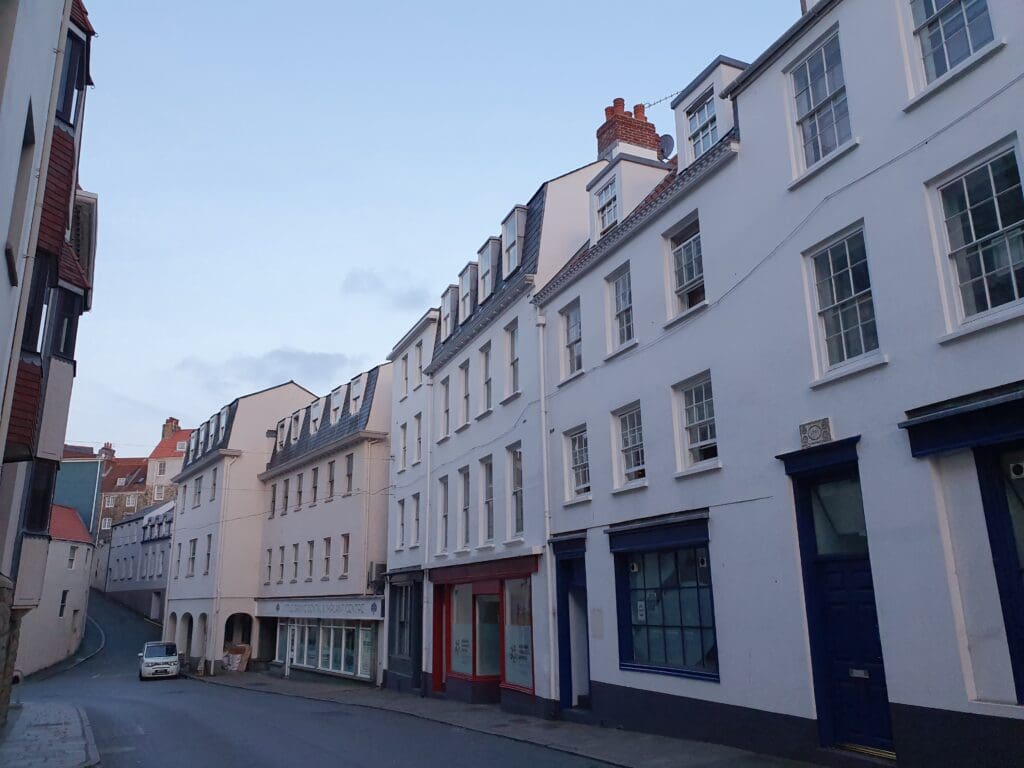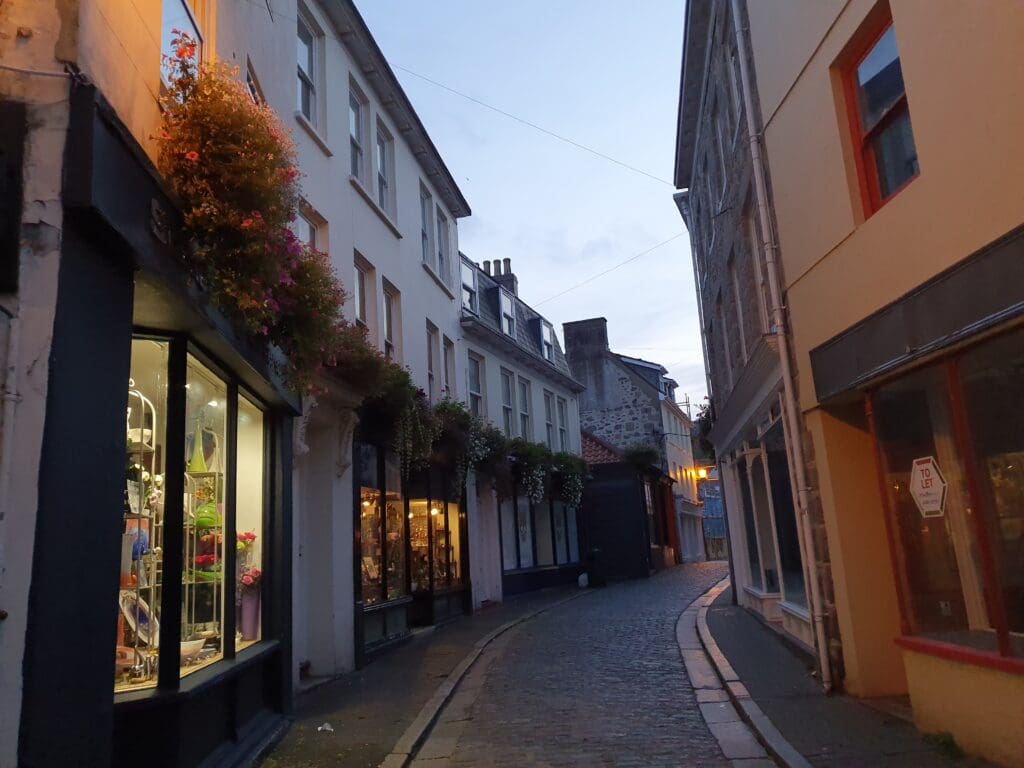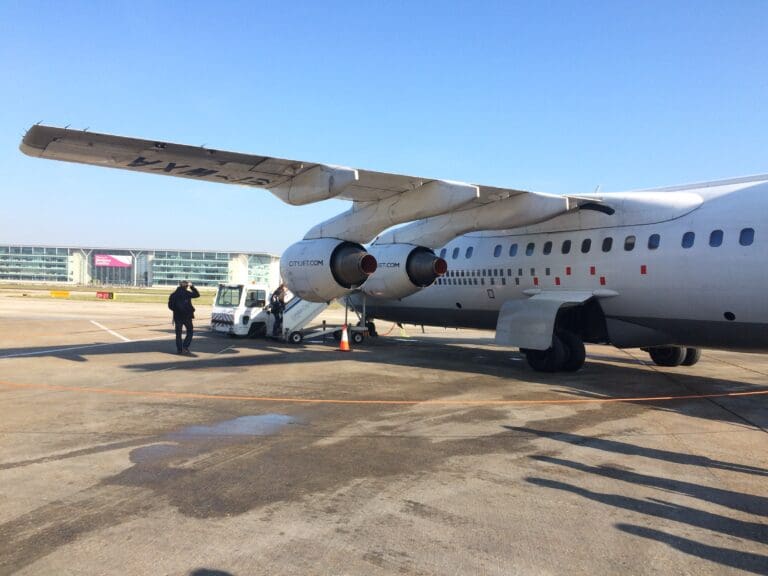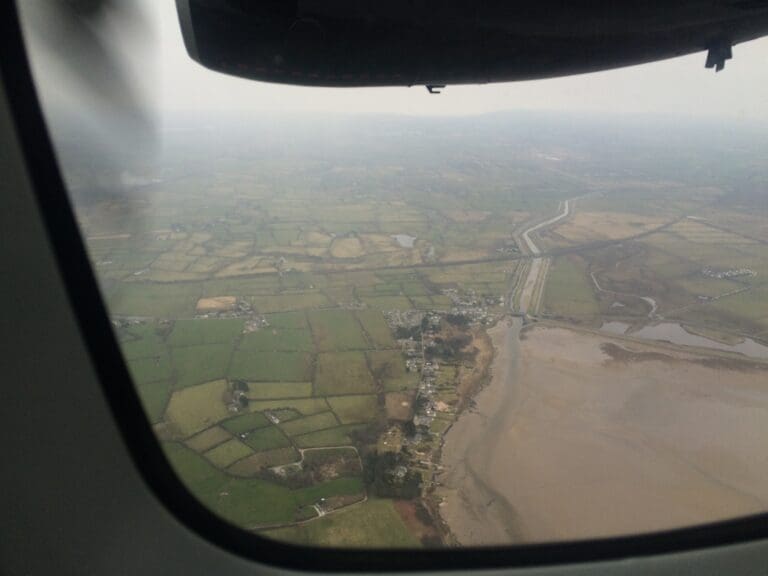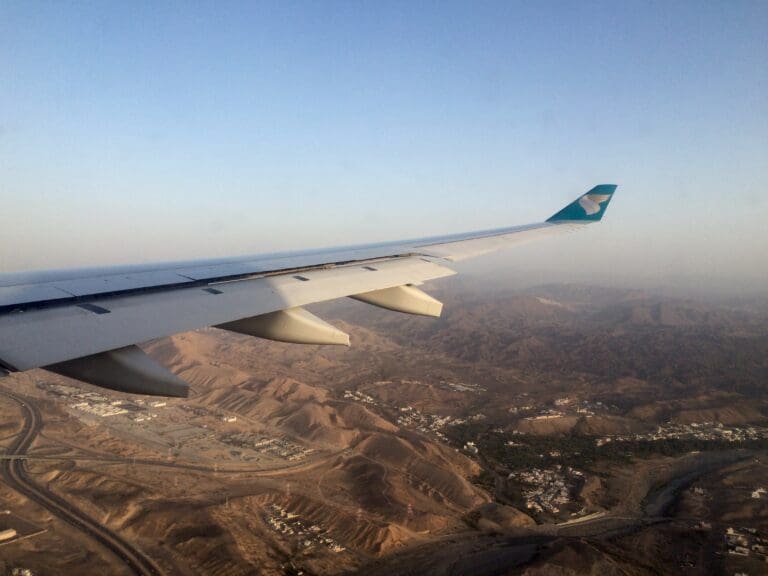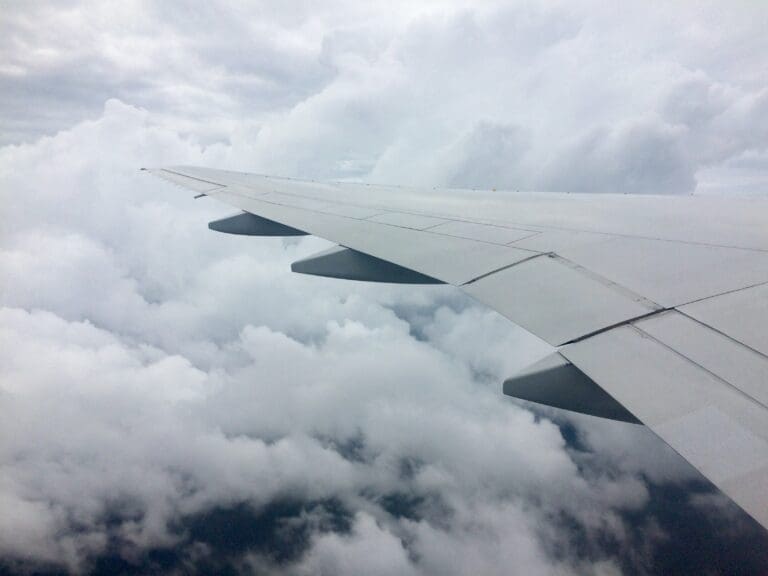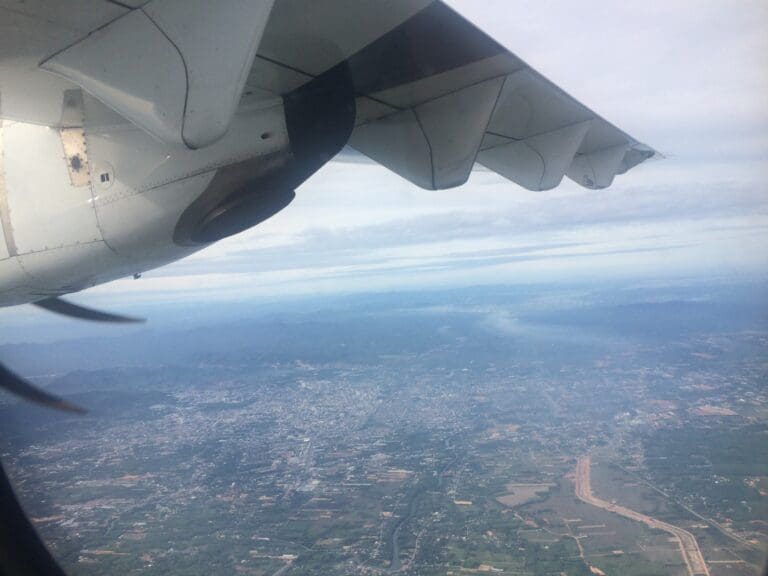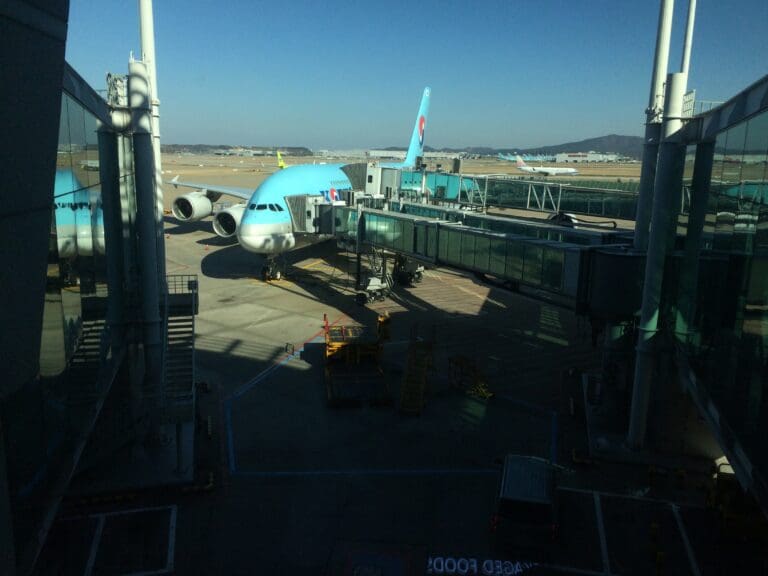An Alderney Adventure: Sampling Aurigny’s Dornier 228s
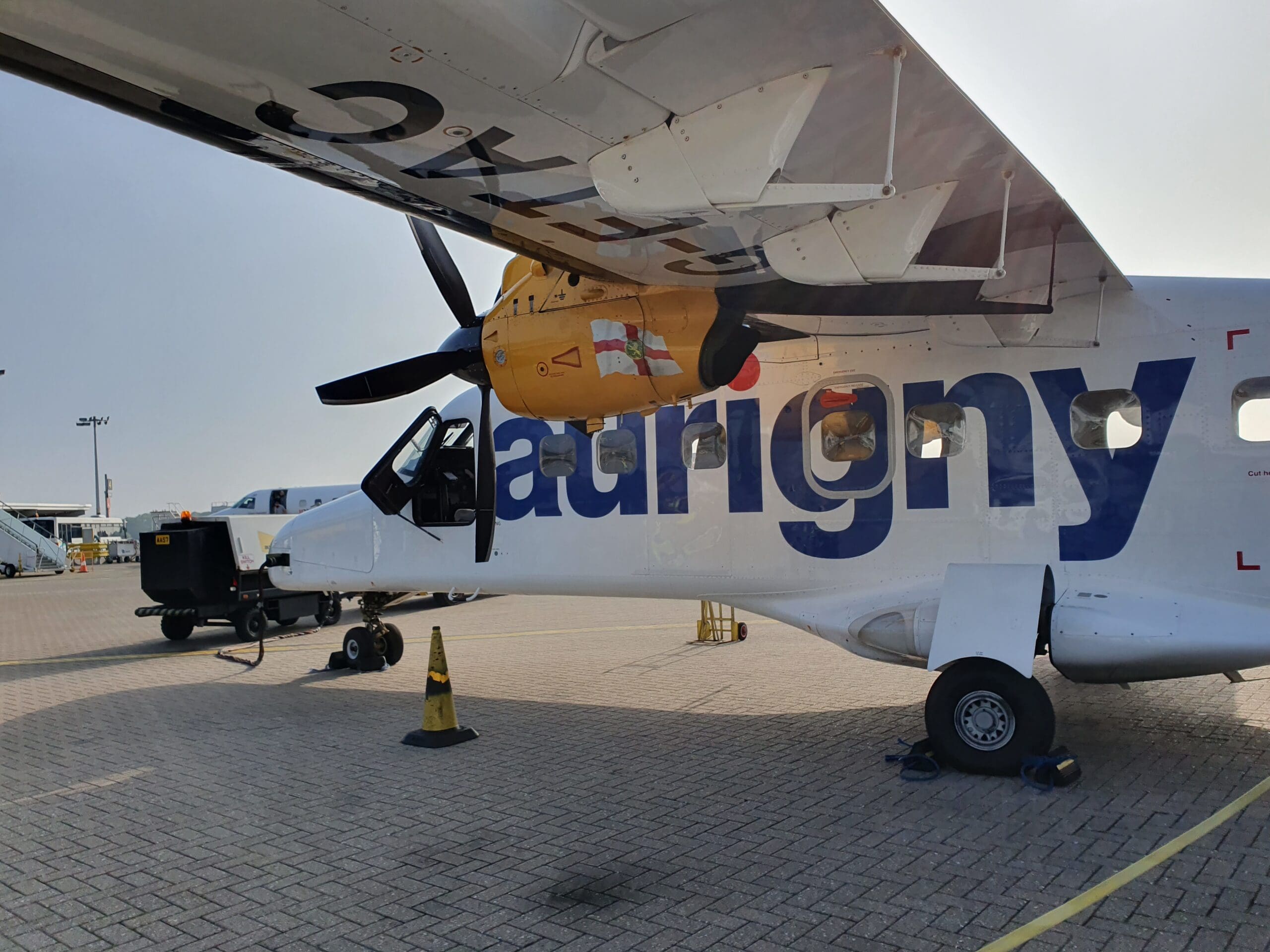
Background
With its sole base located at Guernsey Airport, today Aurigny is synonymous with this island. However, the airline came into existence in 1968 to serve the small island of Alderney following the withdrawal of British United Airways’ services. In fact, ‘Aurigny’ serves as Alderney’s French name, with the island sitting just ten miles to the west of Normandy’s coastline. Since being established, Aurigny has served Alderney with minimal interruption, deploying small Britten-Norman piston engined aircraft between the island and Guernsey as well as across the Channel to the UK. Initially, these took the form of Islanders and the rare and unusually shaped tri-engined Trislanders, before the latter finally bowed out of service in Spring 2017. Unfortunately, I missed the opportunity to sample a flight on these rare aircraft; however, to my delight, their replacement took the form of another relatively rare aircraft – the Dornier 228. Today, these connect Alderney with Guernsey and Southampton. With international travel fraught with restrictions and uncertainty, in 2021 I decided to finally make a weekend trip down to Alderney. After some experimenting, I settled on an itinerary that would see me fly down from Southampton and spend several hours on Alderney, before hopping to Guernsey where I would spend the night. The next afternoon I would then return to London, flying to Gatwick onboard Aurigny’s only Embraer 195.
Booking
As is occasionally the case with regional airlines, at the time of booking I found Aurigny to lack any sort of app. Despite this, I found no benefit to not booking directly with the airline and thus with a card in hand, I hopped over to Aurigny’s website. Upon landing on the homepage of the bright and modern, yellow and white website, I was presented with an advertisement for Aurigny’s then-recently announced service between Guernsey and Dublin, as well as the flight search engine.
Whilst the flight search engine allowed for return, single and multi-leg flights, for some reason Alderney was incompatible with the latter option. Therefore, I was required to book each flight separately. After entering the relevant details I was presented with a choice of that Saturday’s three options between Southampton and Alderney. These consisted of a morning and afternoon direct service, as well as a slightly more expensive single-stop option in Guernsey, with the first flight operated by a Blue Islands ATR. Once I selected the morning option, I was presented with two straightforward fares and a comparative analysis of what each entailed – Lowest Fare for £85.99 and Flexible Fare for £157.49. Seeing as I was booking in early July 2021 and therefore still covered by Aurigny’s ‘Book with Confidence’ scheme, allowing me to cancel my booking in exchange for a voucher, I did not see any massive benefit to paying almost twice as much for a flexible fare.
Once I selected this fare, I was then presented with a seat map where all seats were priced at an acceptable £3.00. Whilst I had hoped for Seat 1A, unfortunately, this was unselectable and so I was left to settle with Seat 3A. Once done, I then entered my details and was presented with a summary of my booking before I went ahead and made payment. After that, I then repeated the process for the shorter flight from Alderney to Guernsey – selecting the second to last flight of the five on offer that day. Moving onwards, I noticed that the cheapest fare afforded some additional privileges when compared to the Southampton flight, namely the option to carry 20kg of hold luggage as opposed to 15kg, as well as the option to change flights on the day. In addition, seats on this sector could be selected for an impressive sum of £1.00 and so I opted to pay to reserve Seat 6C, bringing the total fare for this sector to £50.99.
To complete my trio of bookings with Aurigny, once I had successfully booked the two Dornier flights, I proceeded to search for flights back to London for the following day. Once all the relevant details had been entered into the search engine, I was presented with an impressive total of four flights between Guernsey and London departing at various times during the day – all operated by Aurigny’s Embraer 195 aircraft. After selecting the 1440 departure, I was presented with three different fare classes, interestingly bearing a different name to those I was offered for the Dornier services. These were Light, Smart and Flexi. Being a budget traveller, I selected the Light fare for £55.99 and then headed over to the seat selection page where seats were priced at £12.00, £7.50 and £3.50. In the end, I couldn’t resist the temptation to select these and ended up opting for 20F. As with the other flights, payment was quick and easy and I was soon all set to head off to the Channel Islands.
Southampton to Alderney
Enjoying its own station on the main railway line between London Waterloo and Southampton, reaching Southampton Airport from London is not an overly arduous task. South Western Railway services plough this route at regular intervals and make the journey to and from the capital in a little over an hour. With this considered, whilst Southampton Airport can hardly be seen as a ‘London’ airport, for many Londoners, this proves just as easy to reach as Southend or Stansted. Thus, upon booking my flight from Southampton, I had assumed that I would face little issue in reaching Southampton Airport from West London in good time for my flight’s 1055 departure.
However, I had inadvertently opted to travel on a day when the line between London and Southampton would be blocked between Woking and Basingstoke due to scheduled engineering works – with a rail replacement bus service operating between the two. With this considered, the plethora of rail departures was reduced to one. This involved departing London Waterloo on South Western Railway’s 0530 service to Woking. From there, I would then have a quick change onto a rail replacement bus service which would shuttle me over to Basingstoke. Then, following another short connection, I would catch a train down to Southampton Airport Parkway at 0747. With no other option other than to travel down the night before and splurge out on a hotel, I decided to go for the economical option, paying a total of £6.05 for this trek across Hampshire.
In the week before my trip down to the Channel Islands, I had ended up having a very hectic few days. Not only was I bogged down with my usual duties in the office, I had a successful job interview and also spent some time finalising my plans for my trip to Canada. Having plenty to sort out once home from work on Friday evening, fuelled by coffee I ended up going all out and sleeping for a grand total of fifteen minutes. Once all my work was done, I then began my last minute trip preparations, had a quick shower and a light breakfast before leaving my shared house in West Acton at the early hour of 0320. Unfortunately, with the Night Tube still suspended, reaching Waterloo in the early morning was also quite a slog, and with no other options were I to miss the 0530 train to Woking, I had to give myself plenty of time.
From my house, I made a brisk walk along the deserted and very chilly streets, soon arriving at a bus stop near Ealing Common Station. Fortunately, I only ended up waiting around a minute or so before the Oxford Circus bound night bus appeared and whisked me off, zigzagging through West London suburbia which became more and more grand as we edged towards Central London. Whilst this journey would take quite some time during the day, seeing as the bus driver did not have to contend with a great number of fellow road users at that time in the morning, the bus pulled up to Selfridges around 25 minutes later where I disembarked with the intention of catching another bus to Waterloo. With the first small portion of the journey having gone to plan, I was left with plenty of time on my hands and so after disembarking the bus, I decided to journey across Central London to Waterloo on foot. During this, I trundled through a mixture of bustling and busy streets filled with drunken revellers beginning to make their journeys home, to eerily dark and quiet backstreets. After elongating my route as much as I possibly could, my lack of a coat ensured that the morning cold eventually got the better of me and at 0500 I retreated to a bench inside a surprisingly quiet Waterloo Station.
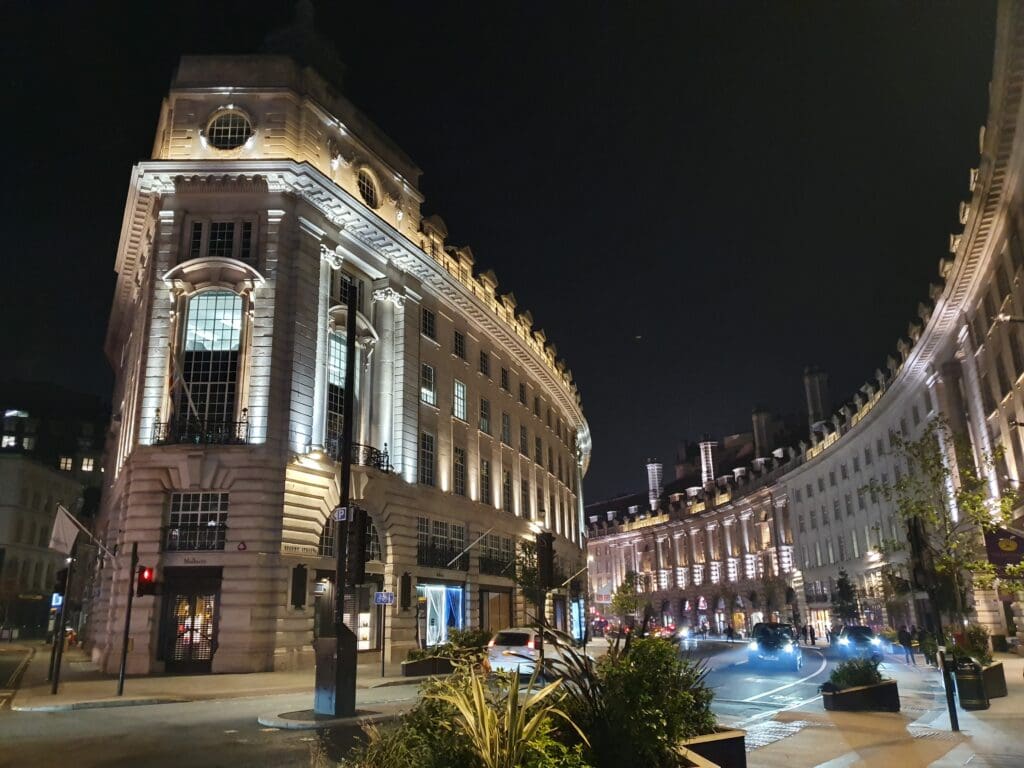
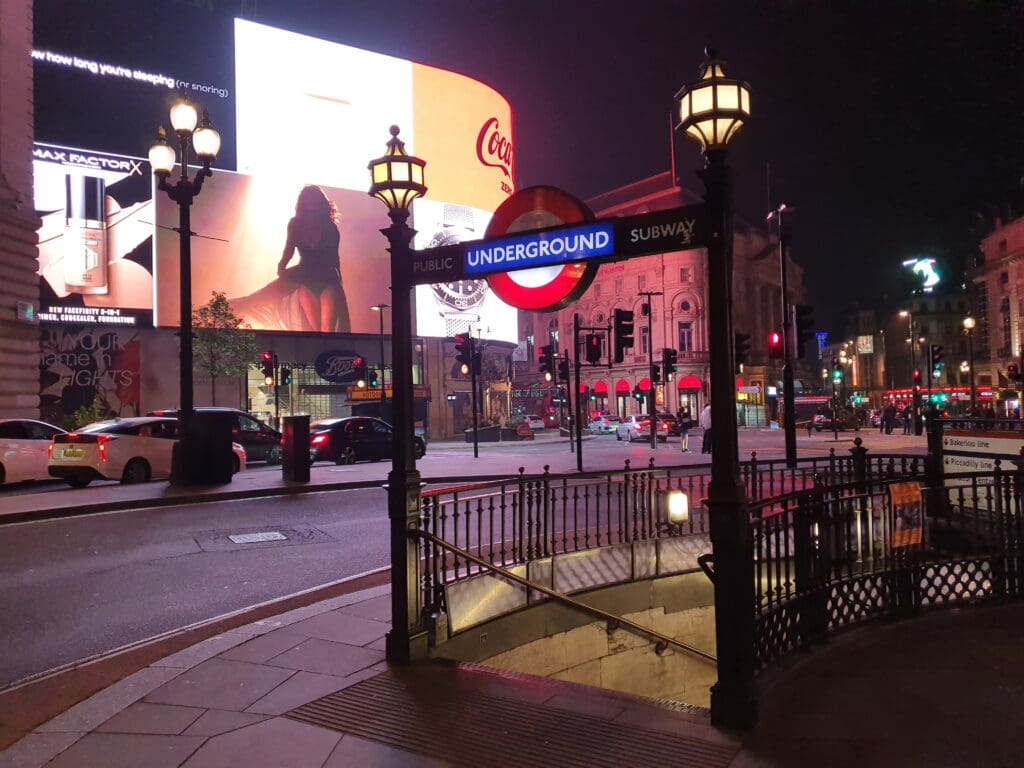
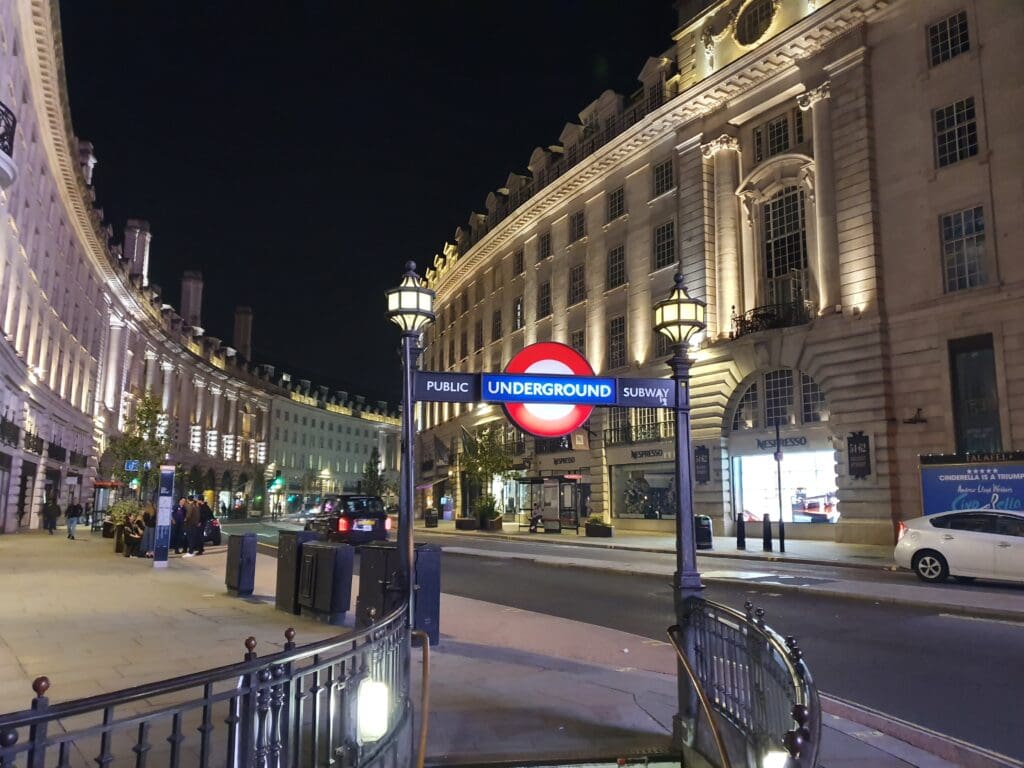
Around fifteen minutes after arriving at the station, the departure boards updated and revealed the platform from where the train bound for Woking would depart and I wasted no time in making my way over to the awaiting eight-carriage Class 450 train. Considering how empty Waterloo Station was that morning, I was not greatly surprised to see that I ended up with a whole carriage to myself as the train pulled away from Waterloo. Perhaps more surprising was the fact that nobody joined the carriage at any of the intermediate stops – Clapham Junction, Wimbledon and Surbiton. Getting the journey off to a good start, the train pulled into Woking on time and I followed signs for the car park in the hope that either a bus would be waiting or staff members would be on hand to provide further instructions. Fortunately the former was the case and I boarded this, ready for the middle portion of the journey. Following a slightly cramped trip onboard an icy cold coach, the bus pulled into Basingstoke Station on time allowing me enough time to grab a coffee before catching the final train down to Southampton Airport. This final portion of the trip went without a glitch and I ended up arriving at the station on time at 0747.
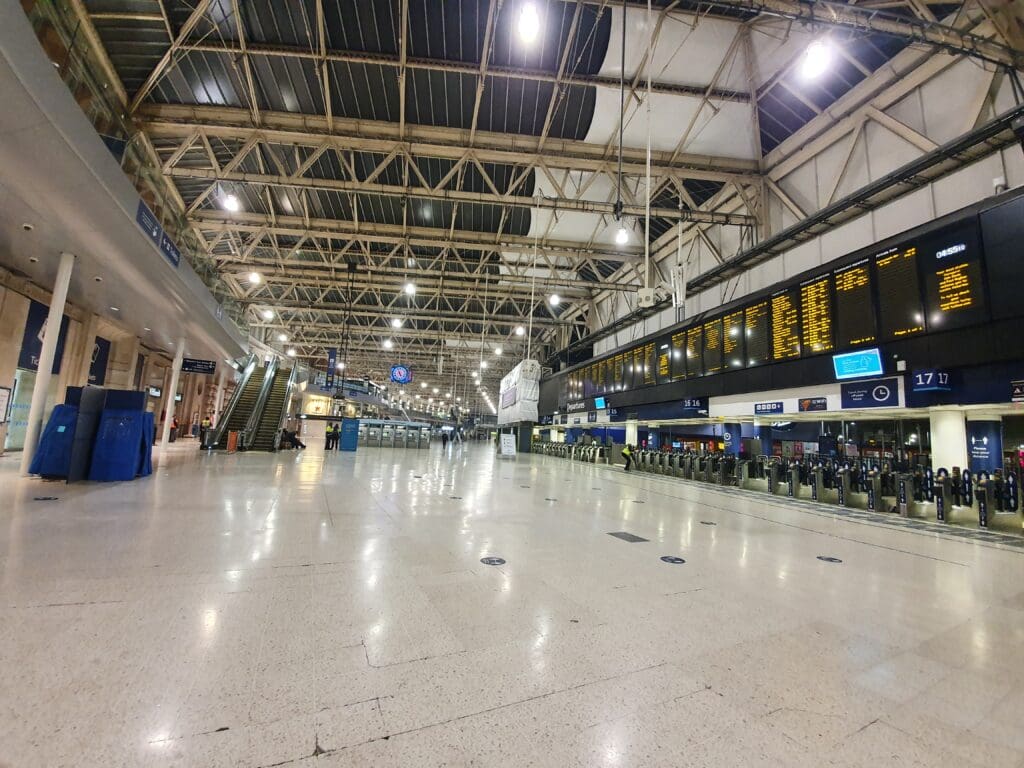
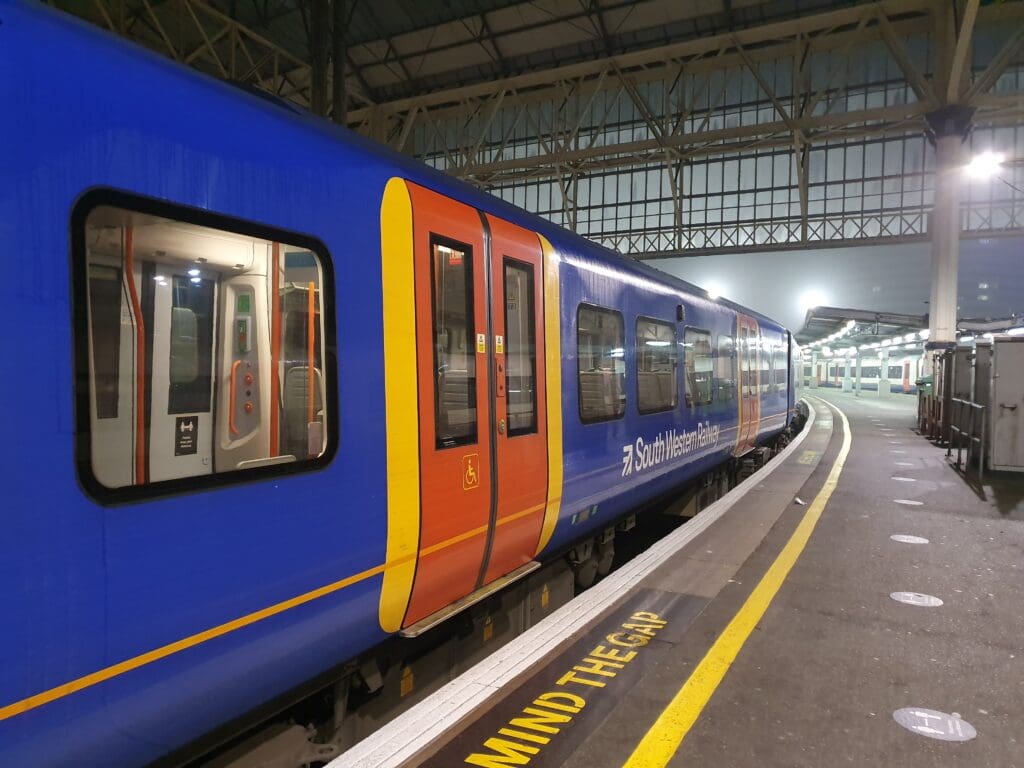
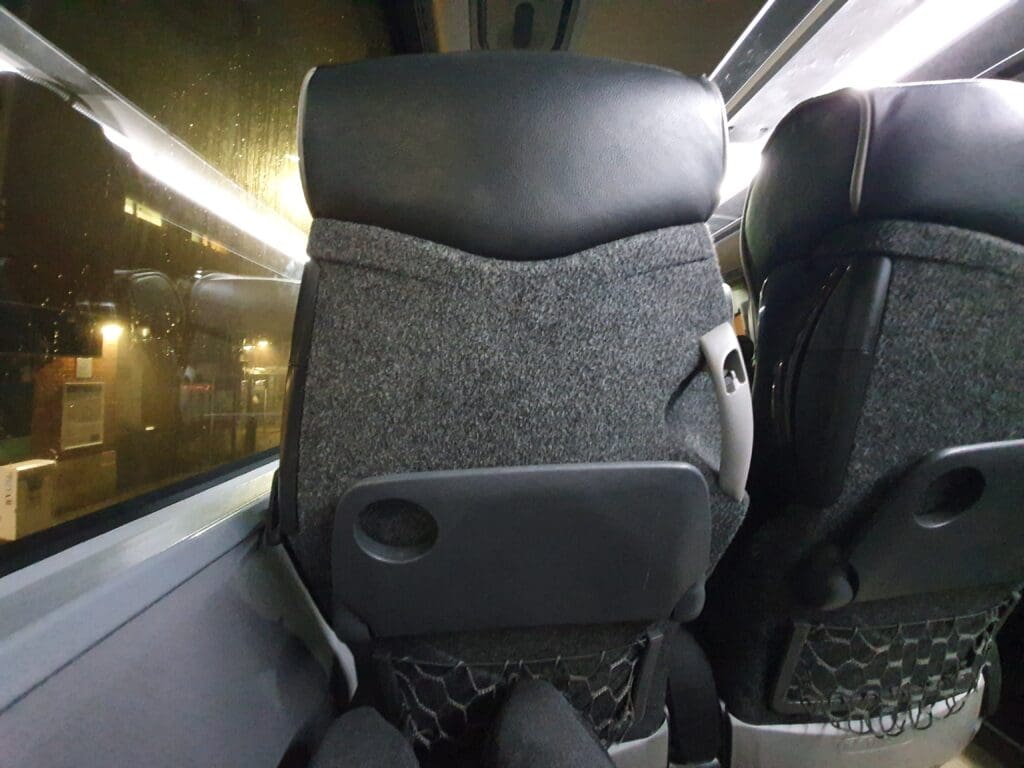
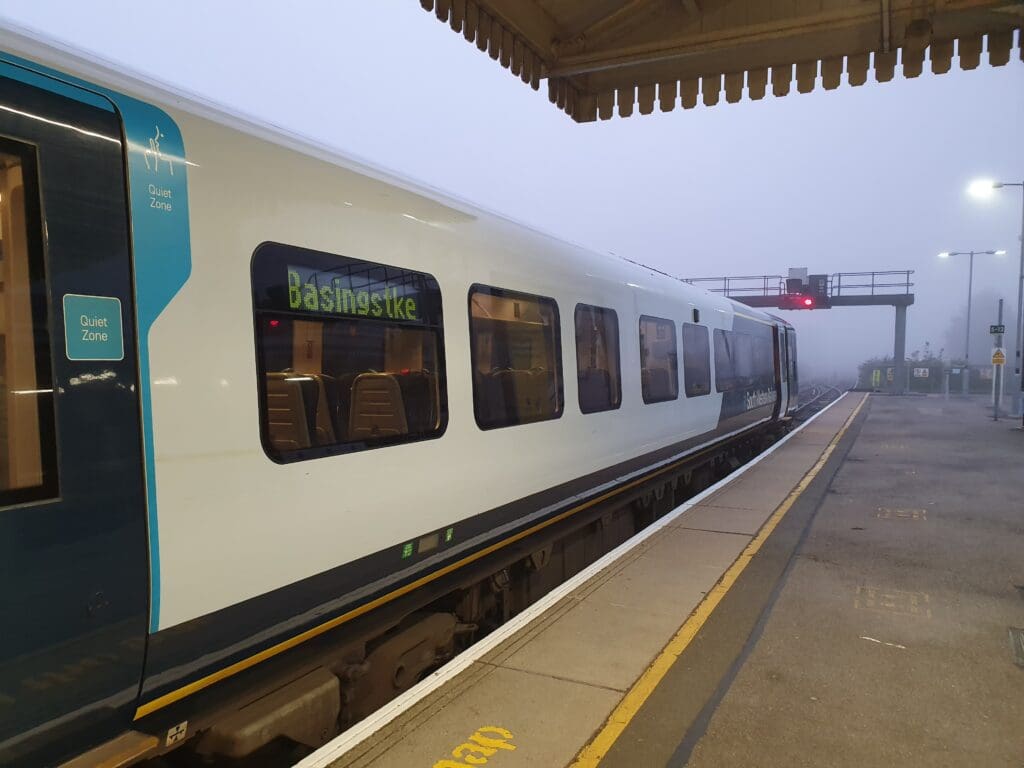
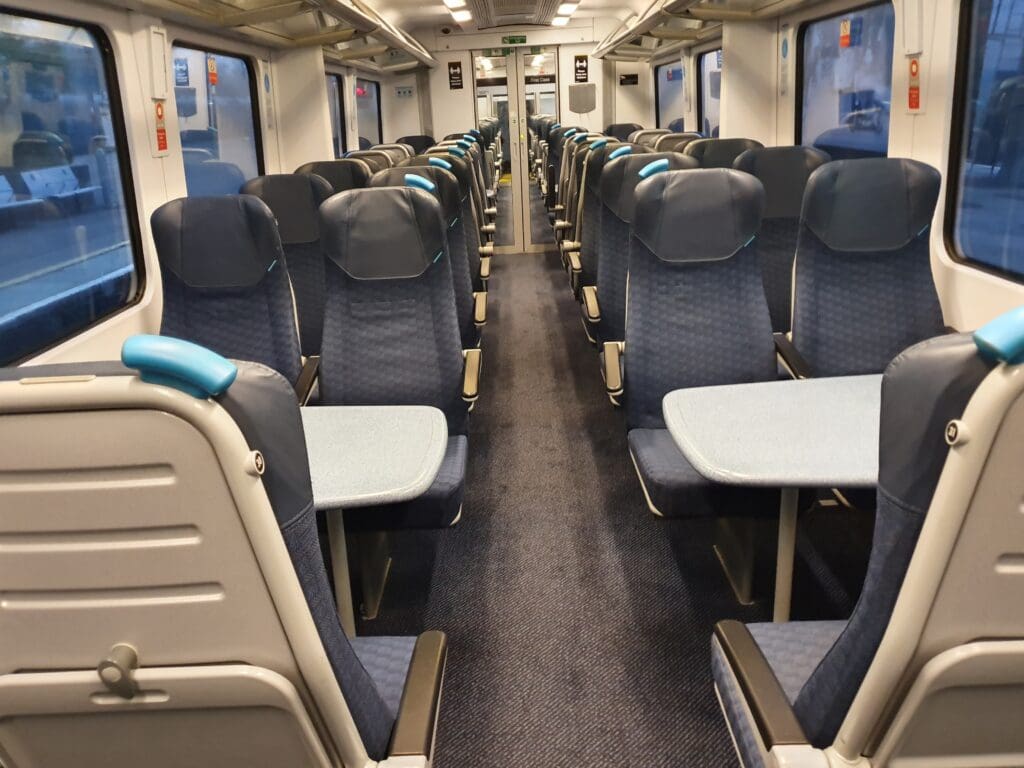
Clearly indicating that I had arrived at the airport, as I stepped down onto the platform from the Class 440 train, a BA CityFlyer Embraer 190 could be seen and heard rising into the morning fog as it commenced its journey down to Alicante. Since my previous journey through Southampton Airport in September 2020, BA CityFlyer had commenced operating several leisure routes from the airport to fill the weekend downtime of their London City based jets. This was the second of the carrier’s two Spanish departures that morning, with this immediately preceded by a flight to the White Island, Ibiza. Reaching the airport terminal from Southampton Airport Parkway Station could not be more convenient and within about a minute of stepping off the train, I found myself entering the airport’s small passenger terminal.
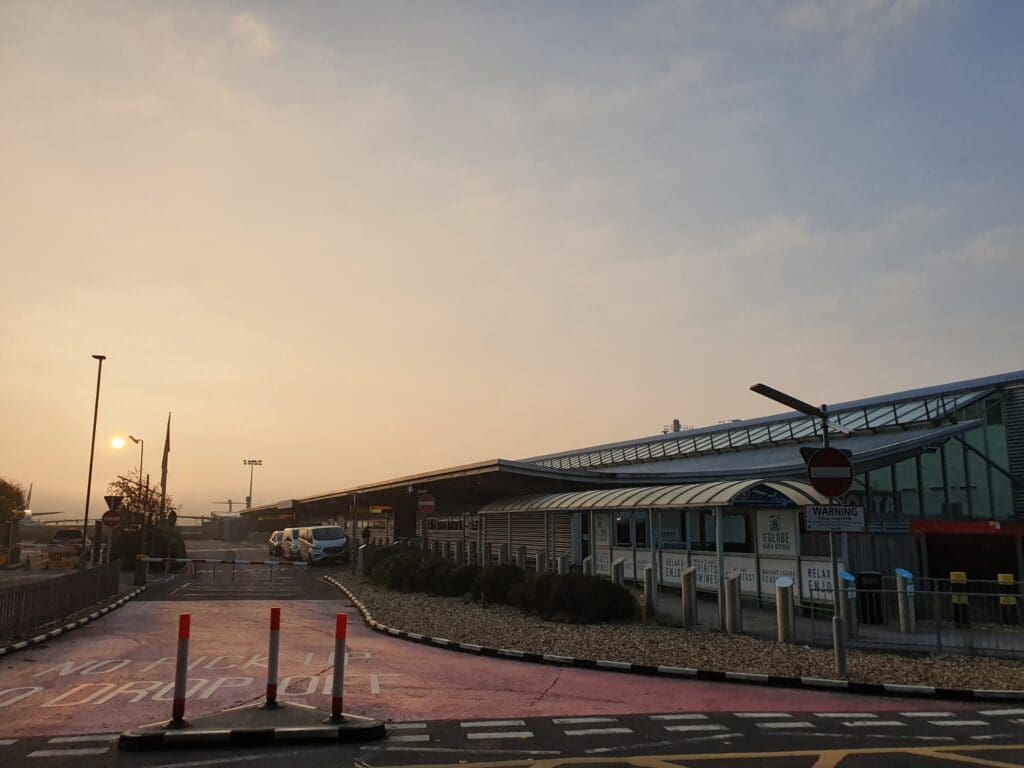
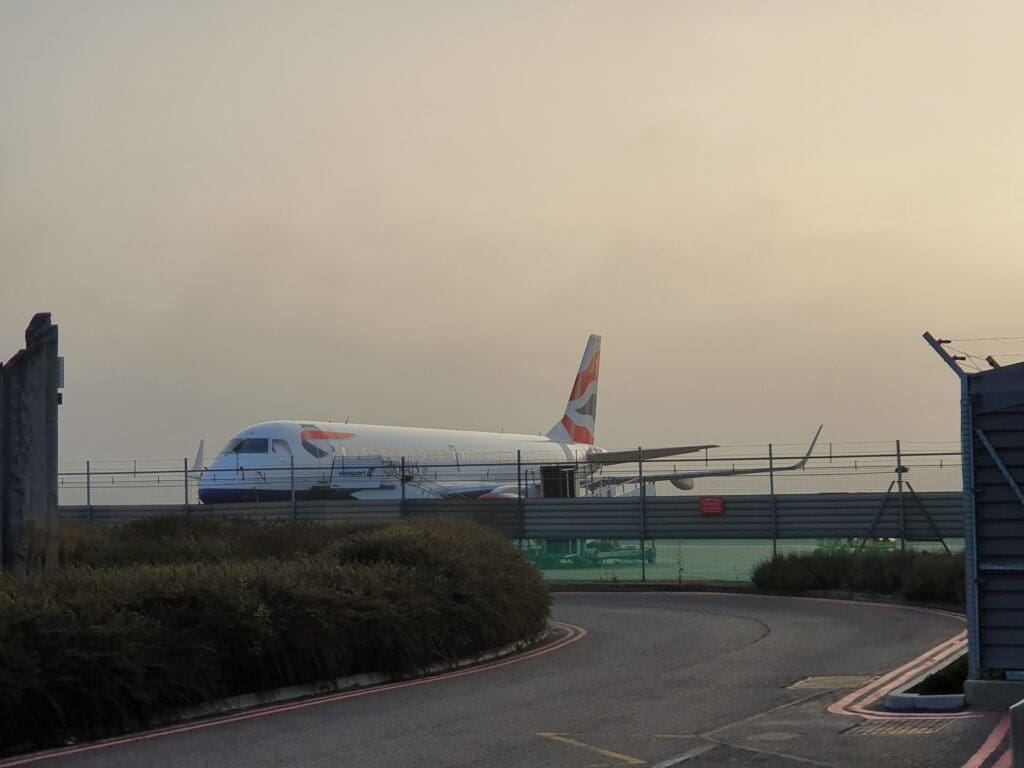
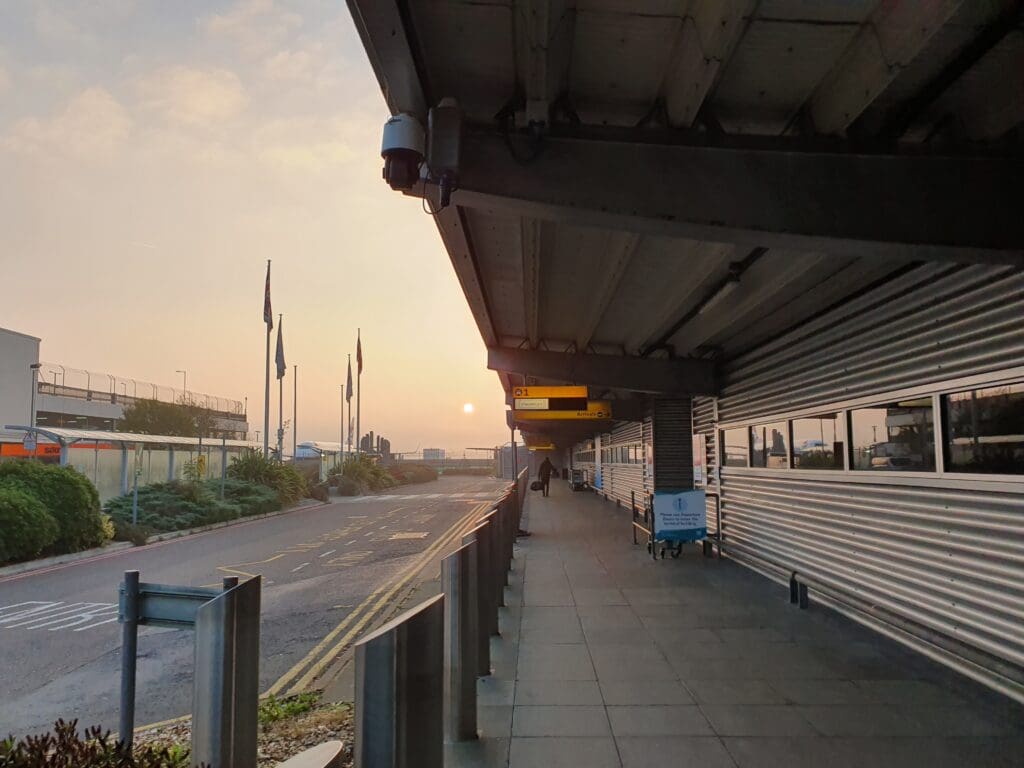
From the outside, Southampton Airport’s terminal appears modern yet also somewhat nondescript and similar in style to the terminals of several other small British regional airports. Covered in silver-coloured metal panelling and with few windows on the landside side portion of the terminal, this does bear a slight resemblance to a modern motorway service station. However, on the inside, this is bright, clean, modern, spacious and ultimately very pleasant. This consists of a large hall with check-in desks at one end and the arrivals area at the other, offering a bar-restaurant, bureau de change, Costa Coffee and a branch of WHSmiths, although only the very latter was open at that time in the morning. In addition, a selection of vending machines selling snacks, hot and cold drinks and travel essentials could also be seen dotted about through the terminal. Despite there being seven flights set to depart that morning, the landside portion of the terminal was slightly quiet, with plenty of places to sit and wait. For those wanting to pass the time, complimentary wifi is offered which I found to work well, and a smattering of plug sockets could also be found for passengers to use.
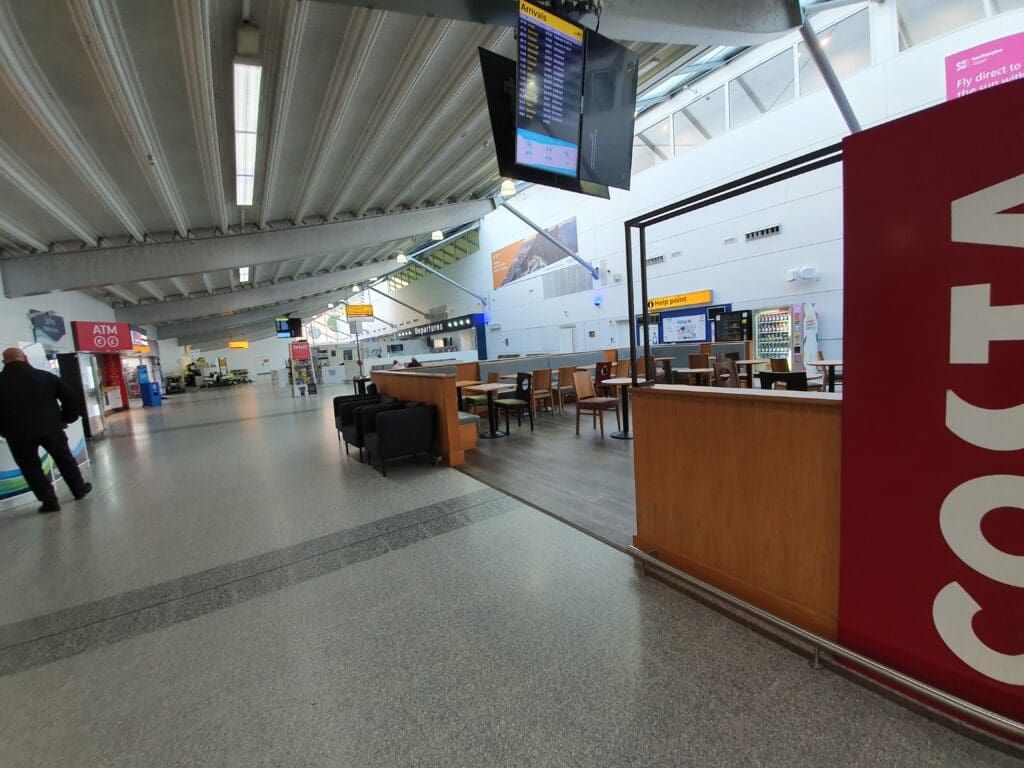
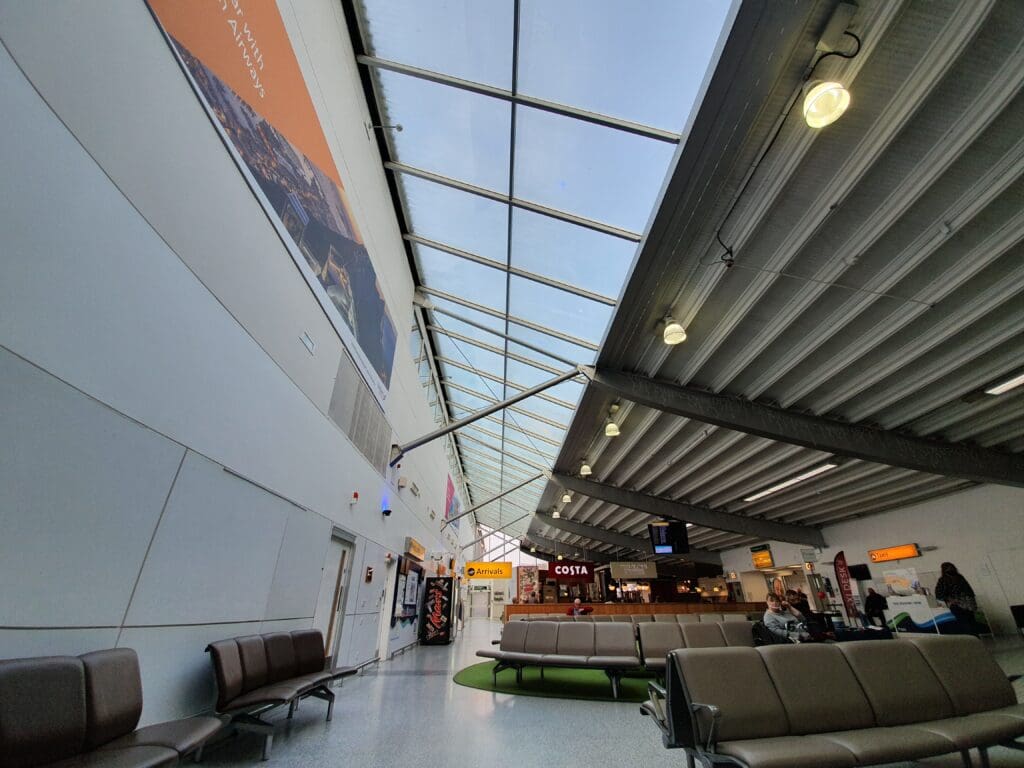
For those heading off, a total of seventeen check-in desks can be found in the northernmost section of the landside hall, whilst two automated check-in machines could also be seen, lthough these were both switched off. Whilst those flying onboard services operated by Aurigny’s ATR 72 and Embraer fleet can check-in online, this cannot be done for those heading off on the smallest member of Aurigny’s fleet, the Dornier 228. With this considered, I had little choice but to sit and wait in the landside area until check-in for the Alderney flight opened, which, according to the departure boards, would occur at 0925.
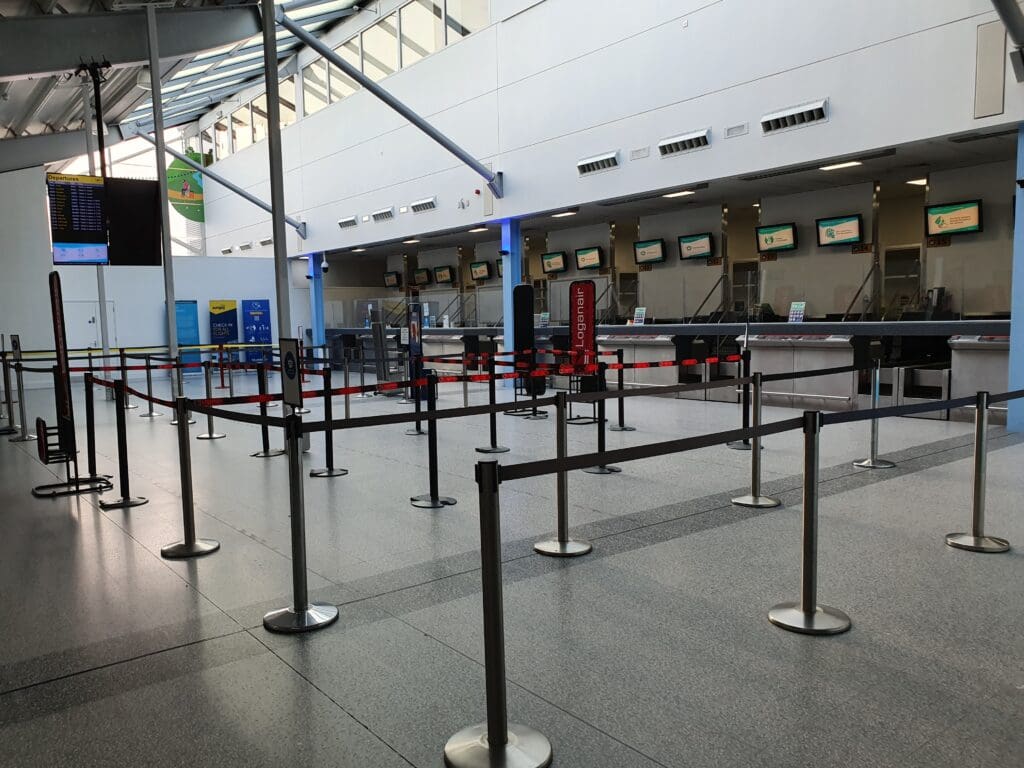
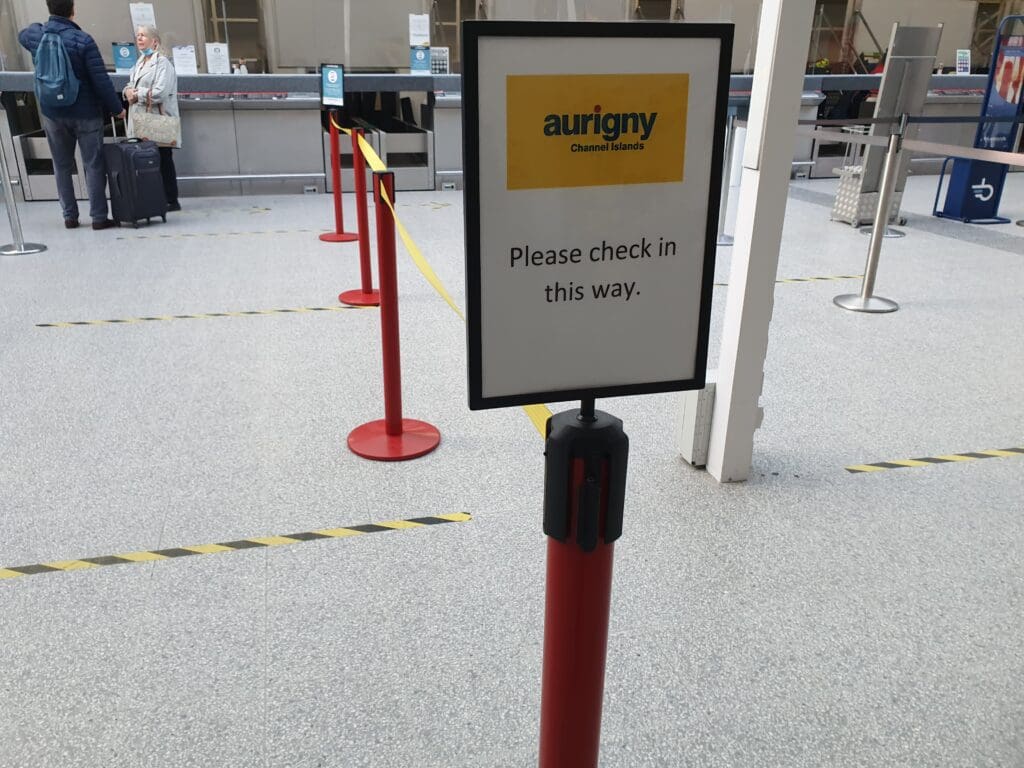
As I sat and waited for check-in to commence, I couldn’t help but notice that the low-lying fog was causing some issues at the airport that morning. This had resulted in a Blue Islands ATR 72 from Jersey and an Aurigny ATR 72 from Guernsey entering long holds, with these both touching down after spending almost twice their scheduled flight times in the air. Meanwhile, announcements rang out advising passengers that Loganair’s services to Edinburgh and Glasgow, and Blue Islands’ flight to Jersey would be delayed. Nevertheless, with the fog soon set to clear and having a couple of hours to go until my flight’s scheduled departure time, I was not particularly worried about a potential delay. Although, as the scheduled check-in time neared, an announcement was made informing all Alderney bound passengers that check-in for the flight would be delayed.
Waiting on a comfortable bench near the check-in desks, I noticed an Aurigny agent appear at 0940 and soon open check-in for the flight to Alderney. Given Aurigny’s multiple daily services from Southampton to both Alderney and Guernsey, I was unsurprised to see that Aurigny has a fair amount of branded signage at the check-in desks, including two stuffed toy puffins sitting behind the check-in counter. Being third in the queue to check-in, whilst only one agent was present, it did not take too long before I was invited forward and welcomed by the incredibly friendly staff member who apologised for the delay and explained that he had been caught up in the airside area where he had been required to oversee the departure of the delayed Guernsey service. After handing over my driving licence, I was asked whether I would be happy to take an exit seat – having assumed that my preselected seat was an exit seat, I agreed to this and my boarding pass was printed off. This came in the form of a receipt-style pass – something that I had only previously seen on domestic services in Japan and Korea. Having wanted to sit in the first row, unfortunately neither Seat 1A or Seat 1C had been pre-selectable during booking, and so I was delighted to see that I had been shifted forward to 1C.
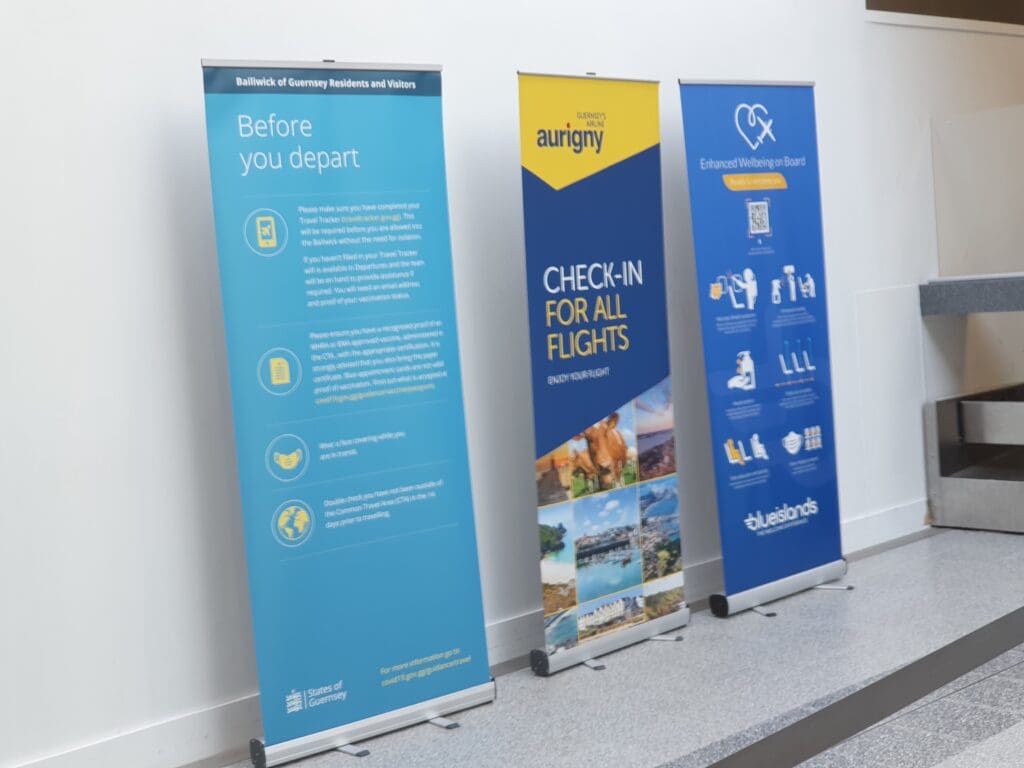

With my boarding pass in hand, I made my way over to the security area which at that time lacked any queue. Once there, I was greeted by another friendly staff member who scanned my boarding pass and pointed me in the direction of the sole checkpoint where I was given a warm and friendly greeting. Given the polite and friendly nature of the security staff, coupled with the speed and ease at which I was able to pass through security, I was left with a very good impression of the staff at Southampton Airport that morning. After making it through security, I headed onwards to the airport’s small duty free shop, which, as is often the case at British airports, must be passed through in order to reach the main waiting area. As a regional airport, Southampton Airport’s airside waiting area is fairly small and with passengers waiting to head off on four different flights, this was rather full at the time of my arrival. Nevertheless I did manage to find a seat and charge my phone.
Turning to the airside area’s facilities, this contains another branch of WHSmiths alongside a Costa Coffee, a bar-restaurant and a lounge as well as the usual vending machines. Aside from the wifi, passengers can pass the time by watching the large TVs – some of which were playing BBC News, whilst others were playing BBC1. For aviation enthusiasts, unlike in the landside area, some views of the action outside can be had from the airside portion of the terminal. However, totally unobstructed views are hard to come by and thus any good photos of the airport’s movements may be difficult to take. Whilst my experience at Southampton Airport that morning was largely positive, I do have a single complaint – the toilets in the airside area of the terminal were disappointingly dirty, especially when compared to those in the landside area.
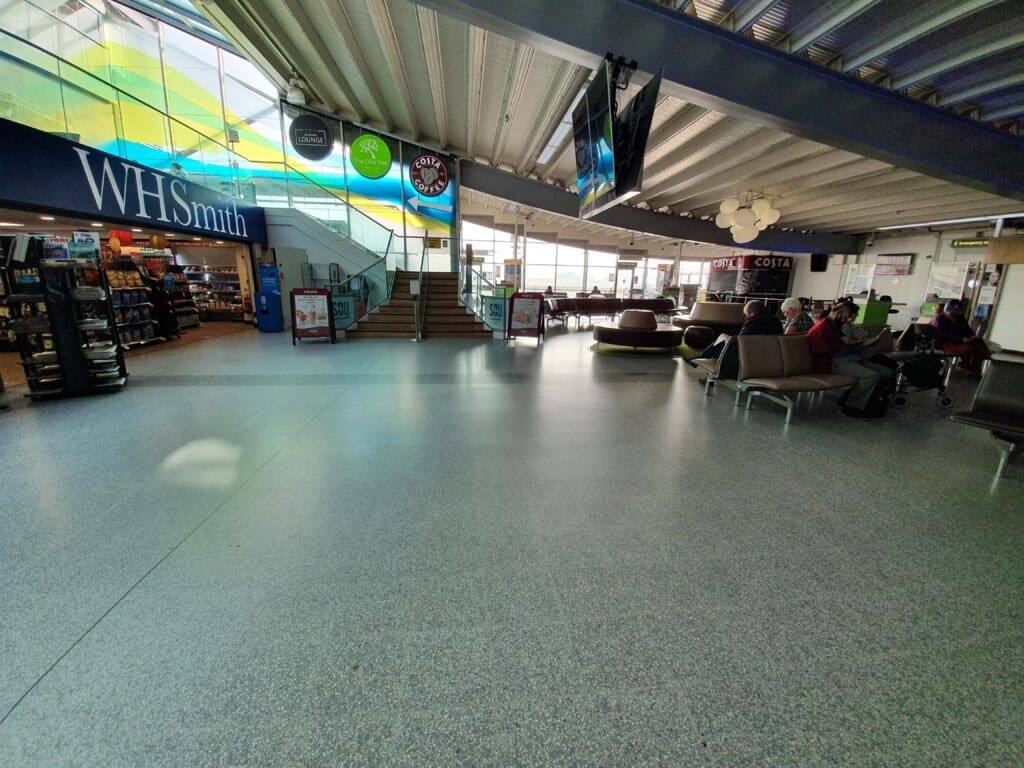
As I waited in the terminal, the first sign of action outside came in the form of the first of three Loganair Embraer 145 jets to land during my stay, with this arriving from Newcastle, with examples from Edinburgh and Glasgow joining this immediately after. However, the star movement of the morning arrived at 1022, when Dornier 228-212NG G-ETAC touched down at the end of its short flight from Alderney. Manufactured at RUAG Aerospace’s factory in the Bavarian town of Oberpfaffenhofen, this particular Dornier first took to the skies in 2018 and was delivered to Aurigny in September that year. Upon delivery, this relieved stop-gap ‘traditional’ Dornier 228 G-OMAF of its duties, joining the slightly older Dornier 228NG G-OAUR. Whilst the aircraft is not officially named, according to Aurigny’s website, the registration G-ETAC serves as a homage to Alderney’s Les Etacs rocks. In the week prior to my flight, the aircraft had conducted a grand total of 44 flights, shuttling between Alderney, Guernsey and Southampton, travelling an impressive total of over 2,000 miles during the course of these services.
Seeing as the inbound Dornier had touched down in Southampton three minutes prior to the Alderney flight’s scheduled boarding time, I was sceptical that this would commence on time. However, even if all nineteen seats onboard were taken, I was highly sceptical that it could possibly take an entire thirty minutes to get all passengers onboard the aircraft, seated and strapped in ready for departure. That said, at 1025 on the dot, the Aurigny agent’s voice filled the terminal and all Alderney bound passengers were invited to head over to gate 9 – located in the corner of the terminal. Upon arriving there, I noticed that a small flatscreen television had been rolled out, at which point it became clear that this early boarding time was to ensure that all passengers could be rounded up and shown the safety video prior to the flight. Before this was played, the agent tore each passenger’s boarding pass in half and gave a brief speech.
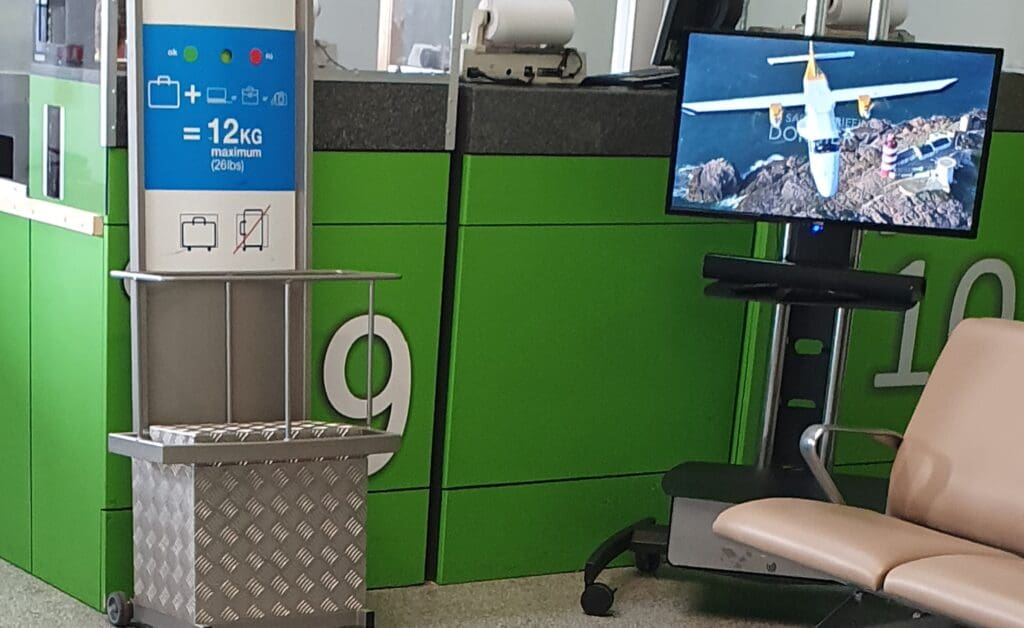
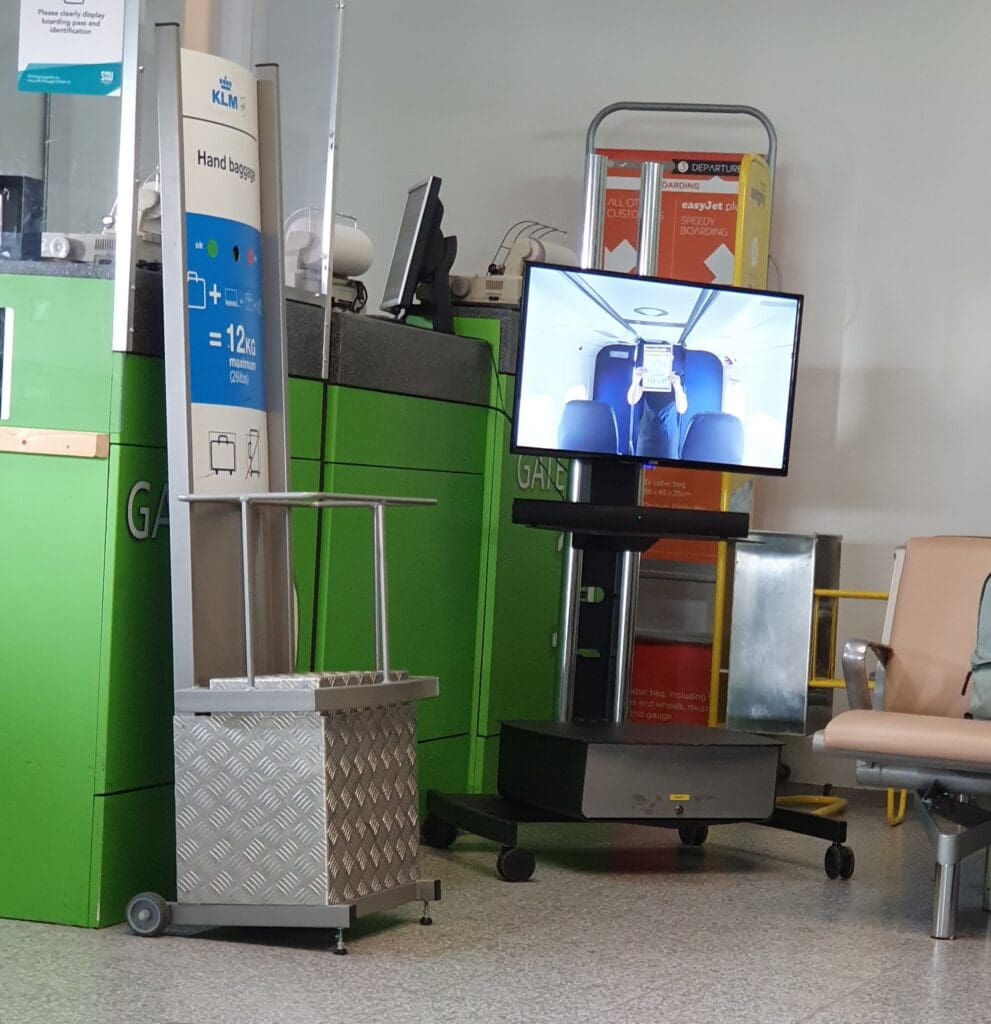
Once the short safety video came to an end, passengers were given the opportunity for a quick preflight pitstop in the bathroom. At 1039, Aurigny’s Southampton-based Duty Manager escorted passengers outside and led them over to Stand 2 where the shiny looking Dornier could be seen lotted in between an Eastern Airways ATR 72 and a Loganair Embraer 145. That morning, a grand total of seven passengers would be flying down to Alderney – three middle aged couples and me. As one may expect from a service that serves a small and somewhat remote community, whilst the three couples were not travelling together they did all seem to be Alderney residents that knew of one another. With this considered, whilst the Dornier 228 may be considered a ‘novel’ aircraft by many, these passengers were clearly used to the small airliner experience and thus I was the only one who snapped a few photos of the small aircraft before making my way onboard. Unlike Aurigny’s ATR and Embraer aircraft which feature ‘Channel Islands’ or ‘Guernsey’ at the rear of their fuselages and have the flag of Guernsey painted onto their engines, their Dornier 228s proudly sport the name ‘Alderney’ and feature the island’s flag on their engines, indicating the type’s role in connecting and supporting Alderney.

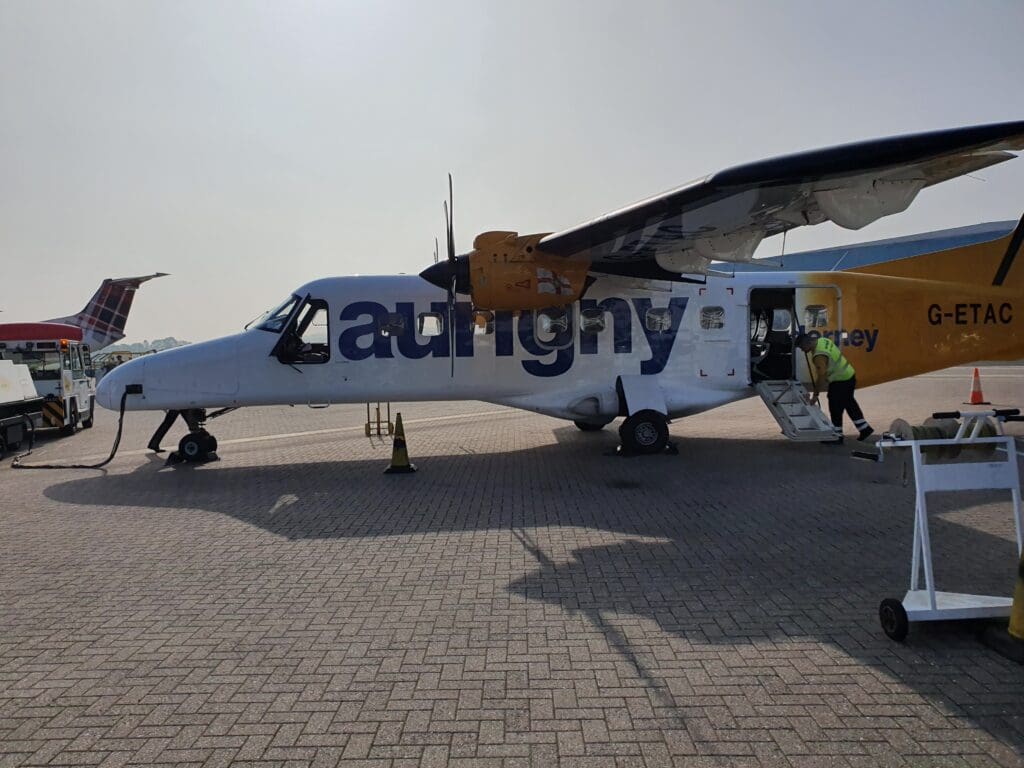
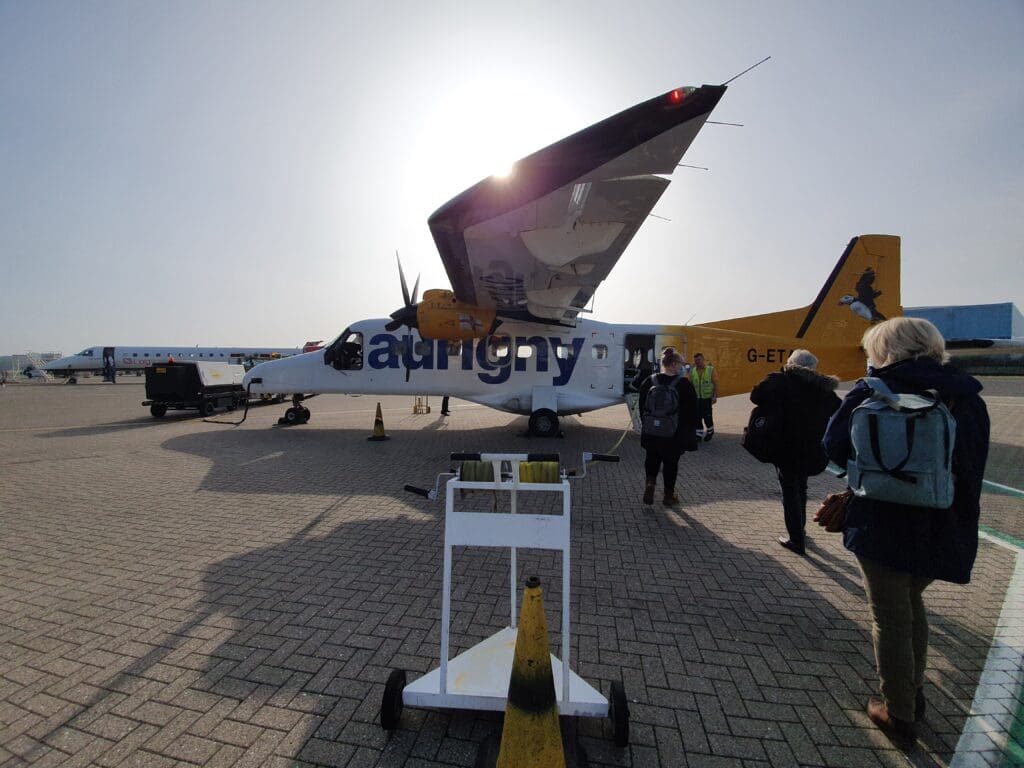

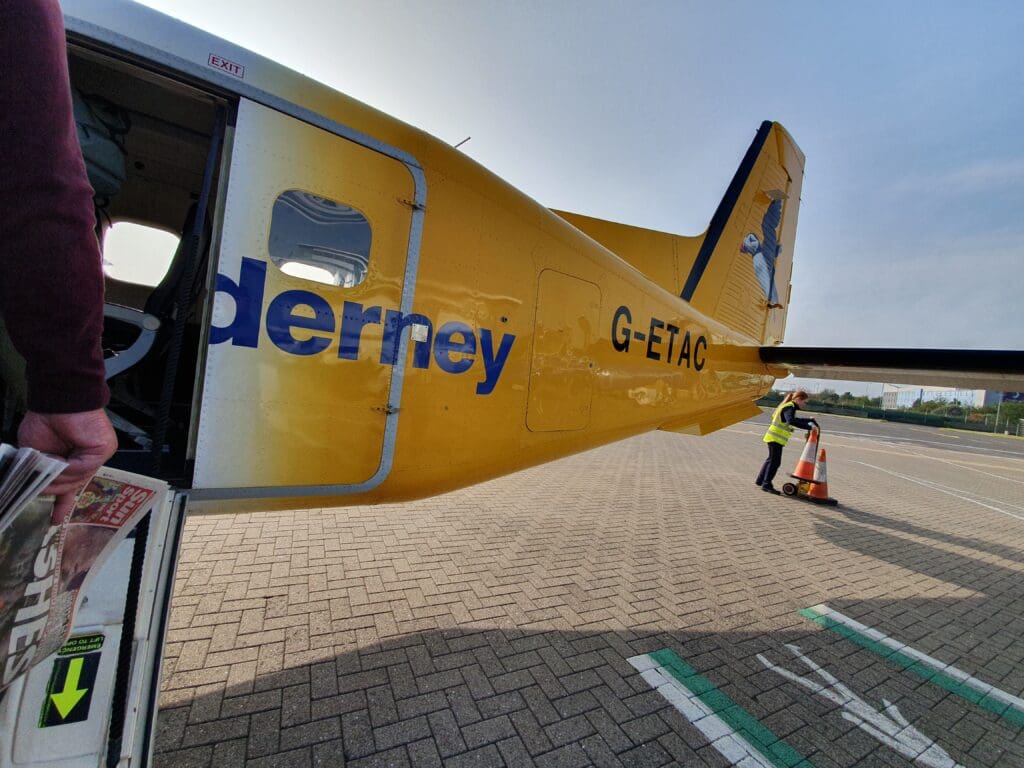
Once I had taken a few pictures and skirted around the Dornier’s pointed wingtip, I was advised to mind my head as I clambered up the five shallow steps that are built into the inward side of the cabin door before bending my head to avoid any pre-flight concussion on the 1.34 metre tall entryway. Inside the cabin, the headway improved a little although this was still fairly low and I continued to bend over slightly as I made my short journey up to the front of the aircraft. Onboard, each of the Dornier’s nineteen seats appears to be slim and modern, with each covered in a dark blue (faux?) leather and featuring a pocket with a safety card and a sickbag. As with many airlines, Aurigny has halted the paper publication of its inflight magazine, En Voyage, during the pandemic.

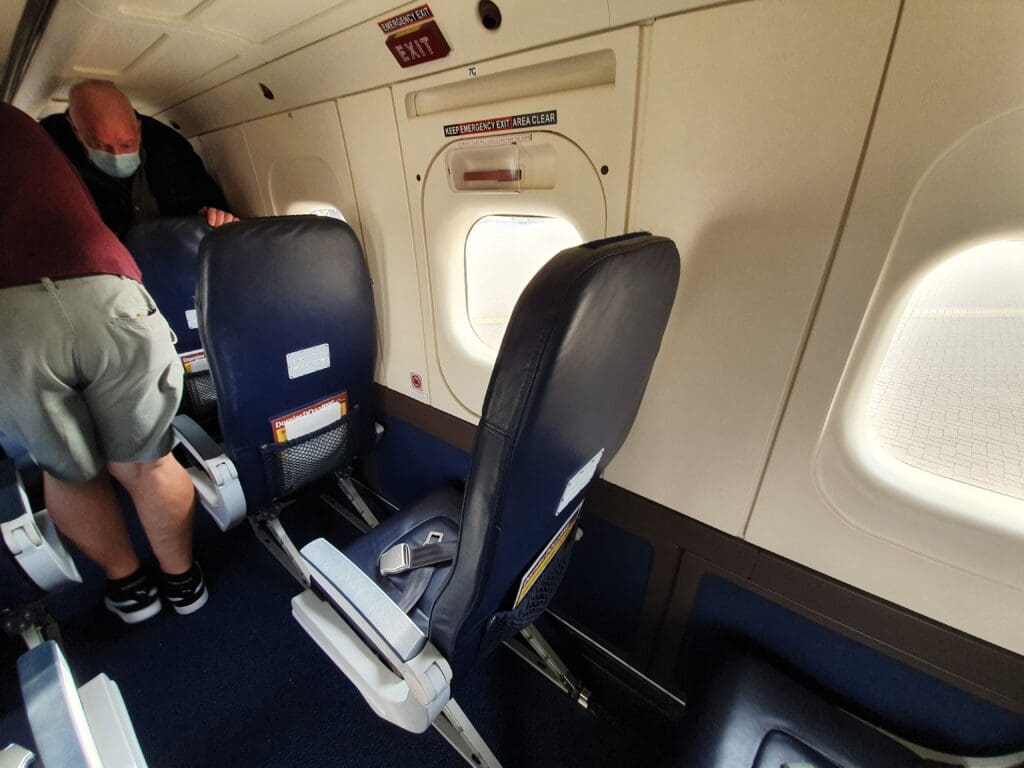
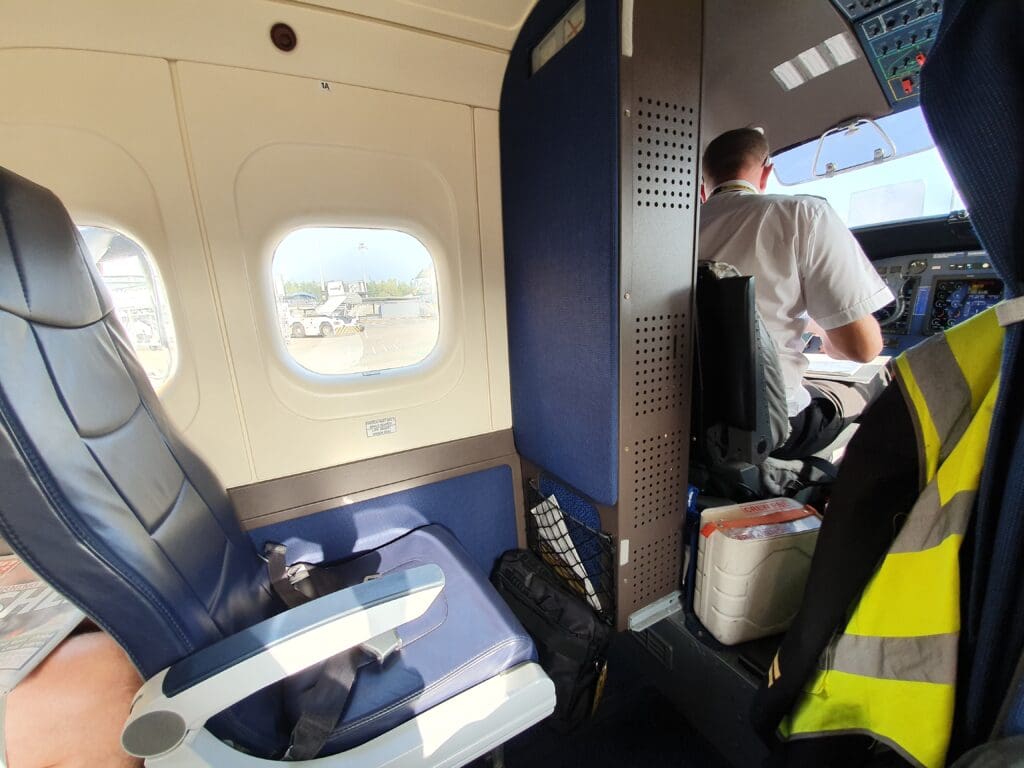
After taking my seat at the front of the aircraft, I was pleased to find this to be reasonably soft although the amount of legroom provided, in spite of my seat’s status as an exit row seat, was rather dire. Given the nature of their operations, STOL aircraft such as the Dornier 228 are not particularly known for their lack of scratches, marks, bruises and bumps in their cabins, however, this particular turboprop bucked the trend, with few signs of wear and tear. Furthermore, this appeared to be in a clean and tidy state.


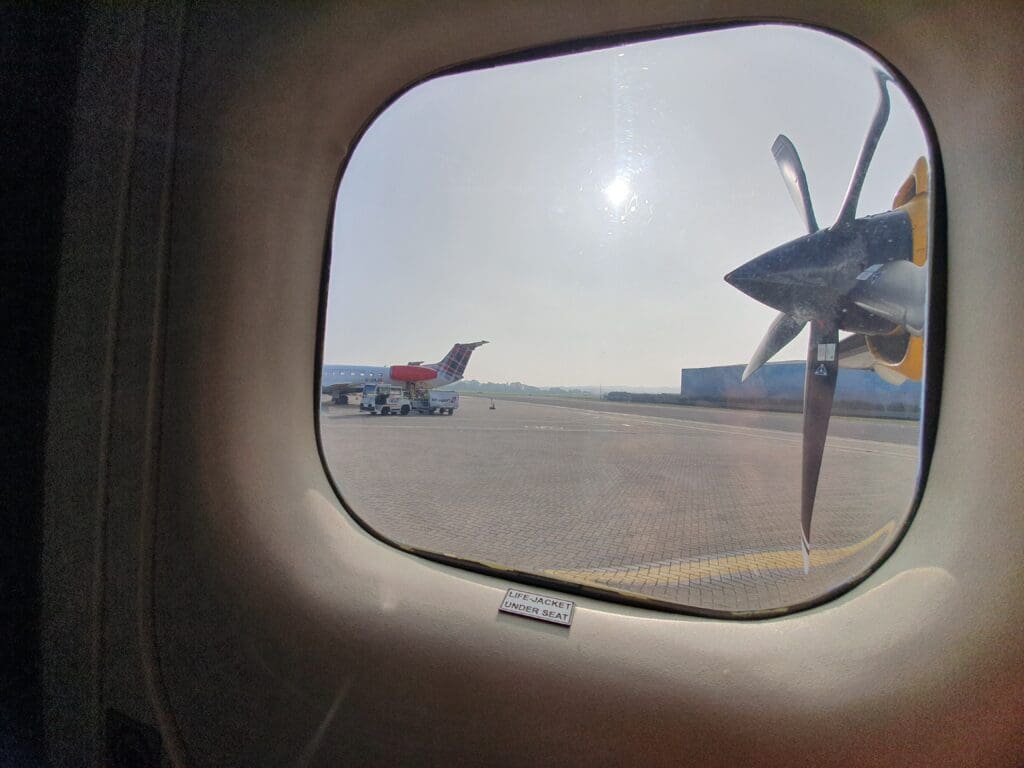
Given the light load, it took no more than four minutes for all seven passengers to take their seats after which one of the ground crew closed the main cabin door at the rear of the aircraft before the captain climbed in via their own personal cockpit door. Once both pilots had checked that their doors were securely closed, the captain turned around and commenced their concise and friendly welcome speech, which included an introduction, an overview of the route, flight time and basic safety information before thanking the passengers for flying with Aurigny. After turning around, the two pilots ran through their pre-departure cockpit checks and the first officer could be heard communicating with air traffic control during the short-lived period of near silence before the engines were fired up.
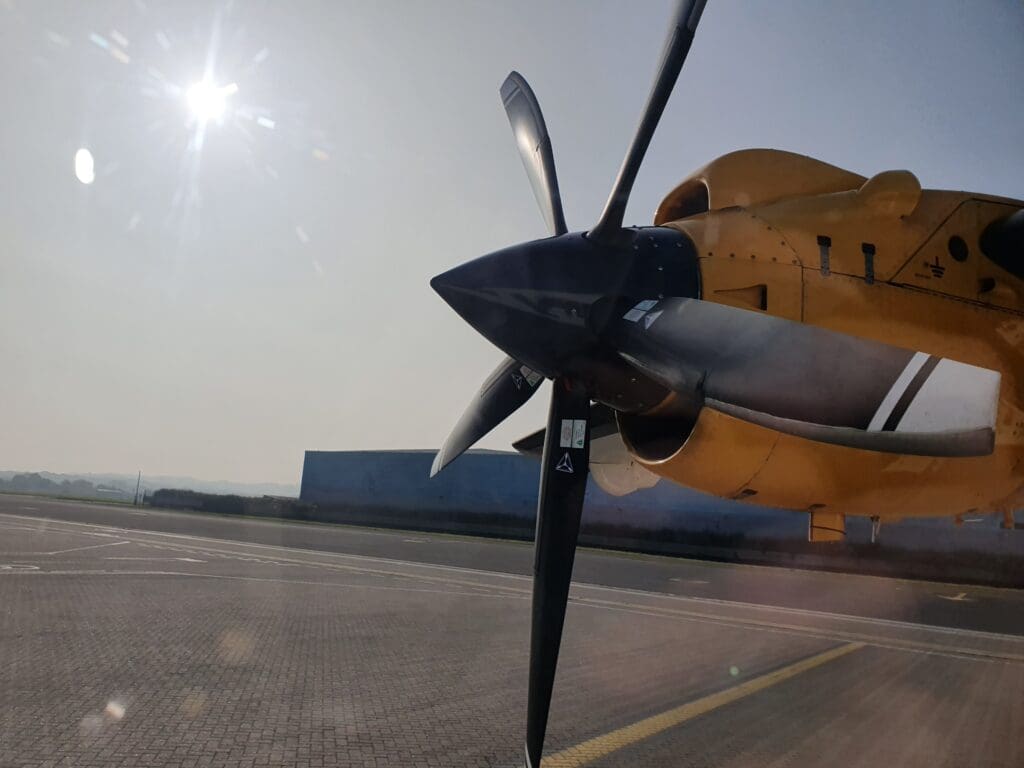
Ten minutes ahead of schedule, the first of the Dornier 228’s two Honeywell TPE331-10 turboprop engines powered up into life, causing plenty of vibration and shuddering for a few minutes as the 5-blade MT Propeller began to whirl into life. Meanwhile, during this time the cabin was temporarily filled with the scent of jet fuel although this soon dissipated and thus did not cause any concern. Once both engines had sprung into action, the pilots ran through more checklist items before the aircraft slowly propelled itself forward out of its stand and wheeled right, placing it onto the taxiway. After commencing its taxi in earnest, the Dornier trundled past the smorgasbord of regional aircraft from BA CityFlyer, Eastern Airways and Loganair as it travelled towards the active runway. No more than a couple of minutes after leaving its stand, the turboprop made its way onto the runway and without halting, taxied onto this before backtracking and coming to a short halt at the end of Runway 20.

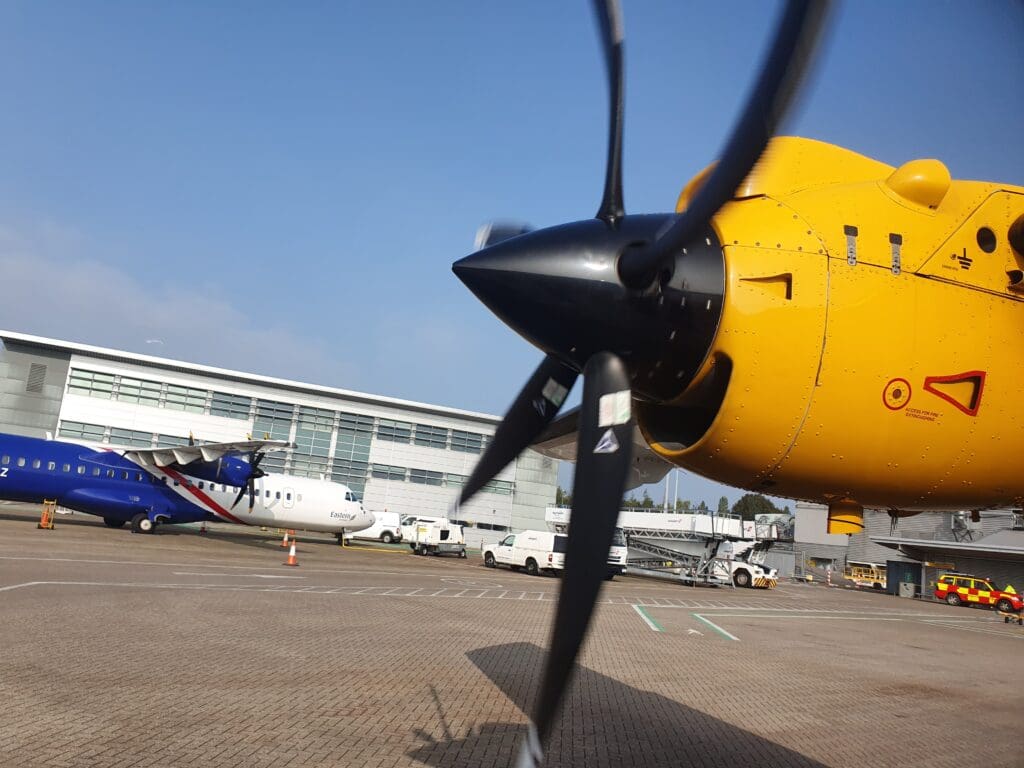
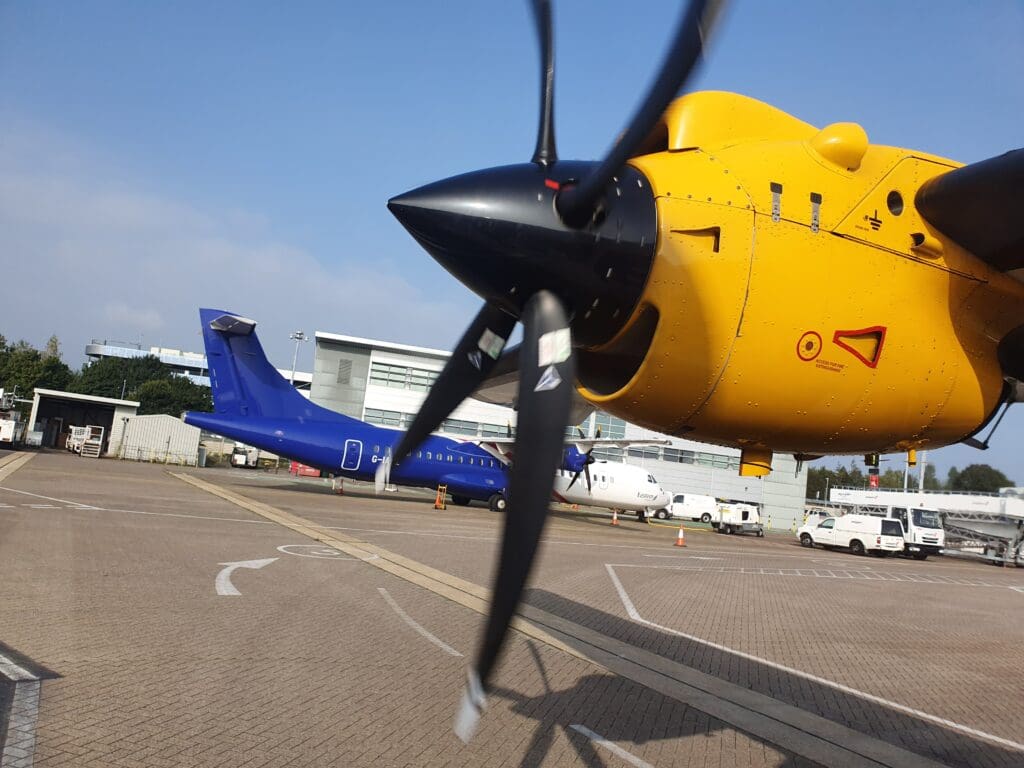

Two minutes before the flight’s scheduled departure time, at 1053 the aircraft’s engines powered up and filled the cabin with plenty of noise – enough to ensure that any conversation between passengers would prove difficult until back on the ground. The brakes were then released and the Dornier accelerated with vigour, speeding past a smart looking American registered Dassault Falcon 2000 as well as a Gulfstream 500 and a smaller Austrian Cessna Citation. Given the Dornier 228’s STOL capabilities, the aircraft took to the skies in what seemed like no time, allowing for a good bird’s eye view of the terminal as the gear was retracted into the fuselage with a thud.



After crossing the perimeter fence, the Dornier soared over the busy M27 motorway – the main route between Portsmouth and Southampton. Heading onwards towards the centre of Southampton, the suburbs of Portswood and Swaythling could be seen before soon reaching the city’s famous port. Whilst Southampton may be the seventh busiest cargo port in the UK, that morning I failed to spot any container ships being loaded or unloaded. Instead, the largest ship spottable took the form of a large cruise ship. I later deciphered this to be the Royal Caribbean ship, the Anthem of the Seas which was taking a break in between its sailings around the British coastline.

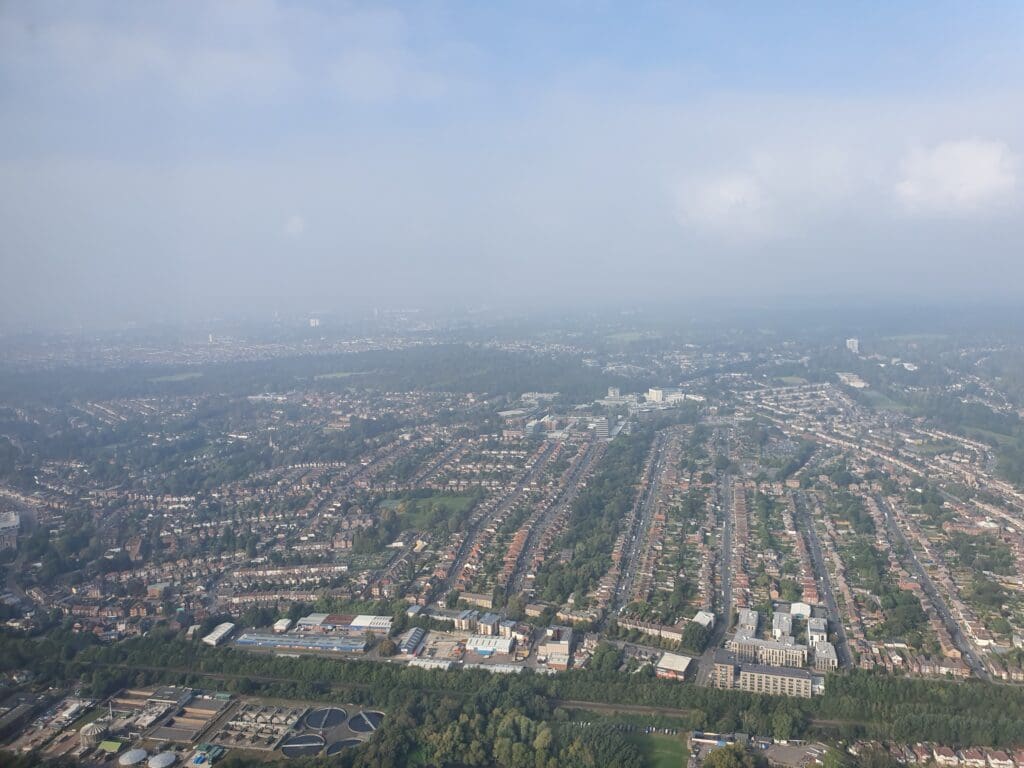
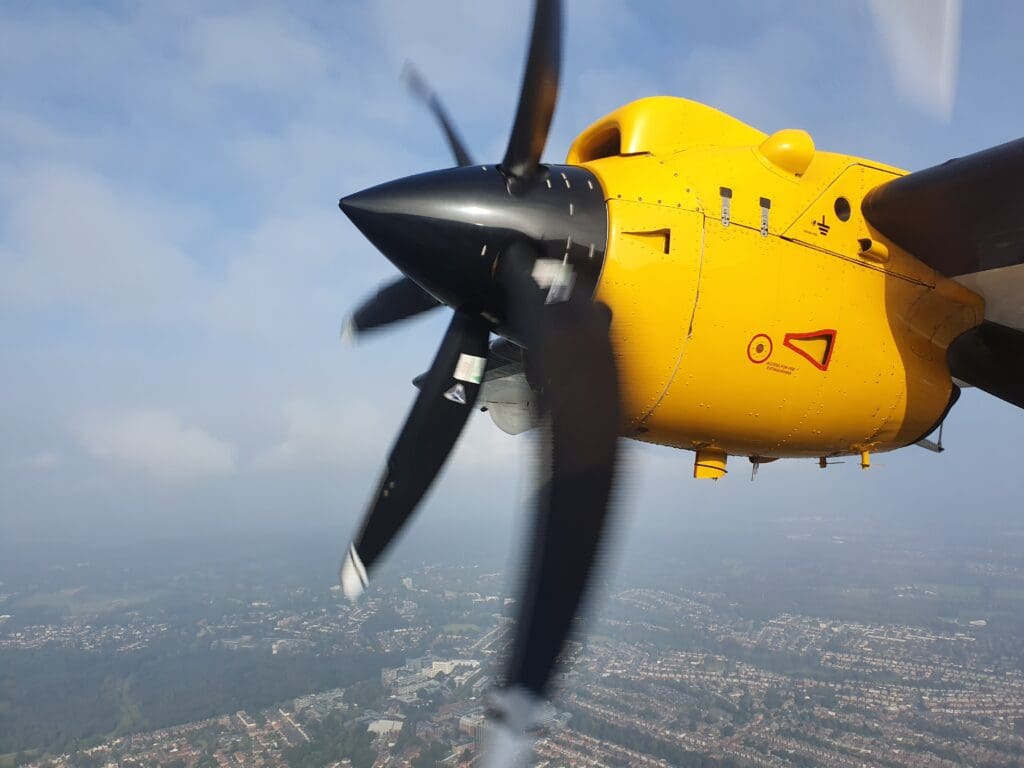
From Southampton, the aircraft made its way southwards across the River Test at which point clouds temporarily prevented those onboard from receiving any views of southern Hampshire. Thankfully, these dissipated as we neared the coastline allowing for fleeting glimpses of the New Forest National Park followed by the town of Lymington and Hurst Point Lighthouse.
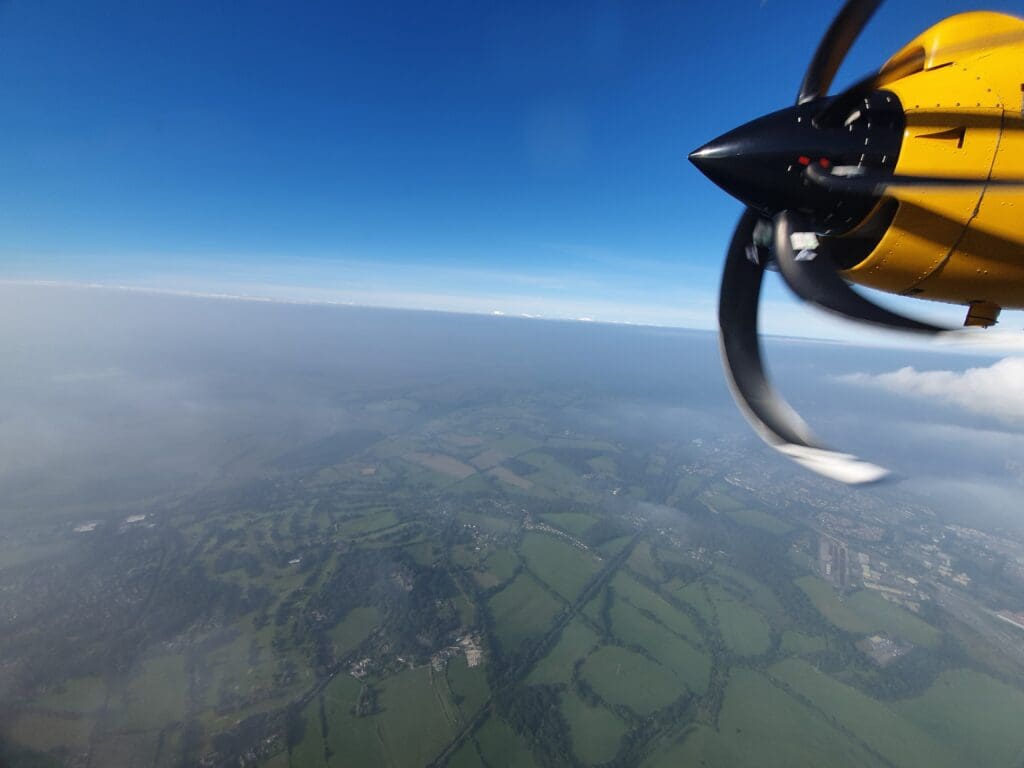
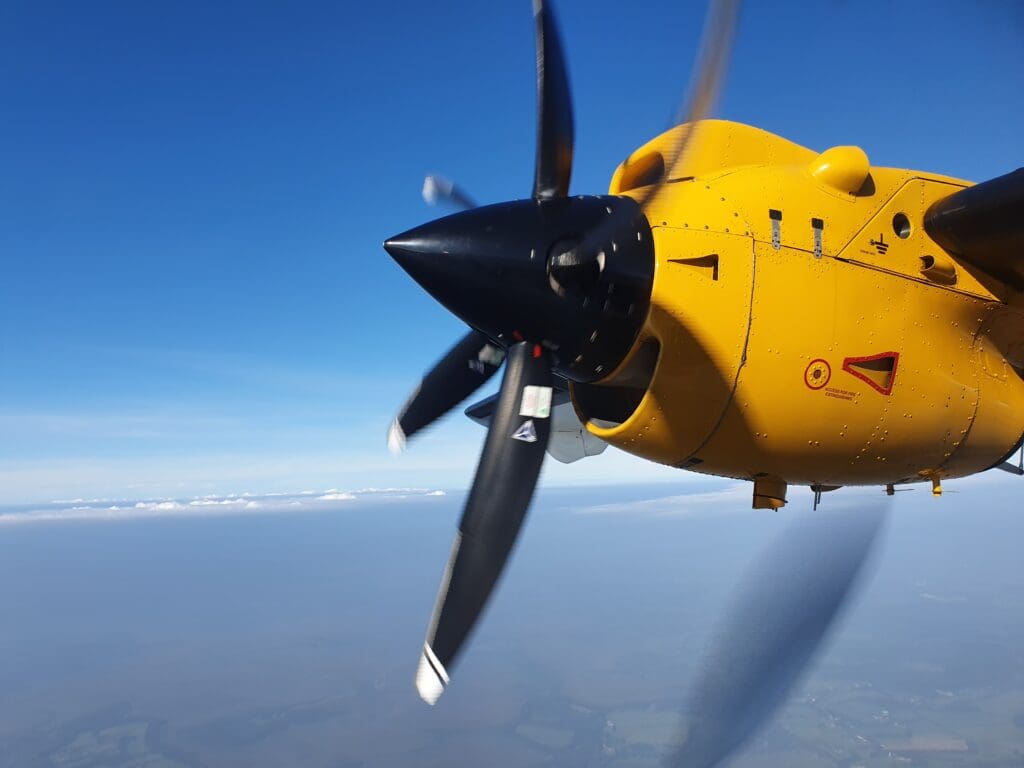
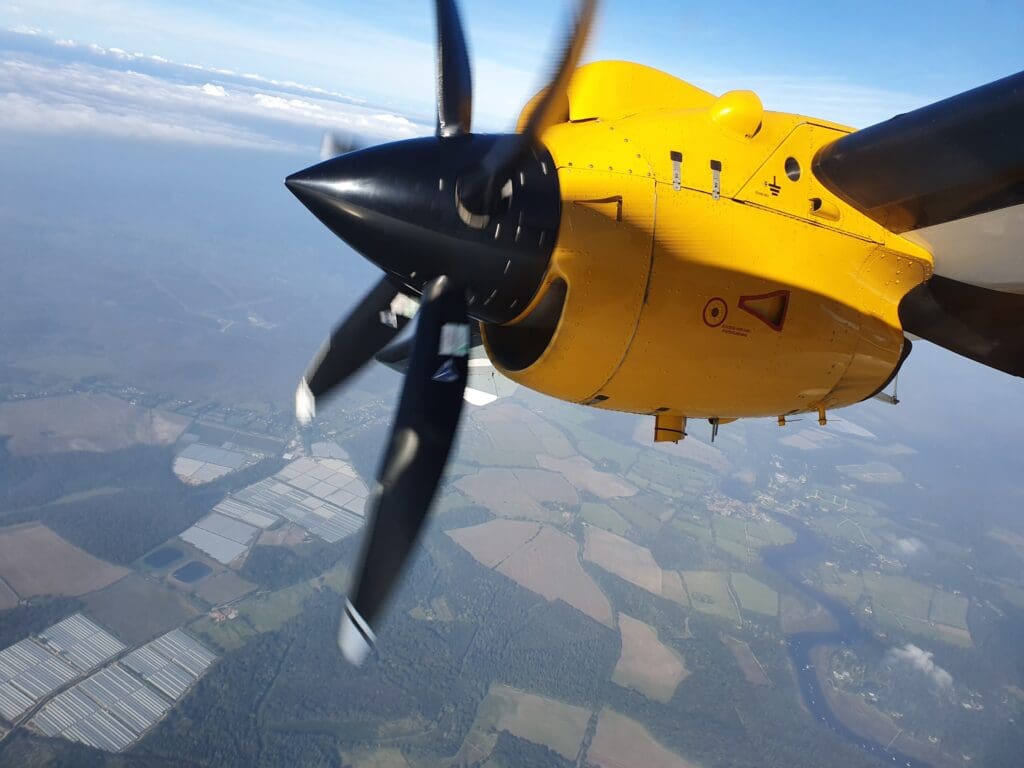
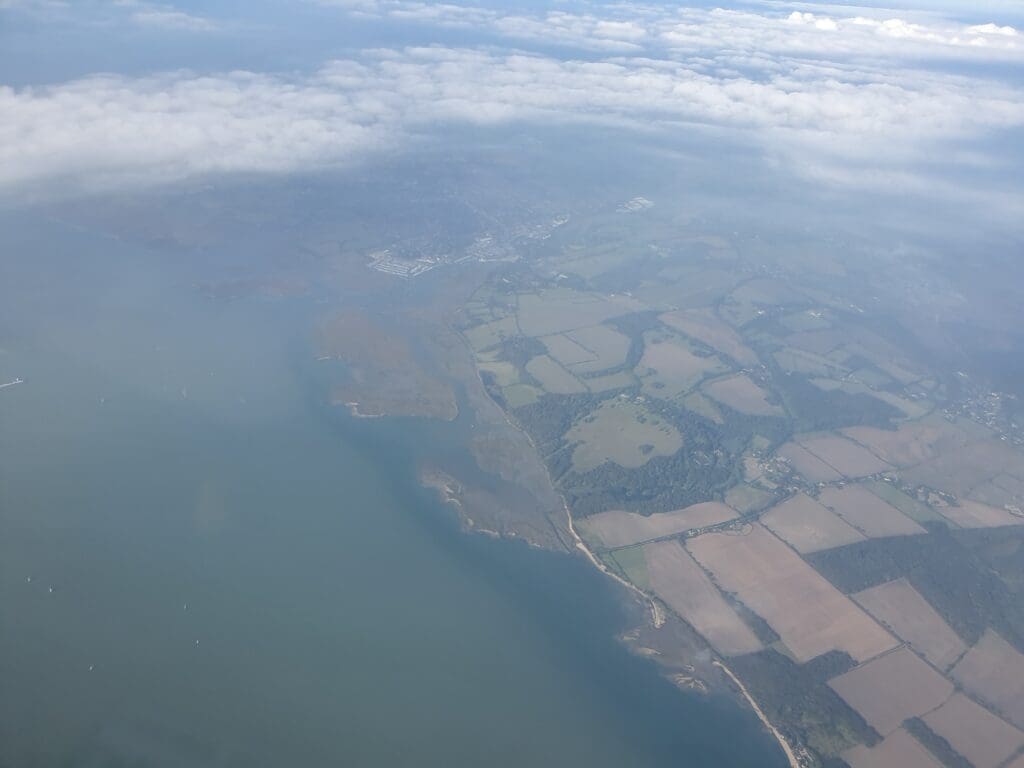


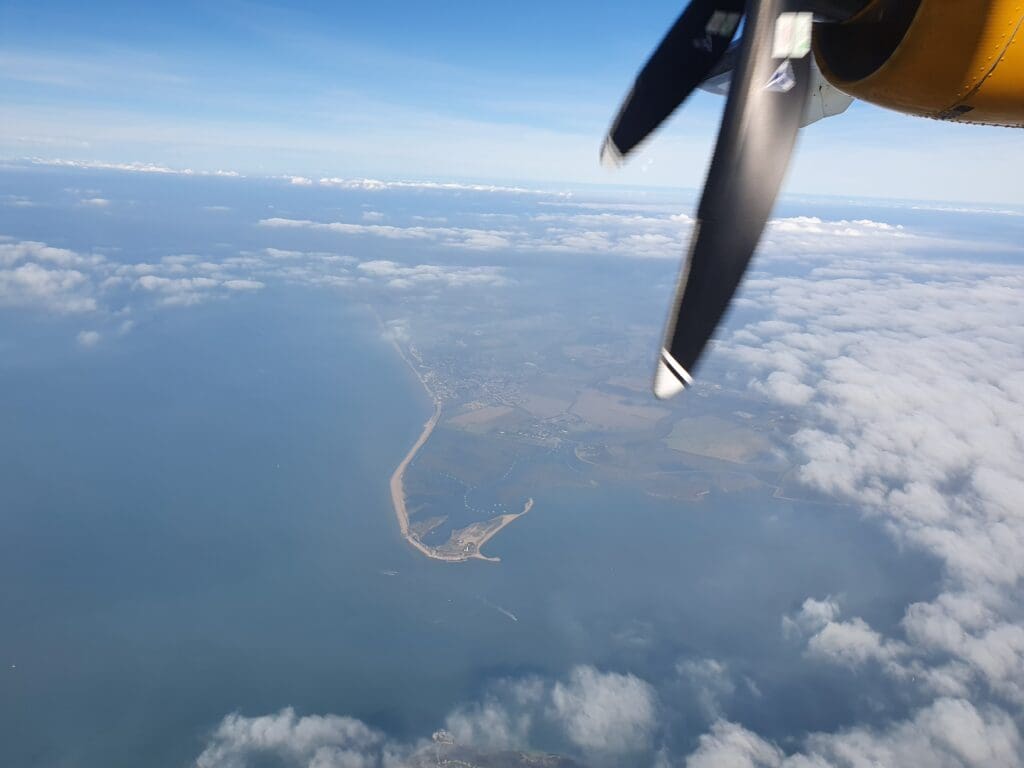
After leaving the mainland behind, the Dornier made a very short crossing of the Solent, during which it levelled off at its low cruising altitude of 6,000 feet whilst its airspeed increased from 145 to 193 knots. At this point, the Isle of Wight’s famous chalk stacks, the Needles, could be seen at the westernmost tip of the island. Sitting on the wrong side of the aircraft for any other views of the island, once these cliffs had faded away little could be seen other than the blue waters of the English Channel as well as the occasional freighter chugging along below, each with long wakes and short trails of black or white exhaust fumes.
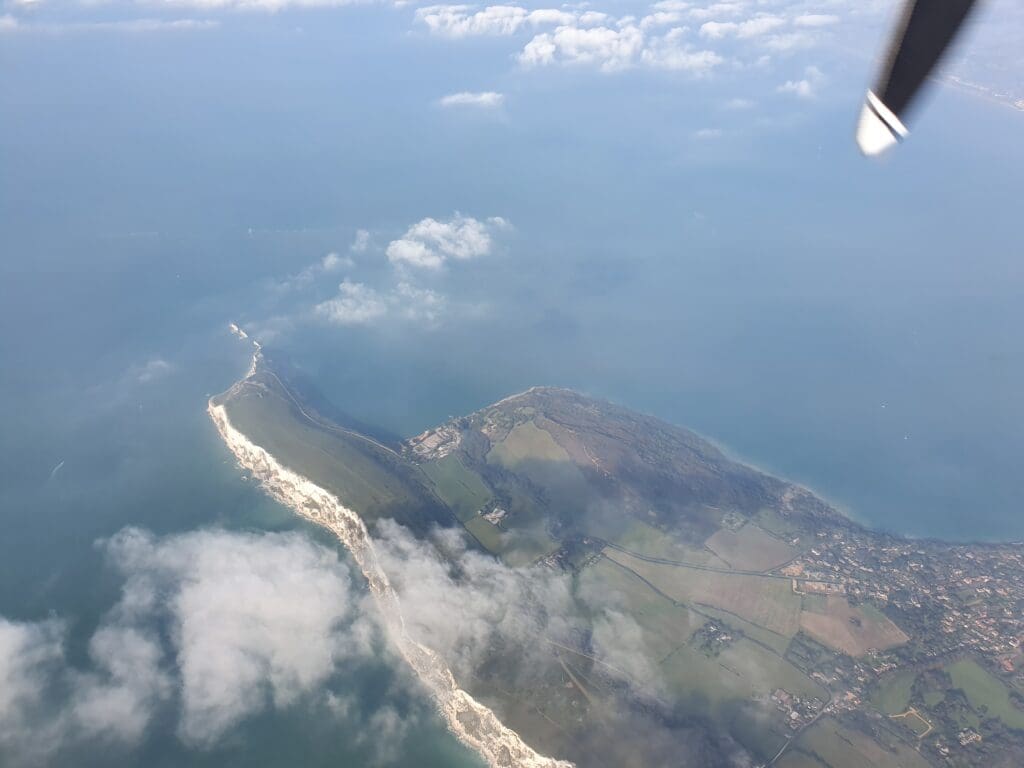
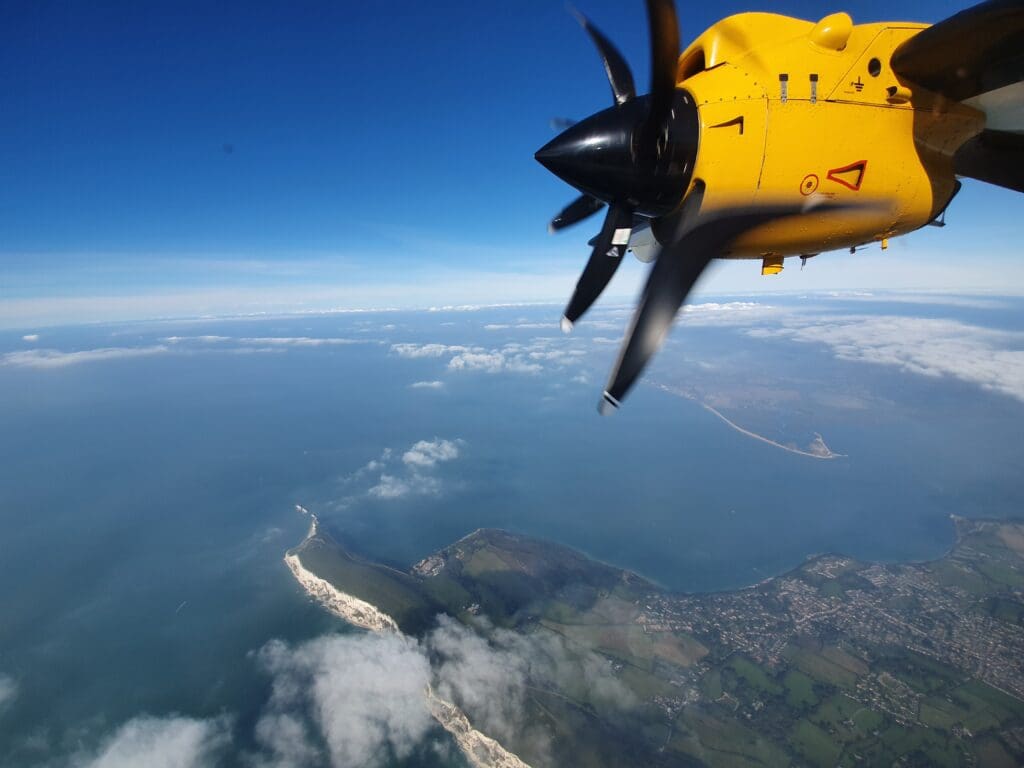
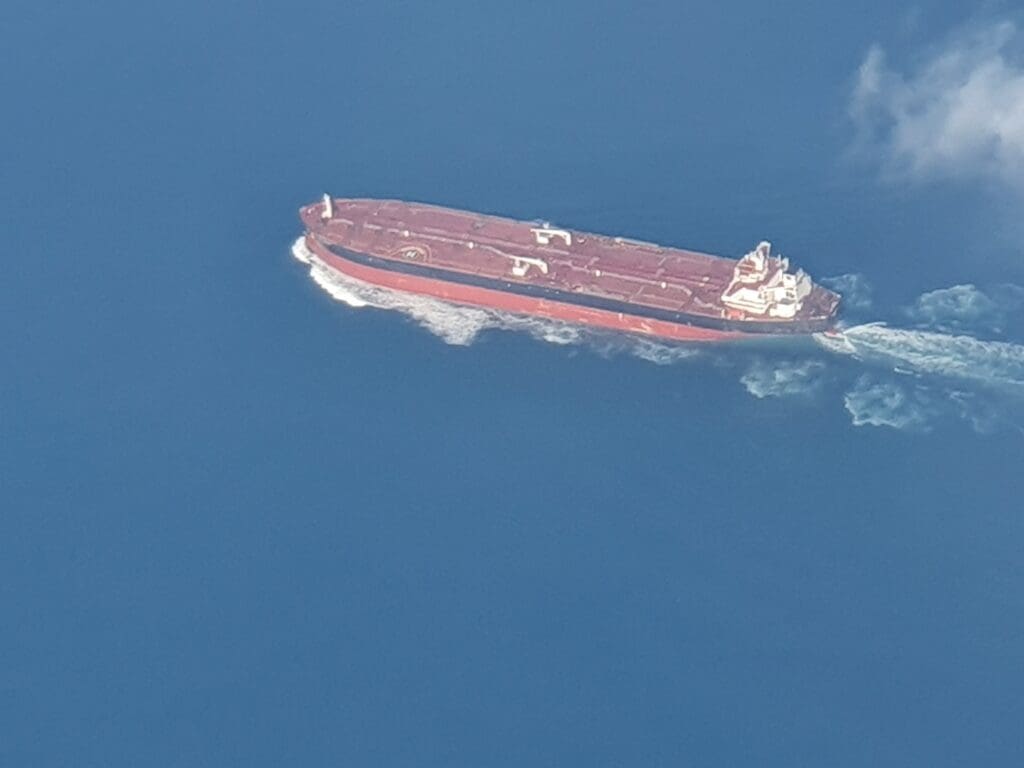
As the captain had mentioned during their welcome speech, that morning’s ride southwards was smooth with only a small handful of barely noticeable bumps and bounces as we crossed the Channel. Inside the cabin, the racket produced by the Dornier’s two turboprops was unrelenting and ensured that the only occupants of the aircraft chatting away were the two pilots, both of whom were wearing noise-cancelling Bose headsets. Meanwhile, a very brief glance rearwards revealed that passengers passed the time by either reading or watching the world fly by.
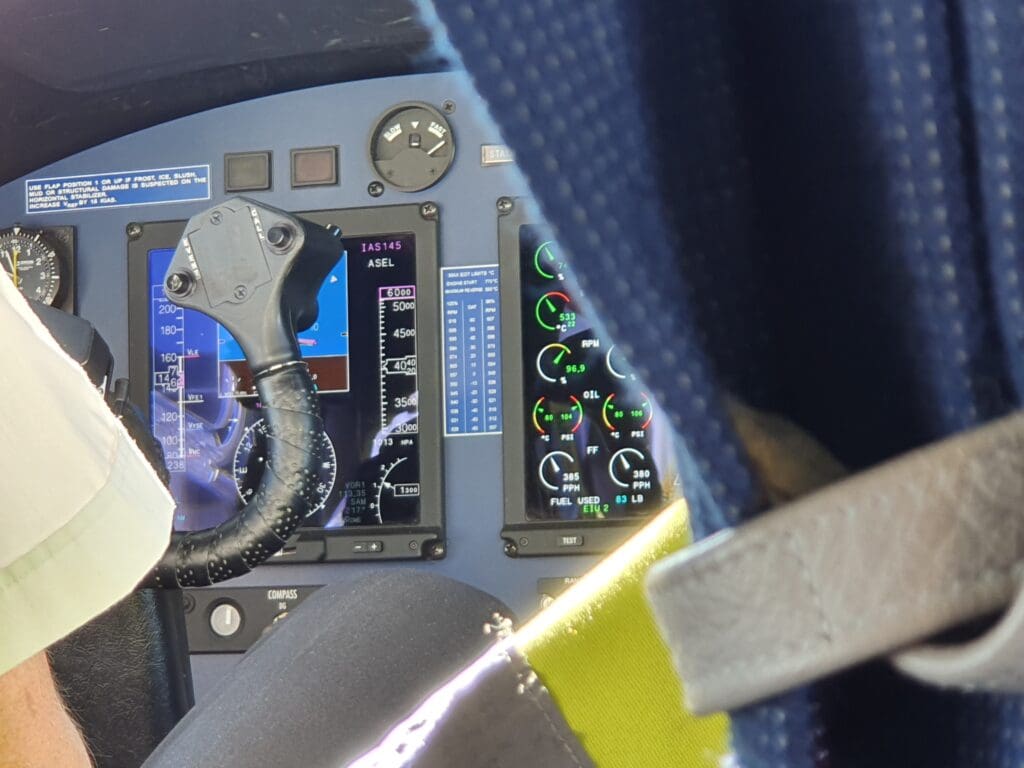

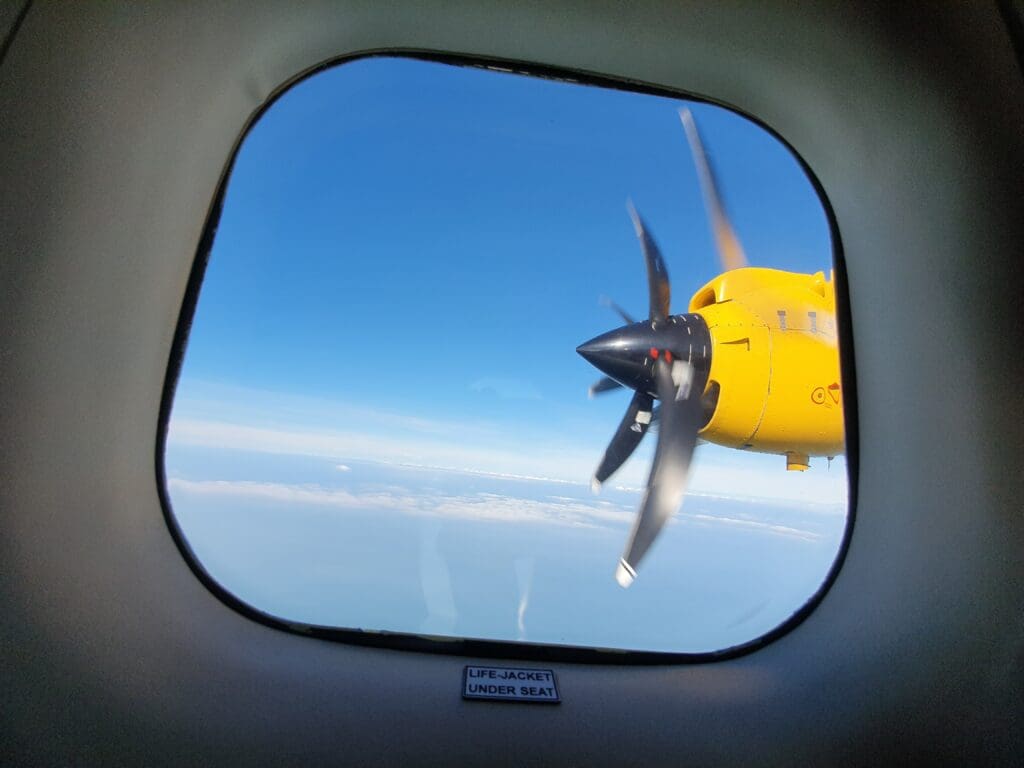
With the straight line distance between Southampton and Alderney standing at a short 134 miles, only nineteen minutes after the aircraft had rocketed upwards into the skies of Southampton, the aircraft could be felt sinking downwards at a steady rate of 850 feet per minute. Glancing forward, this revealed that a target altitude of 3,000 feet had been selected on the autopilot. For those that had not noticed that we had commenced our descent into Alderney, the Captain soon commenced a short pre-arrival announcement. Whilst this could hardly be heard, I managed to make out the usual warning regarding seatbelts as well as a brief word of thanks for flying with Aurigny.
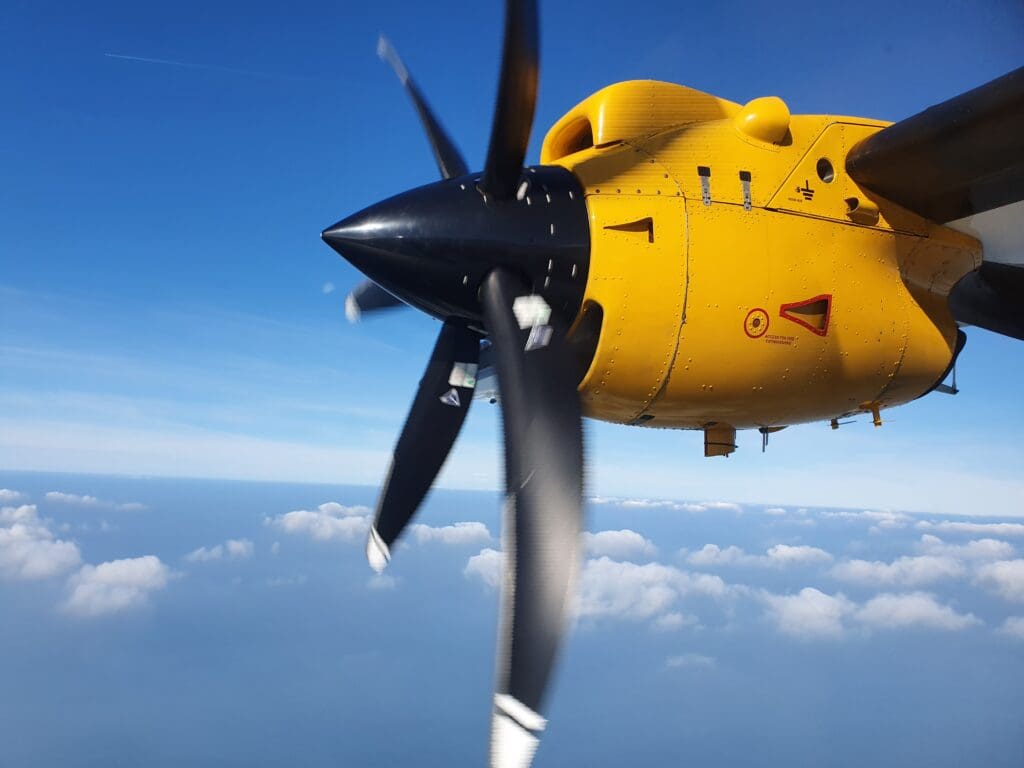
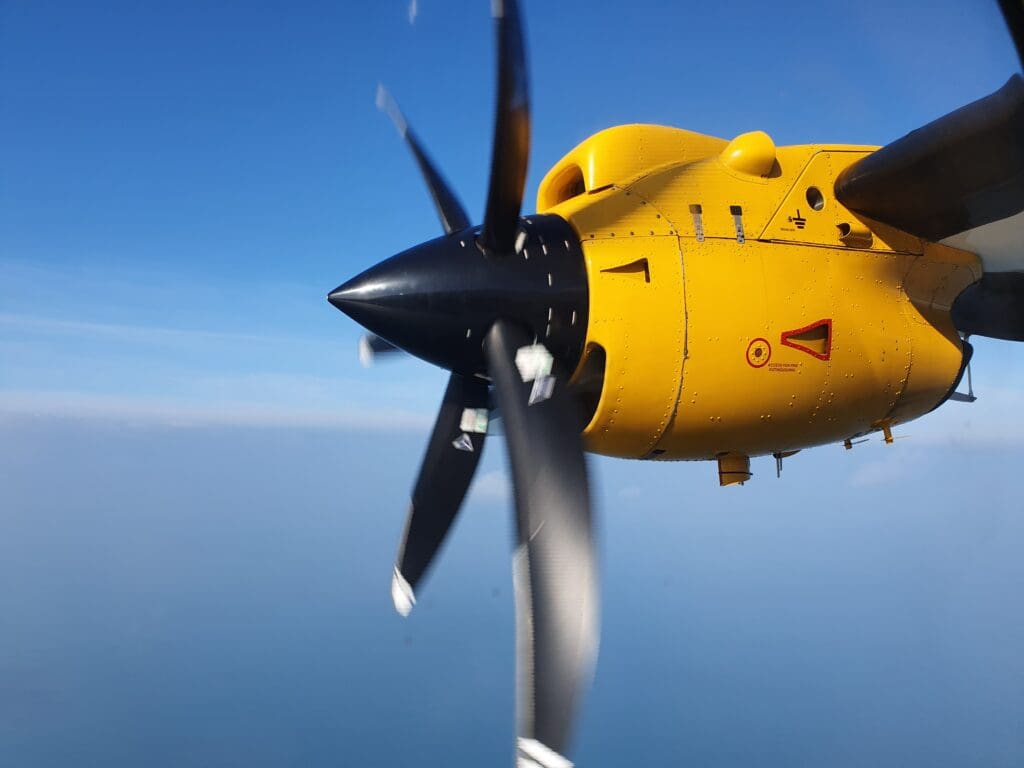
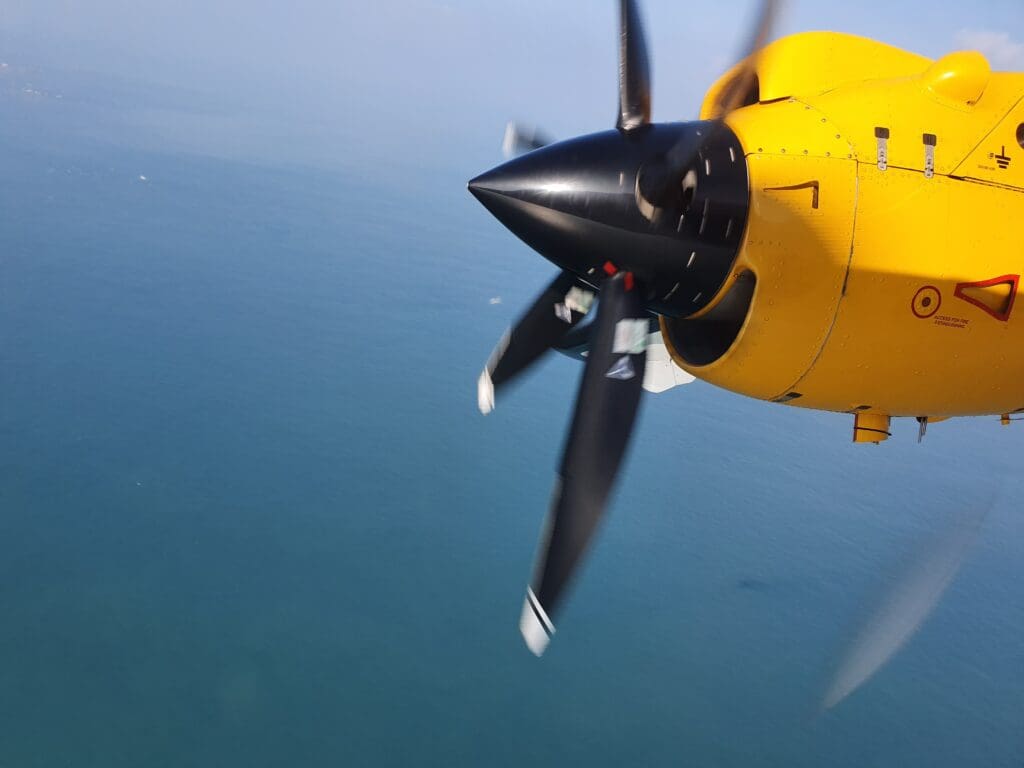
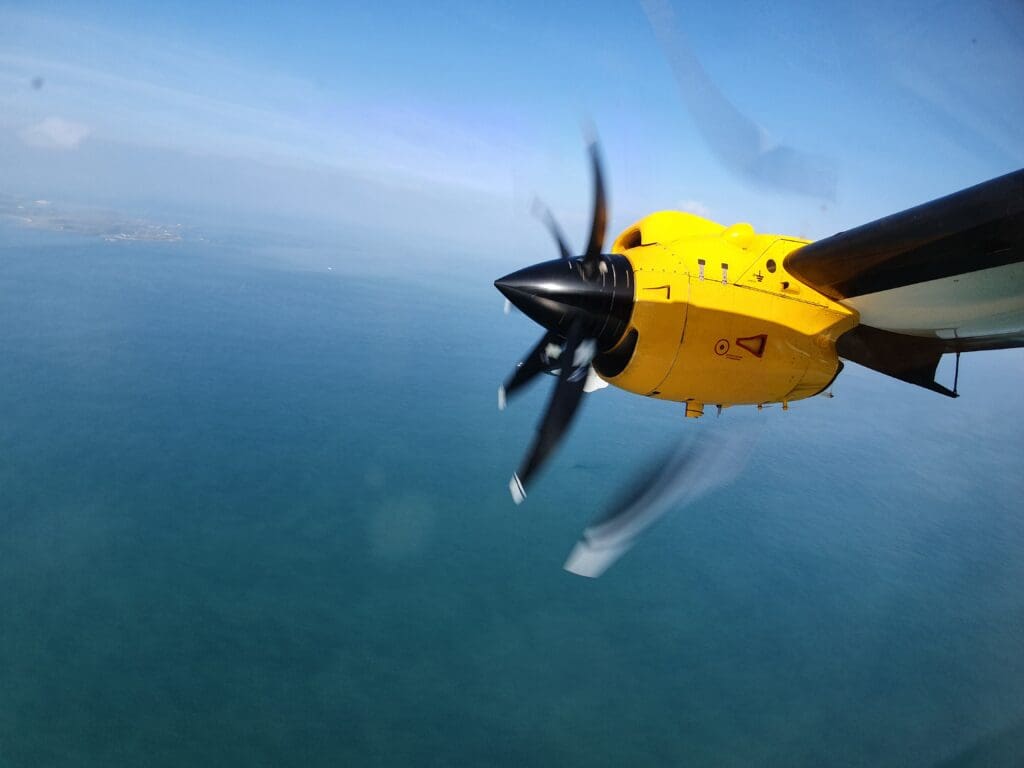
Sinking down further towards the waves below, nervous flyers would have likely been relieved to see Quesnard Lighthouse on Alderney’s western tip welcoming us to the island at 1117. In spite of the weather forecast mentioning of a light breeze from the east, I was pleasantly surprised to see that the aircraft would instead make an approach to Runway 26. Seeing as I was sitting on the right hand side of the aircraft, this would allow me to get a brief aerial tour of the island during which many of its sights would be visible. These included Fort Raz and Longis Bay, St Anne and Braye Bay in the distance, and the picturesque rocky cliffs on the island’s southern coast.
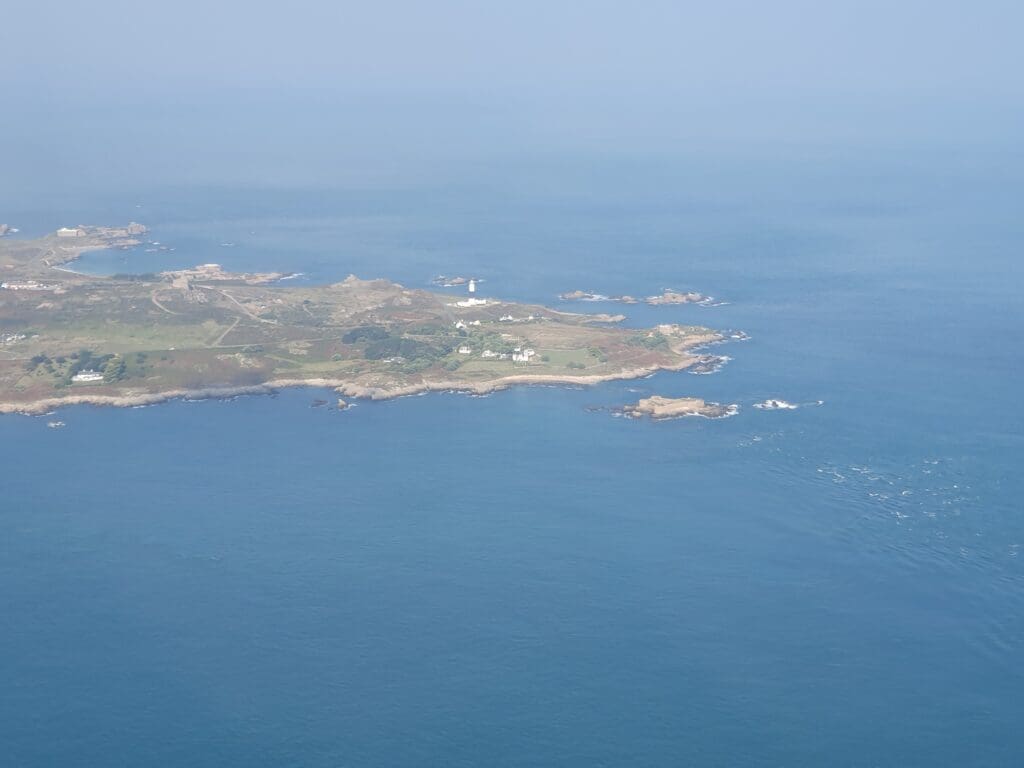
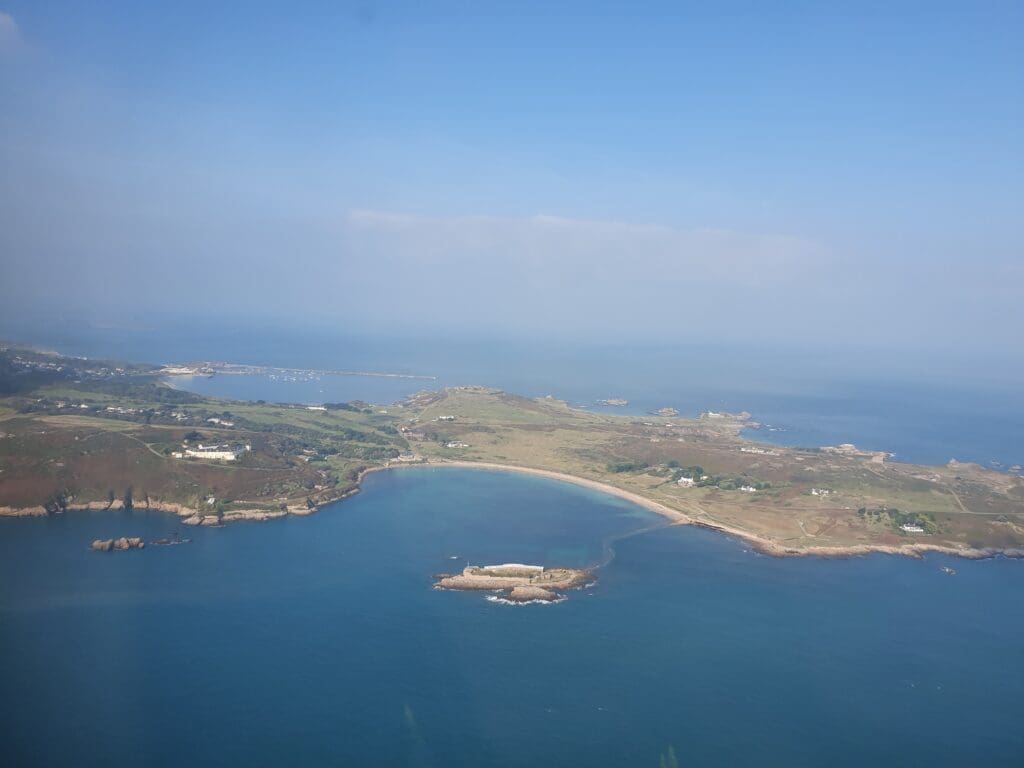
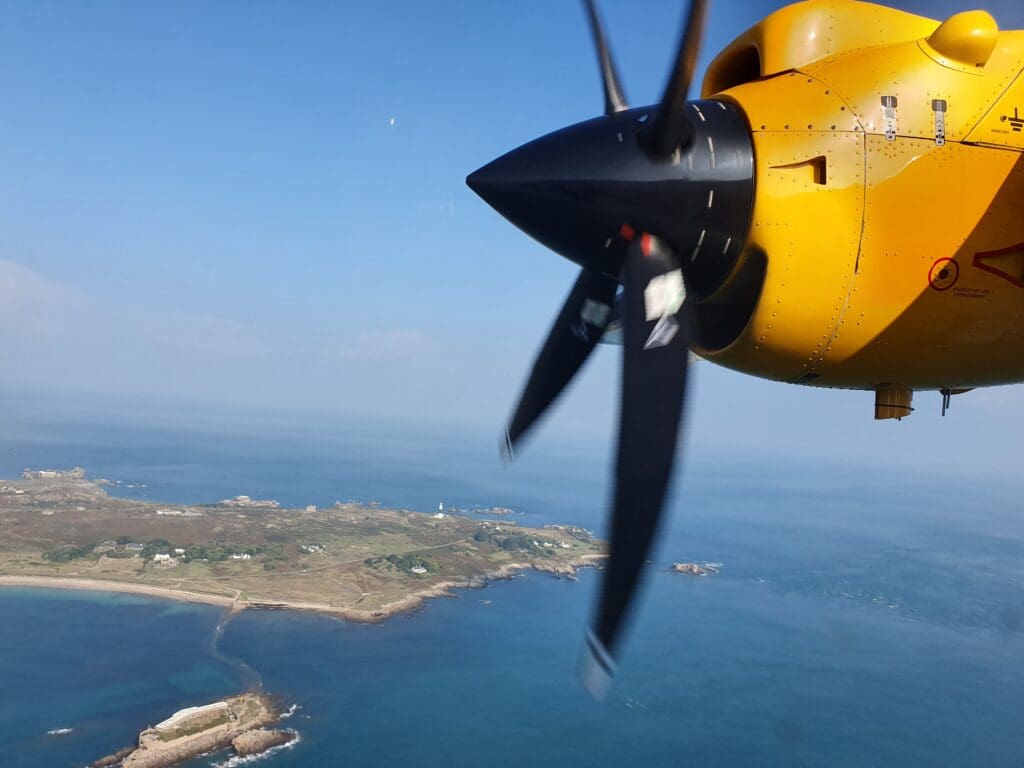
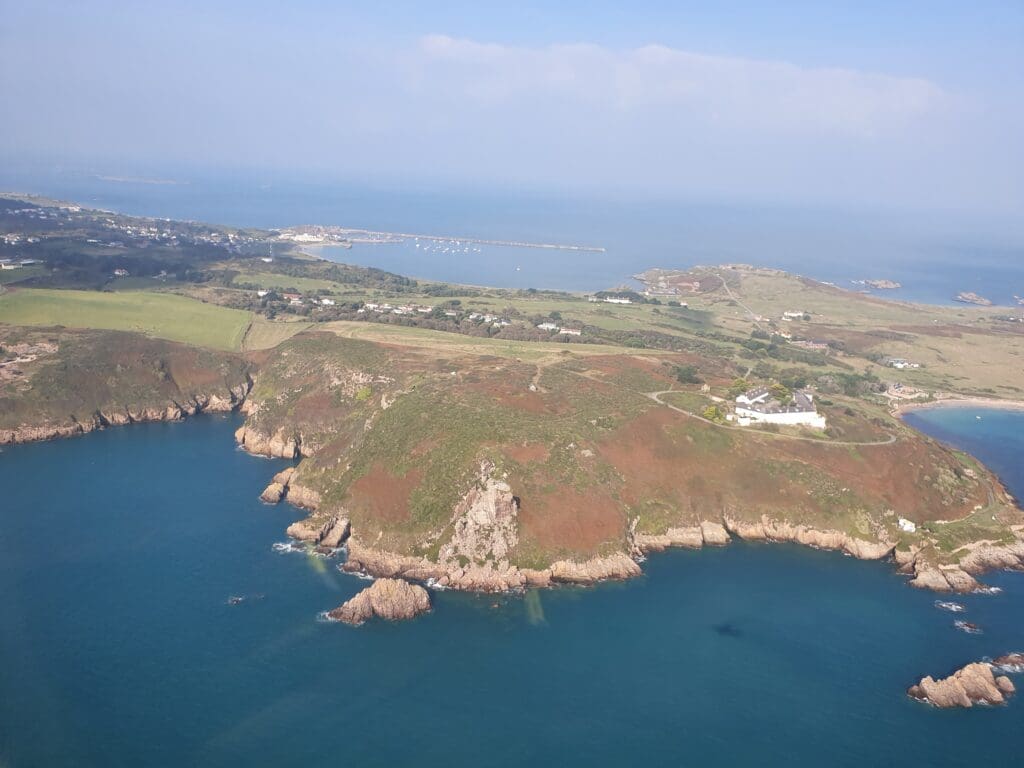


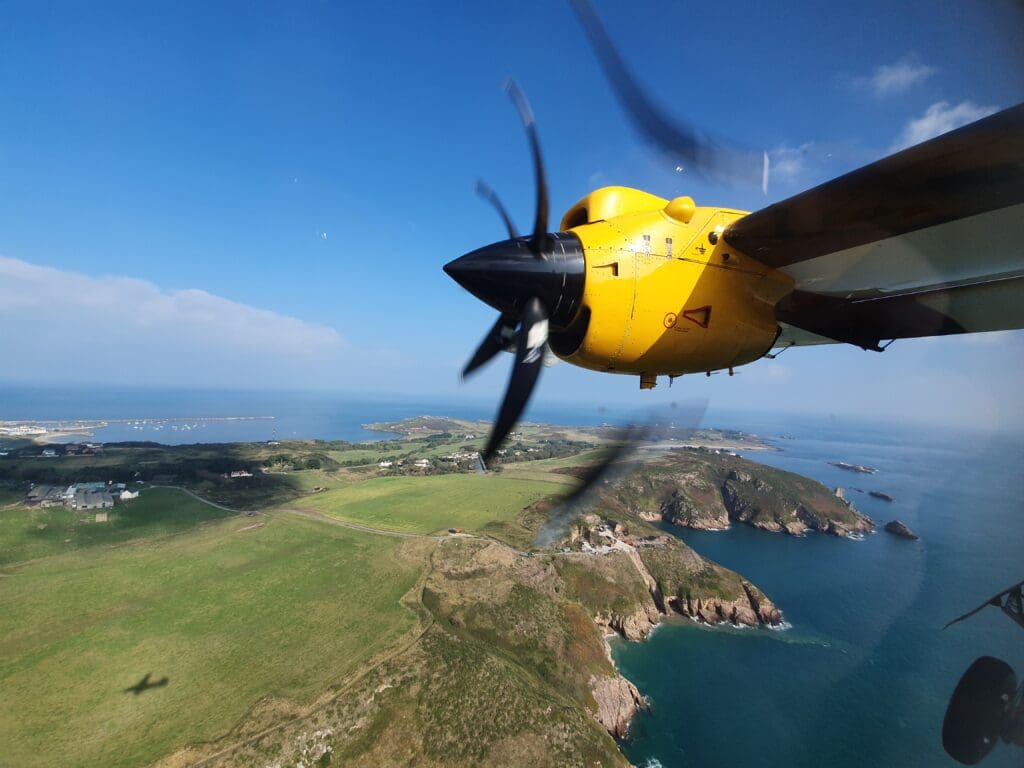
After crossing the island’s southern cliffs, the Dornier descended over the green fields that surround the airport before touching down with a firm bump after 27 minutes in the air. Standing at 877 metres (2,877 feet), whilst Alderney’s main runway is by no means long, it does provide around twice the distance needed for a Dornier 228 to stop in dry conditions and thus once on the ground, the turboprop decelerated somewhat gently. Once at the end of the runway, the Dornier performed a u-turn and backtracked down the runway before vacating this via the airport’s single asphalt covered taxiway.
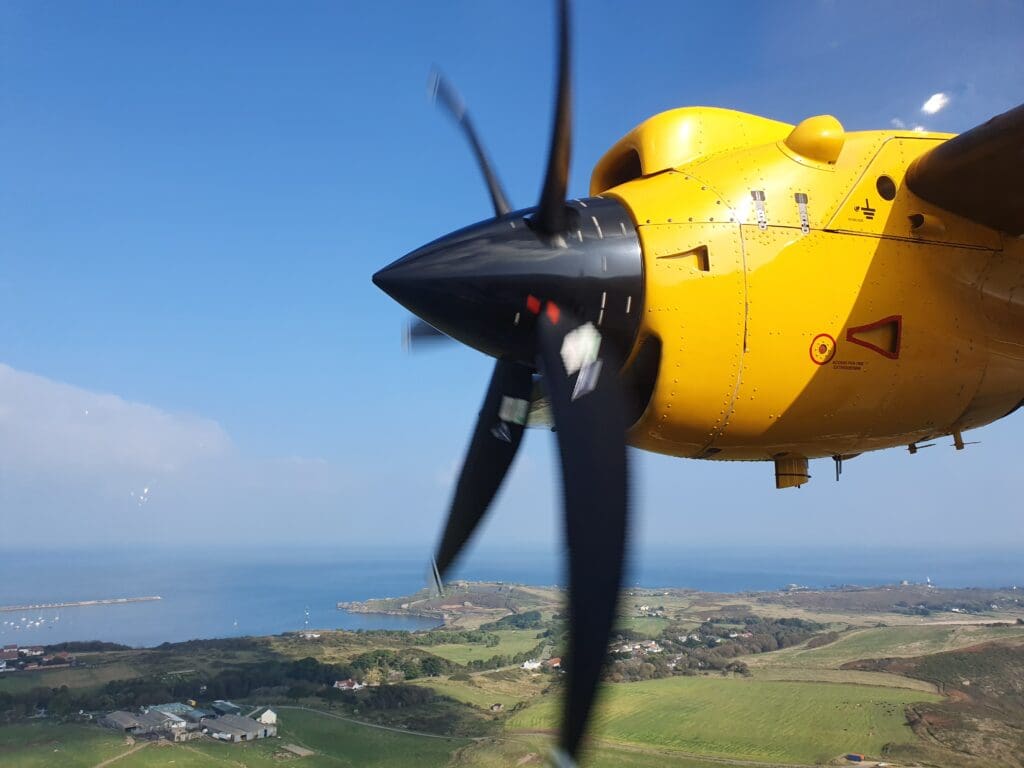

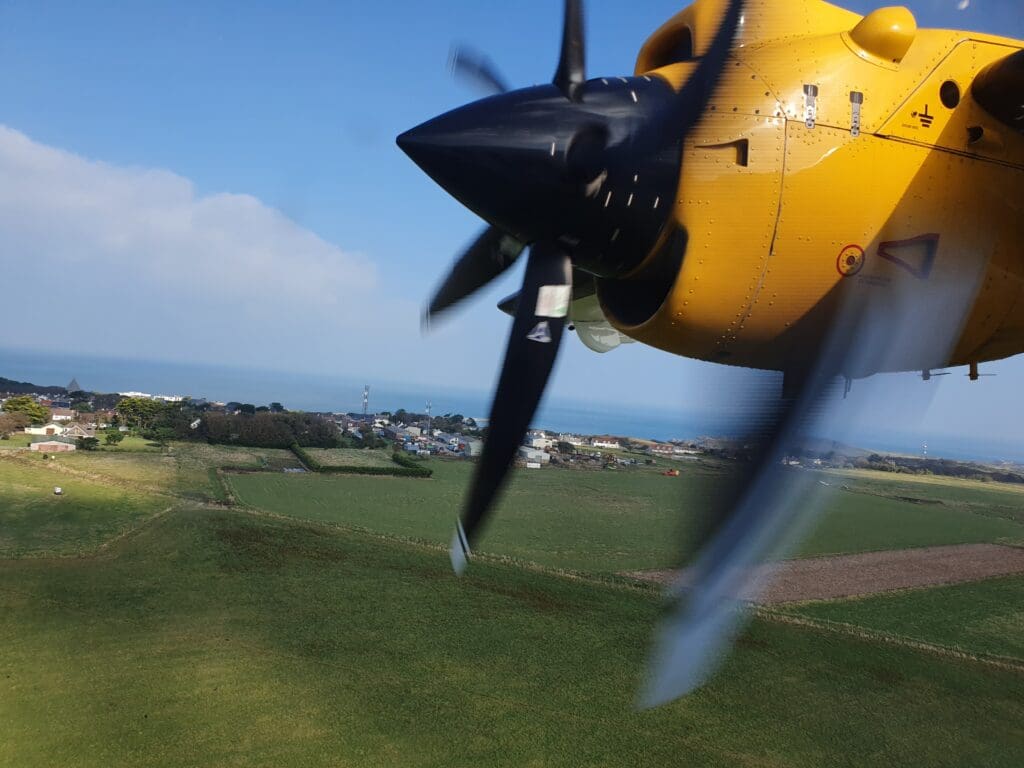

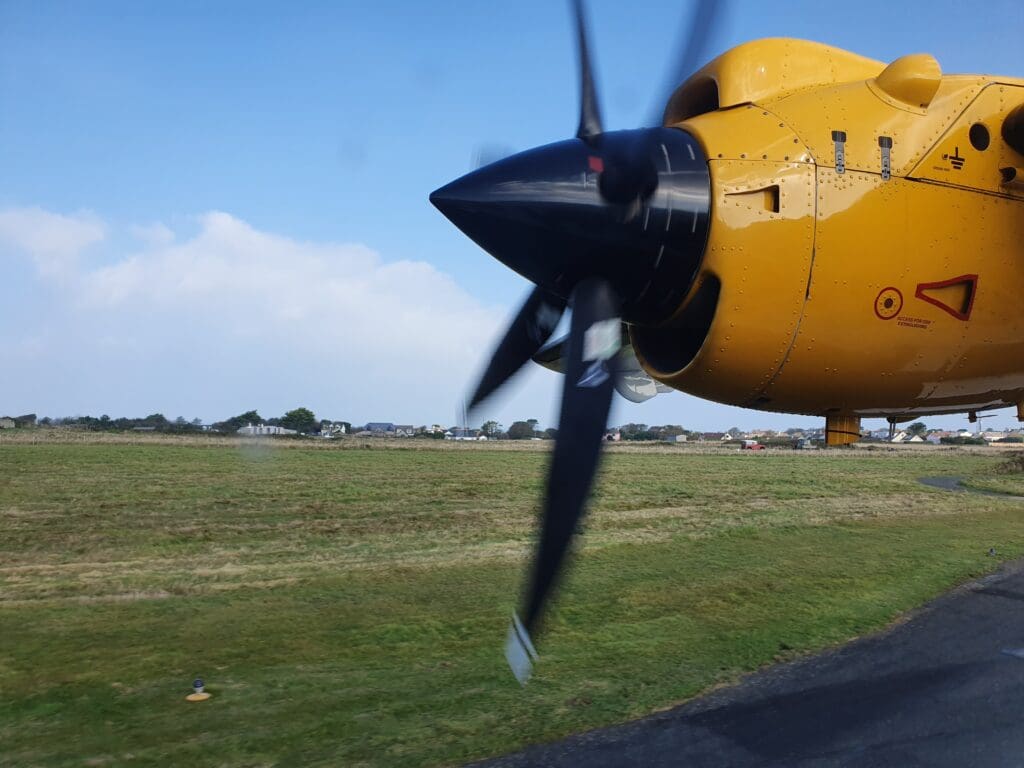
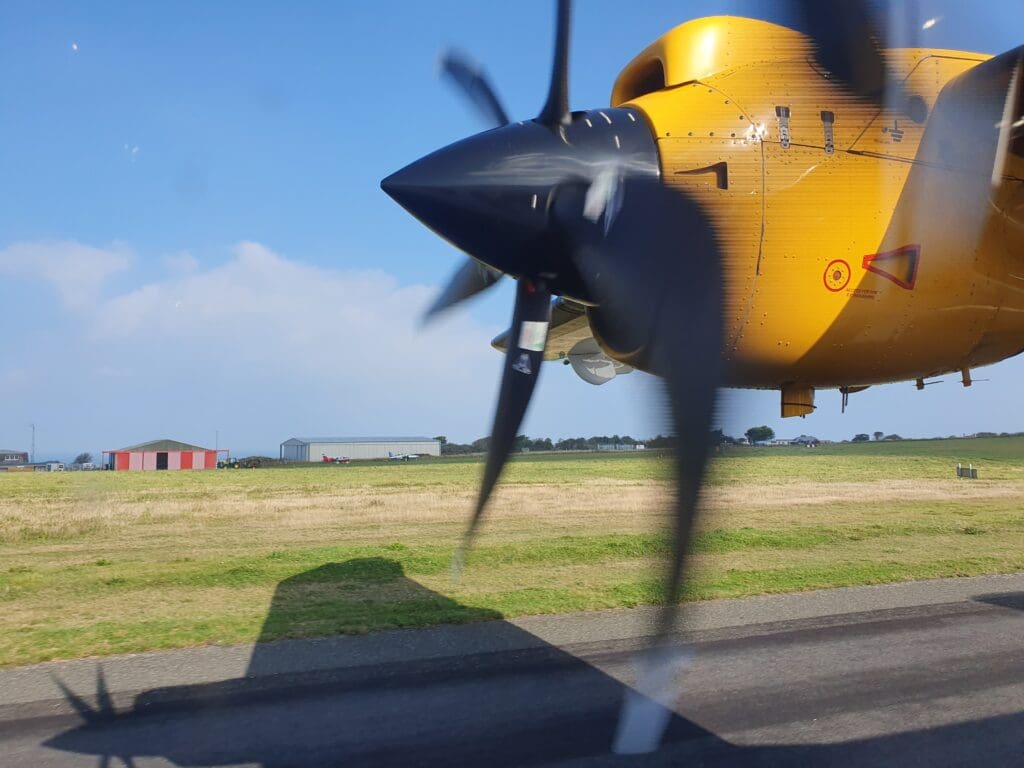
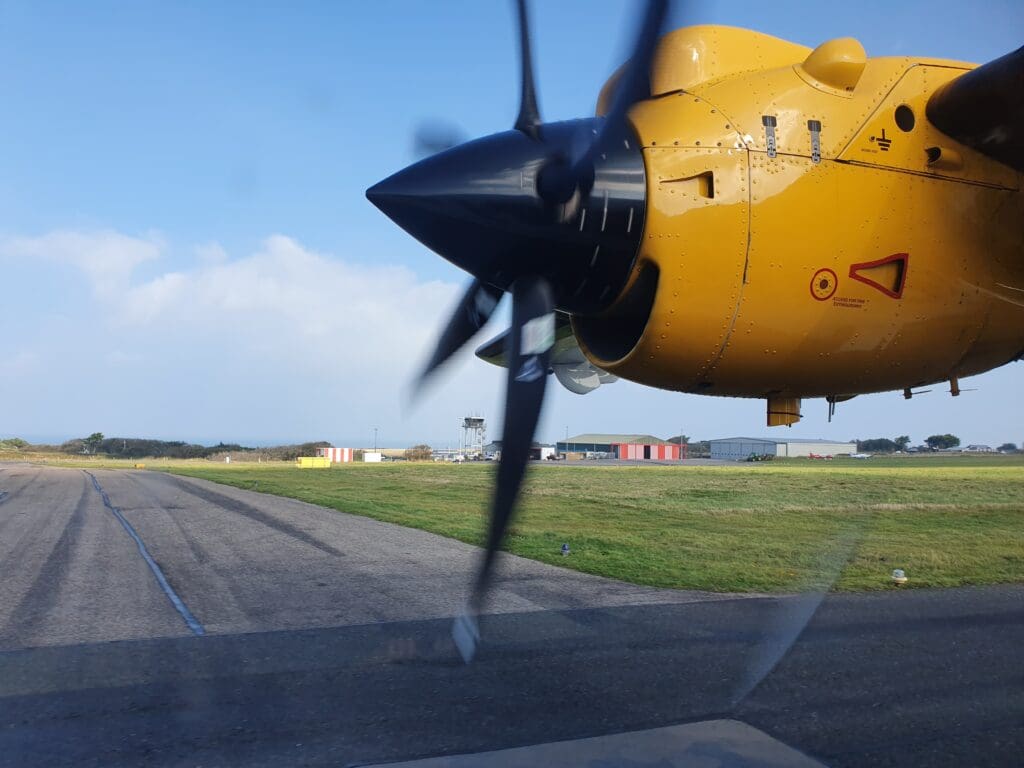
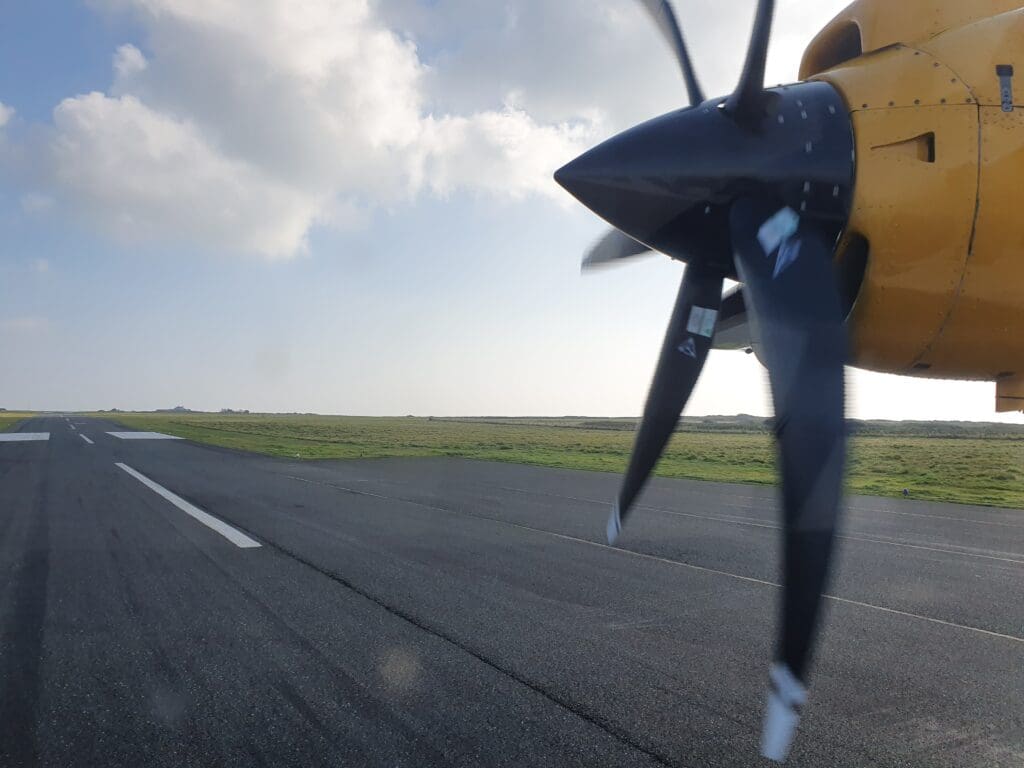
Given Alderney Airport’s very compact nature, the aircraft reached its parking position outside the terminal in no time and the engines soon spooled down, filling the cabin with an eery silence before the captain turned around and thanked passengers for flying with Aurigny. Given the unseasonably good weather, and being a Saturday, two visiting aircraft could also be seen on the ground taking the form two Piper PA-28s that had made the trip southwards from the UK earlier that morning. These were soon joined by a host of other visiting light aircraft from both Guernsey and the UK later in the day.
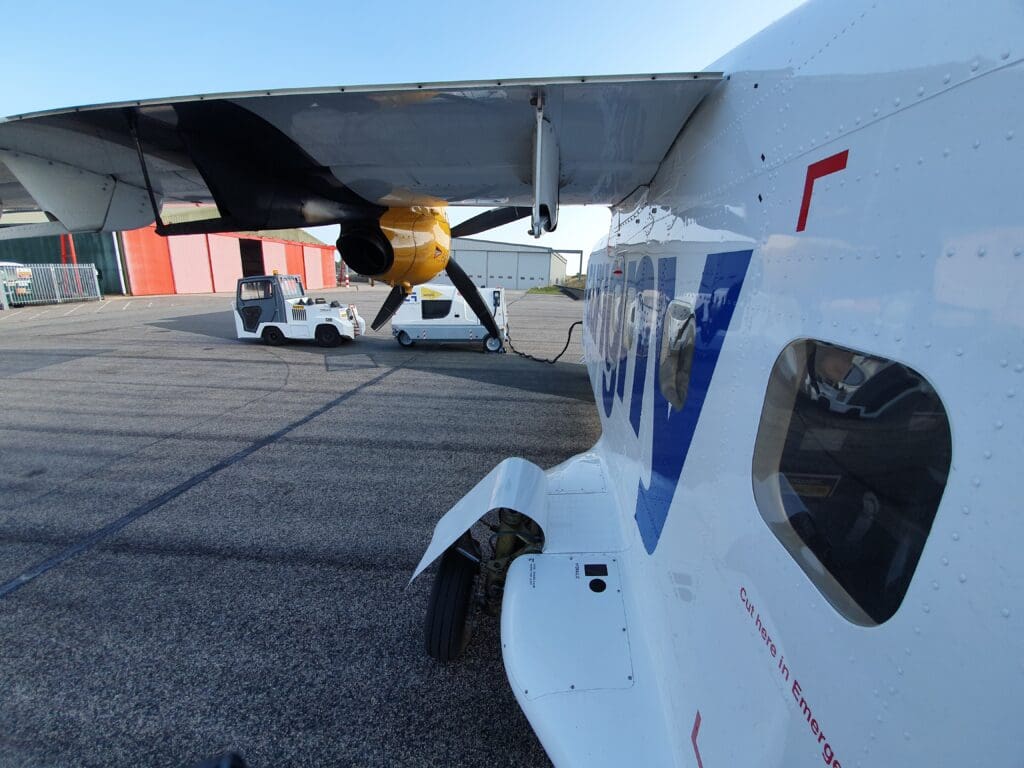
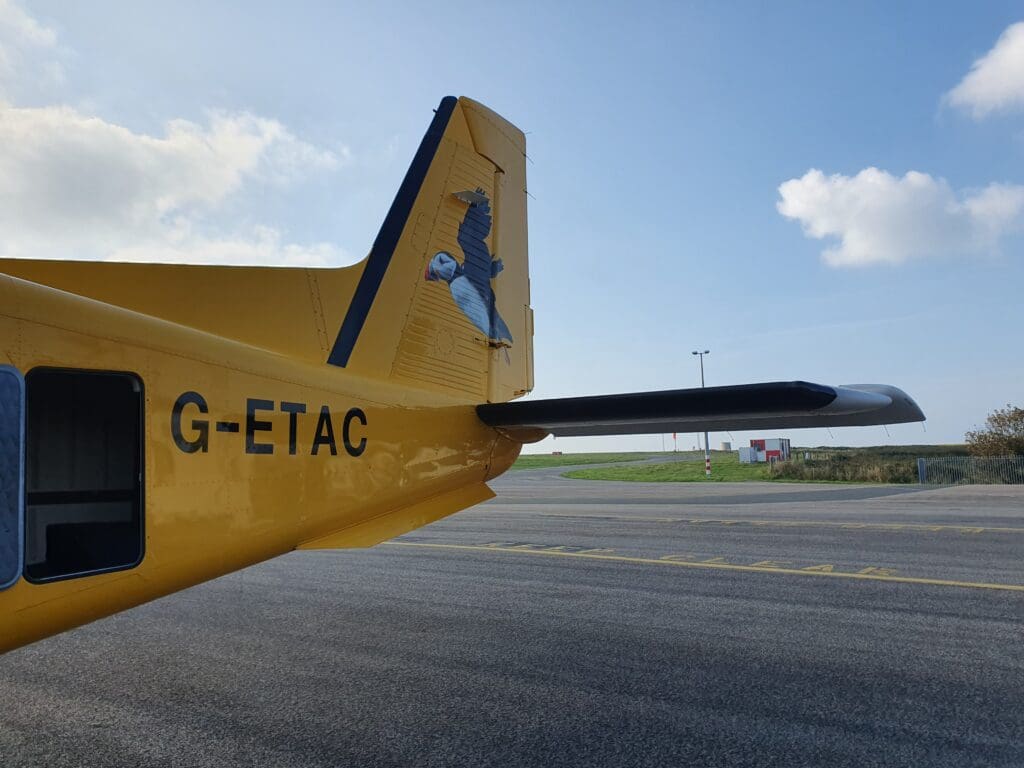
Almost as soon as the Dornier’s engines were shut down, the ground crew got to work unloading passengers’ luggage – taking these out of the hold before placing them on a trolley ready for collection. Meanwhile, the rear cabin door was soon opened and disembarkation commenced without a delay. In spite of being the last passenger to disembark, I managed to make it out of the aircraft no more than a minute after disembarkation had commenced. Once away from the aircraft, I followed the crowd towards the arrivals portion of the airport – a small hut! Outside this, a squad of staff dressed in full medical gear greeted passengers, with one approaching me to check that I had filled out Guernsey’s Travel Tracker form. Once I had shown this to the staff member, I was then given the test kit that I had paid £25 for the previous day. After receiving this, I made my way over to the bathroom in the main terminal and did a lateral flow test. Having done two on the day prior to my flight, I would have been surprised and somewhat stuck had this presented me with two lines, however thankfully after a good swabbing only one appeared and I was free to explore the island.
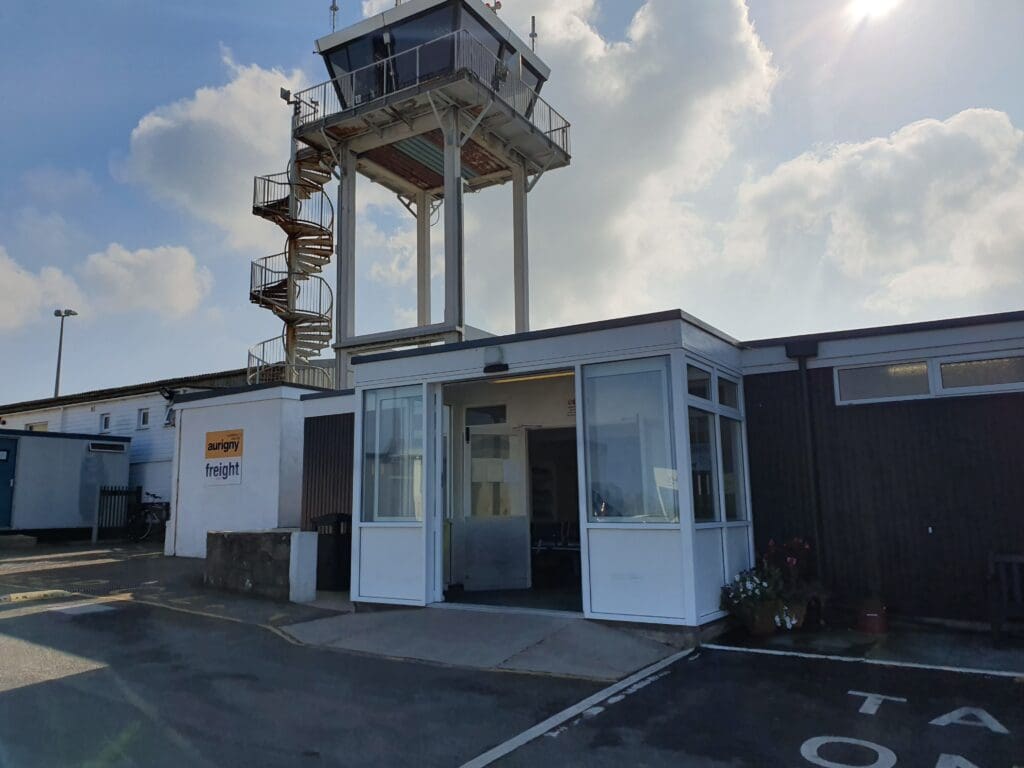
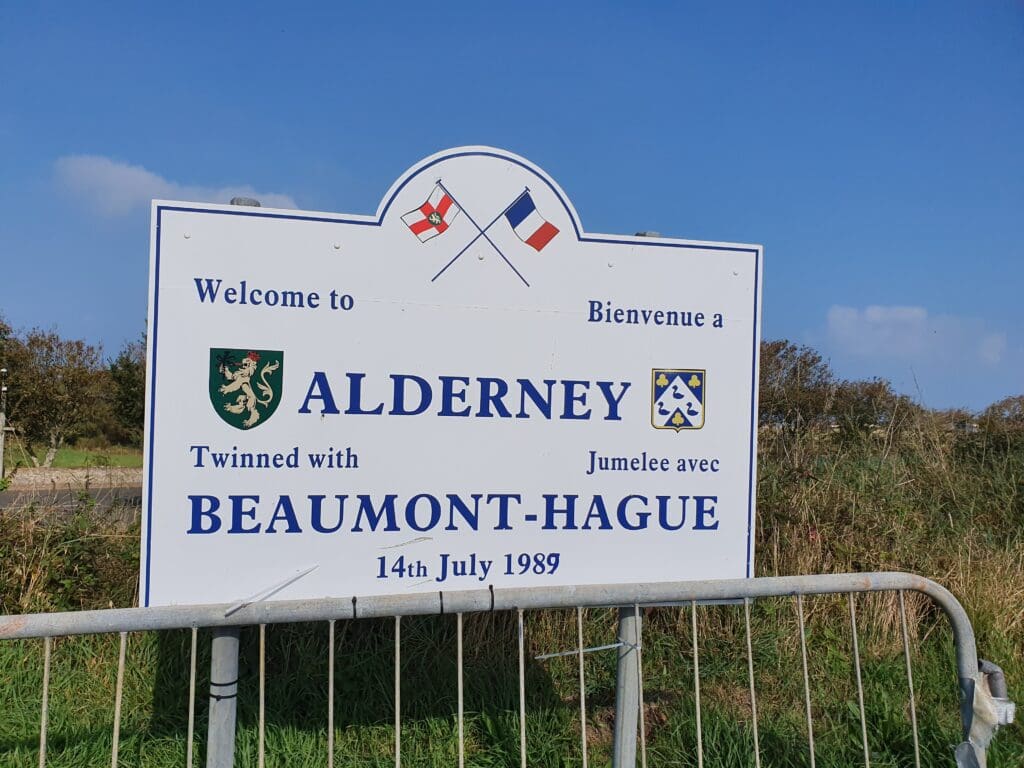
Alderney
Travelling in early October, upon booking the trip in July I had expected my stay in Alderney to be accompanied by a cool wind, sporadic rain showers and some chilliness. However, much to my delight that Saturday happened to be one of the last warm days of 2021, offering a very pleasant breeze with glorious sunshine and few clouds. The negative to this being that I ended up with a slight sunburn by the time I arrived back at the airport. With my only previous visit to the Channel Islands taking the form of a two-hour stop in Guernsey between ferries whilst travelling from St Malo to Poole, Alderney provided me with my first ‘real’ glimpse of this rather interesting and unique part of the British Isles. Aside from the rugged cliffs, sandy beaches and quaint villages, history enthusiasts may be interested in the many signs of the island’s past, with many bleak concrete turrets and pillboxes constructed during the dark years of the German occupation still in place. On a more light hearted note, the island is also home to the Channel Islands’ only railway although I was a little disappointed to find that this had closed for winter a short time before my visit.
Alderney to Guernsey
Following several hours of walking around and basking in the rare October sunshine, I decided to commence the walk back to the airport. Having used up plenty of energy during my stay, and considering my virtually non–existent sleep the previous evening, by this time I was absolutely shattered. Meanwhile, the two coffees that I had had during my time on the island appeared to have little effect in reviving me in time for the short hop to Guernsey. Nevertheless, with few opportunities to nap, I tried my hardest to keep myself awake and alert until reaching my hotel in Guernsey.
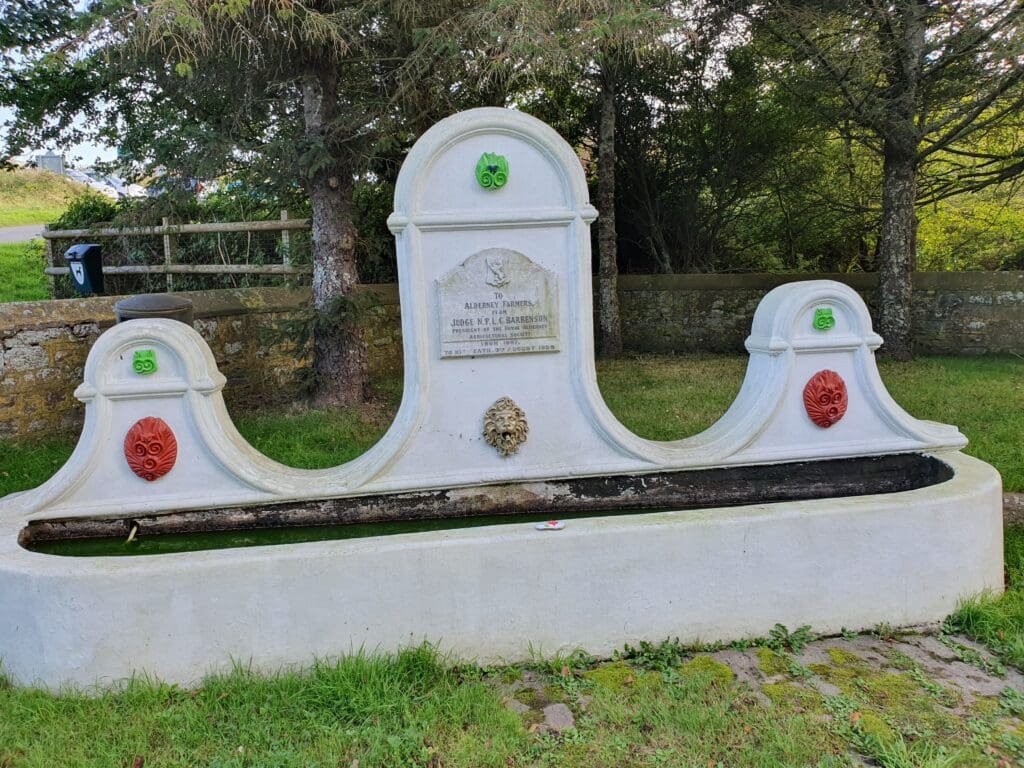
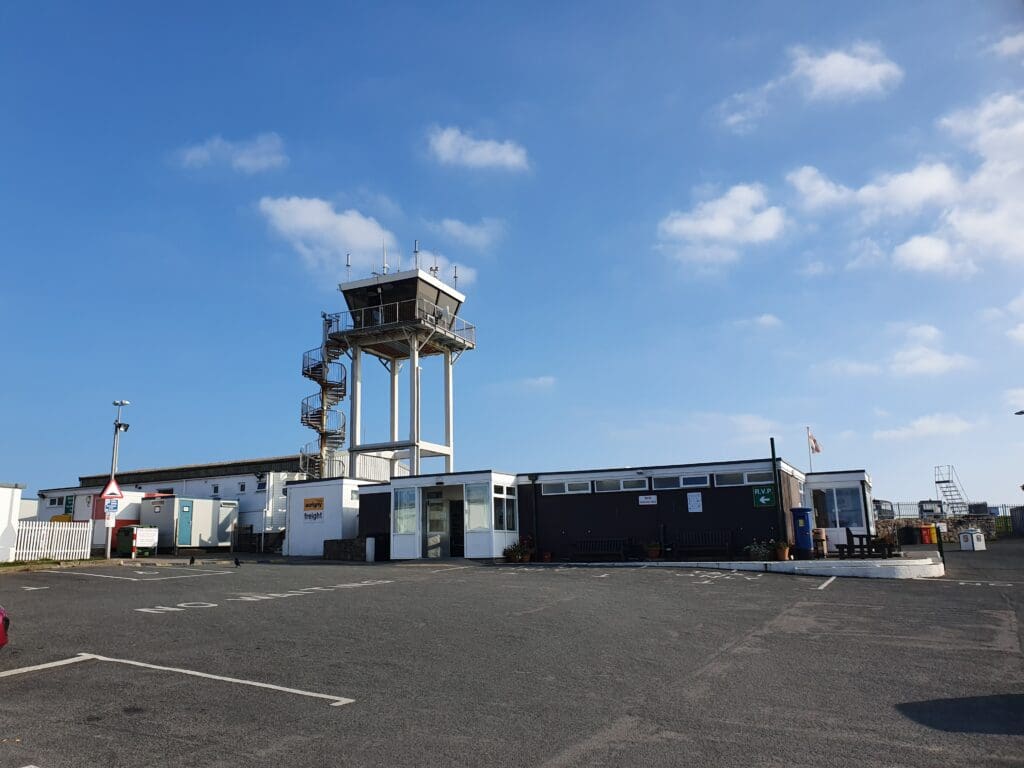
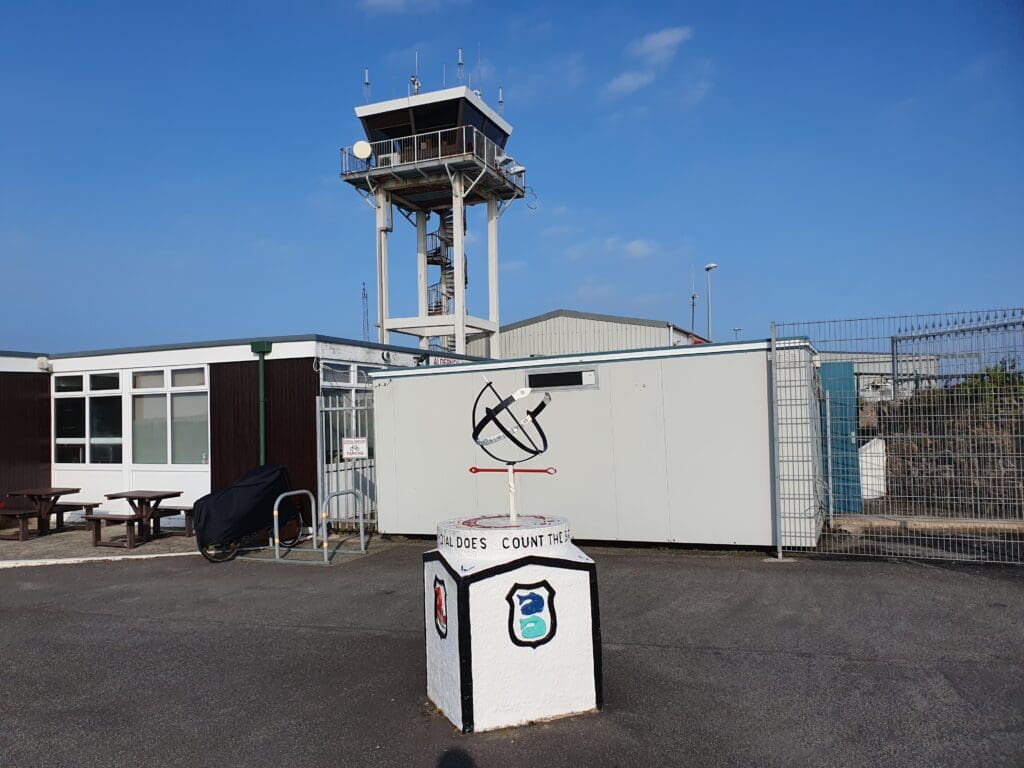
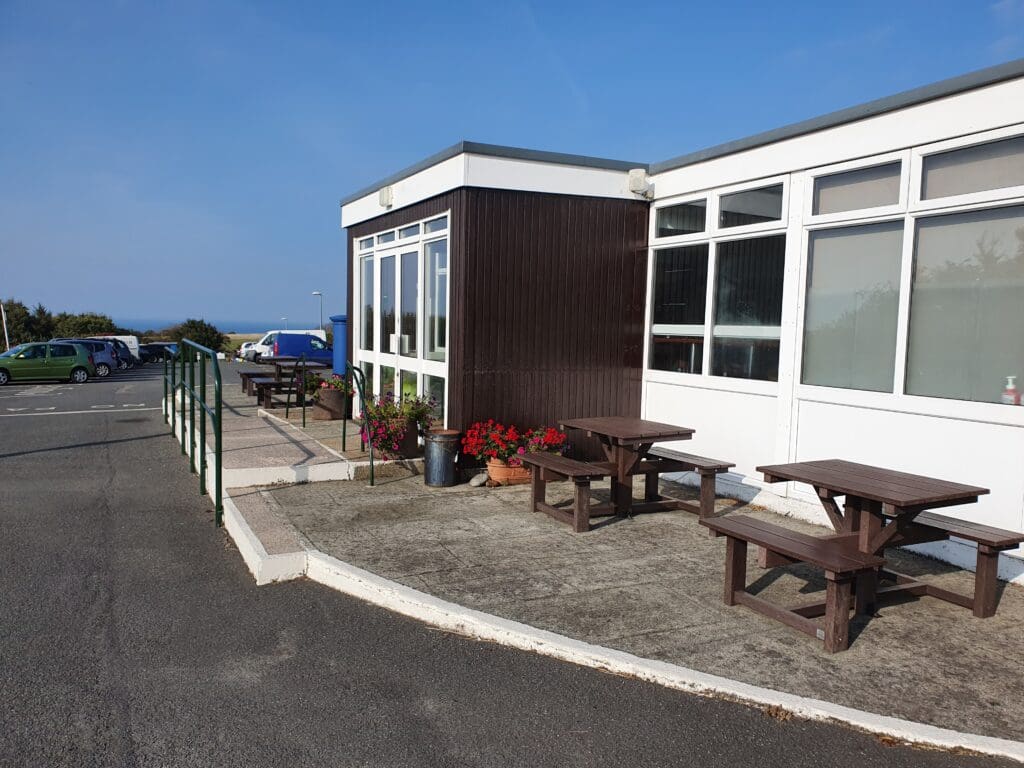
As with many airports that serve small island communities, Alderney Airport is home to neither the largest nor grandest of airport terminals. This takes the form of a single-storey structure covered in wooden panelling, and, were it not for the neighbouring hangar, tall control tower, nor the signage, architecturally the terminal has little to distinguish it from your typical scout hut, or rural community hall. Seeing as I entered the terminal with a little over two hours to go until departure, whilst this was open, this proved to be a ghost town with no passengers and just a single member of staff behind the servery hatch at the terminal’s appropriately named Aviator café eagerly waiting for their next customer.
Upon entering the terminal, I found myself in the first of two small waiting areas – this consisting of several metal benches, a closed duty free hatch, a children’s play area, a shelf of complimentary guidebooks and a selection of photos related to Alderney. Passing through this, I then reached Aurigny’s freight and passenger check-in counters. These are decked out in Aurigny’s old and arguably garish yellow, red and blue colours. Behind these, a host of paintings and photos of Aurigny aircraft could be seen, and I soon spotted a note on the desk that had been left by the agent which informed visitors that they would return at 1630. Next to the café’s servery hatch, a small selection of Alderney themed souvenirs could be seen displayed for sale. Finally, whilst complimentary wifi is offered, a small library of second hand books is provided with customers able to take these in exchange for a donation to the local Lifeboat station.
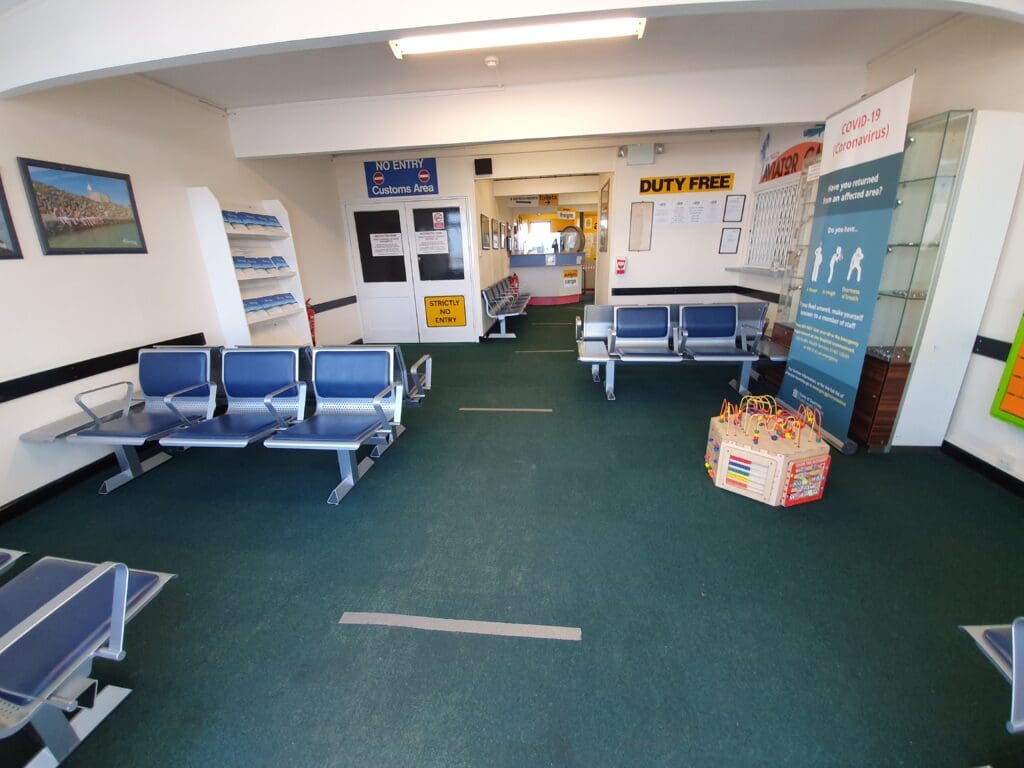

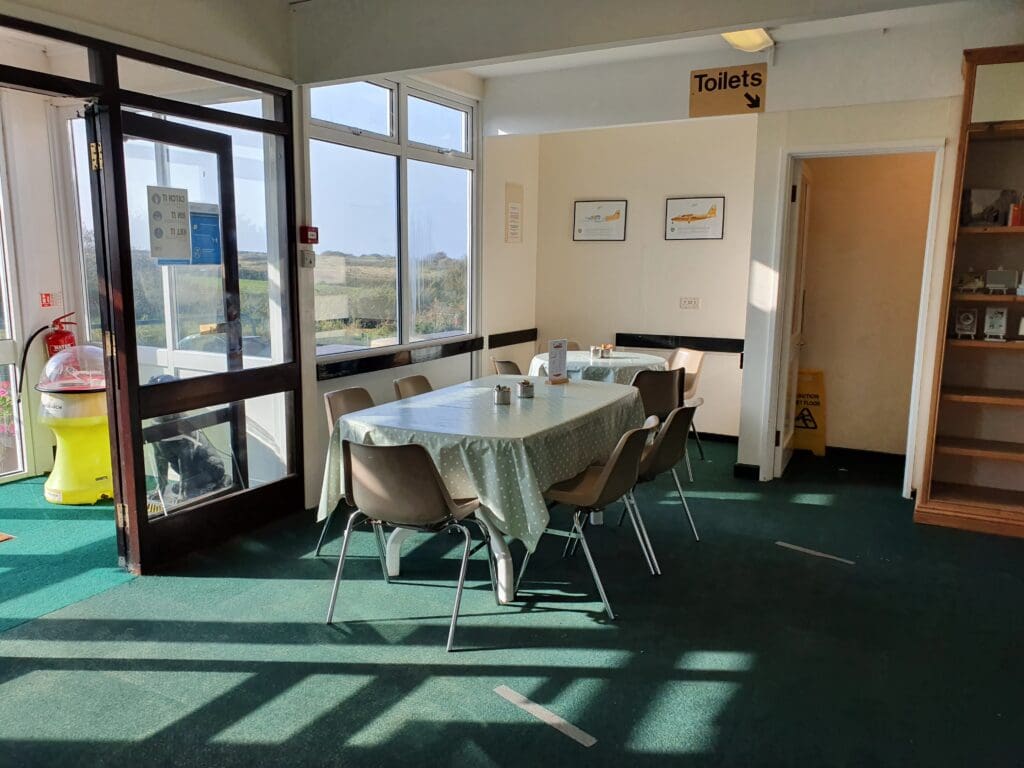
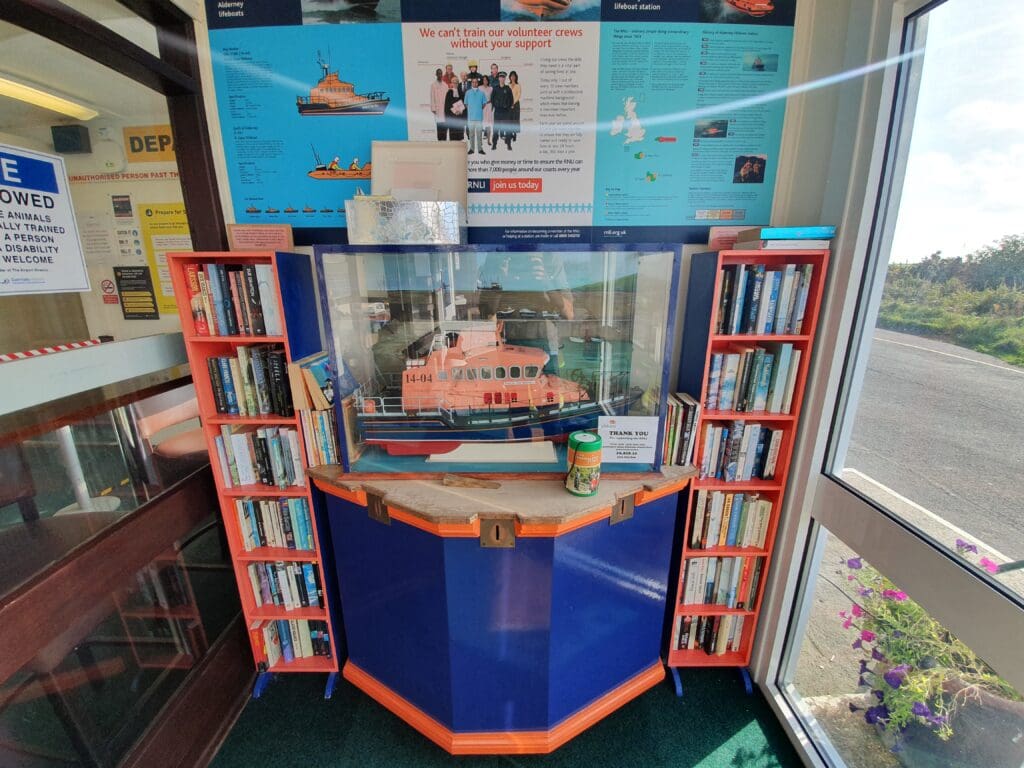
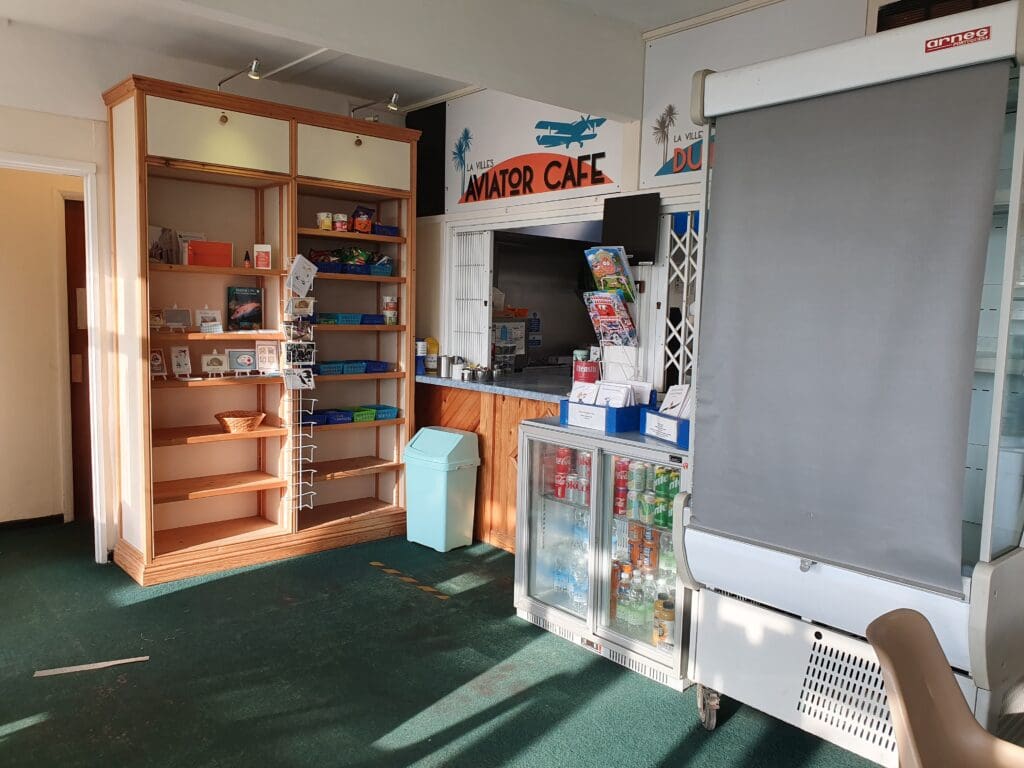
Of all the terminals that I have passed through across the world, I have yet to visit one that provides such an aesthetic mishmash as is offered by Alderney Airport. Examining the terminal’s basic design, whilst this appears to have received various upgrades and modernisations over the years, the terminal appears to be very retro in places – especially the toilets, and I suspect that parts of this have undergone little transformation since the terminal’s construction in 1968. However, that is far from a complaint, with the terminal offering a very unique, homely and endearing feel that is quite simply impossible to generate at a larger airport. Meanwhile, the terminal was in a clean state and provided ample facilities for waiting passengers. Last but not least, passengers also have the option of waiting outside the terminal on benches until they are requested to pass through security – something that I ended up doing to soak up some final sunrays before my flight.
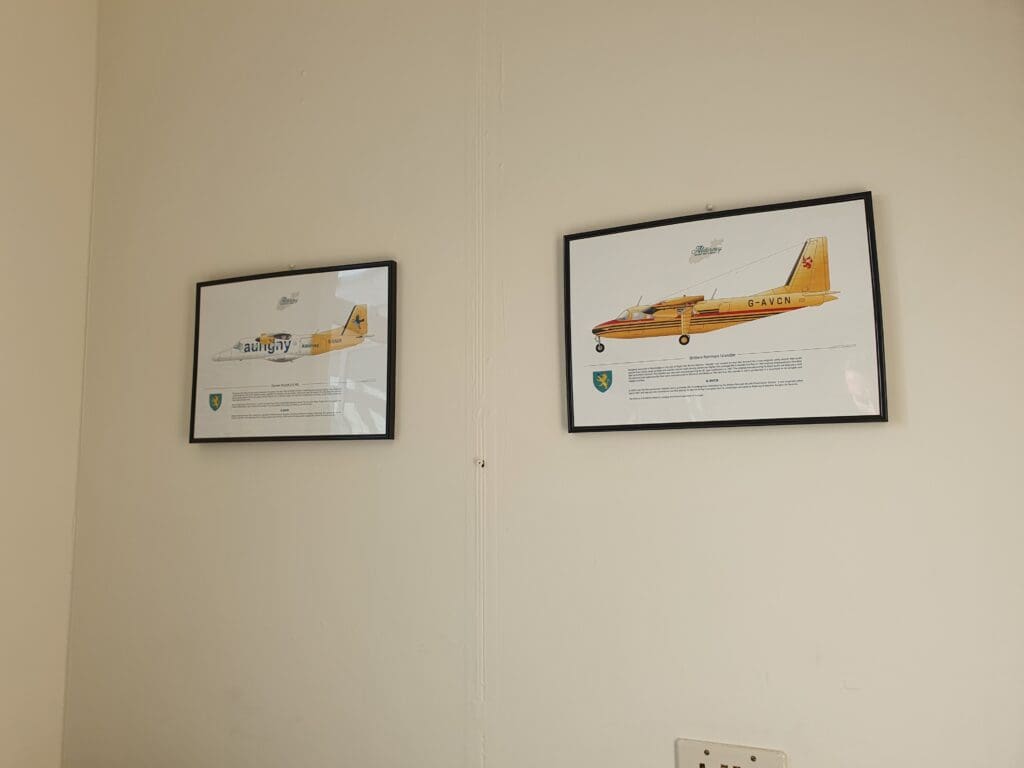
At 1630, the Aurigny check-in agent and a member of G4S security staff appeared at which point a short queue of Guernsey-bound passengers formed at the check-in counter. Following a short wait, I handed over my driving licence to the friendly Aurigny agent and placed my backpack on the scales, before being handed another receipt-style boarding pass. With the check-in process complete, I was then free to do as I wished until Guernsey-bound passengers were requested to head to the security check. Whilst the agent had not mentioned a time for this next step, seeing as the boarding time was listed as 1720, I assumed that this would occur then if not slightly before. Nevertheless, not wanting to venture too far and miss my flight, I hovered around the terminal – waiting both in and outside of this.
At 1647, the inbound Dornier touched down in Alderney at the end of its flight down from Southampton. Much to my delight, this was not the same aircraft that I had flown earlier in the day and I would instead get the opportunity to sample both of the two Dornier 228s in Aurigny’s fleet. That evening, Dornier 228-212NG G-OAUR would be operating the flight to Guernsey. This particular aircraft was manufactured by RUAG in 2012, making it around nine years old at the time of my flight. Once manufactured, this aircraft commenced its life with the German registration of D-CBNF, however, I am not entirely sure what the aircraft did under this guise, with little information available on the aircraft during the first years of its life. In December 2015, this aircraft was ferried across the North Sea to Southampton, before it made its way onwards to the Channel Islands where it soon got to work as Aurigny’s first Dornier 228NG. As with the Dornier 228 that I had flown earlier in the day, this aircraft had spent the entirety of the week shuttling between Alderney, Guernsey and Southampton.
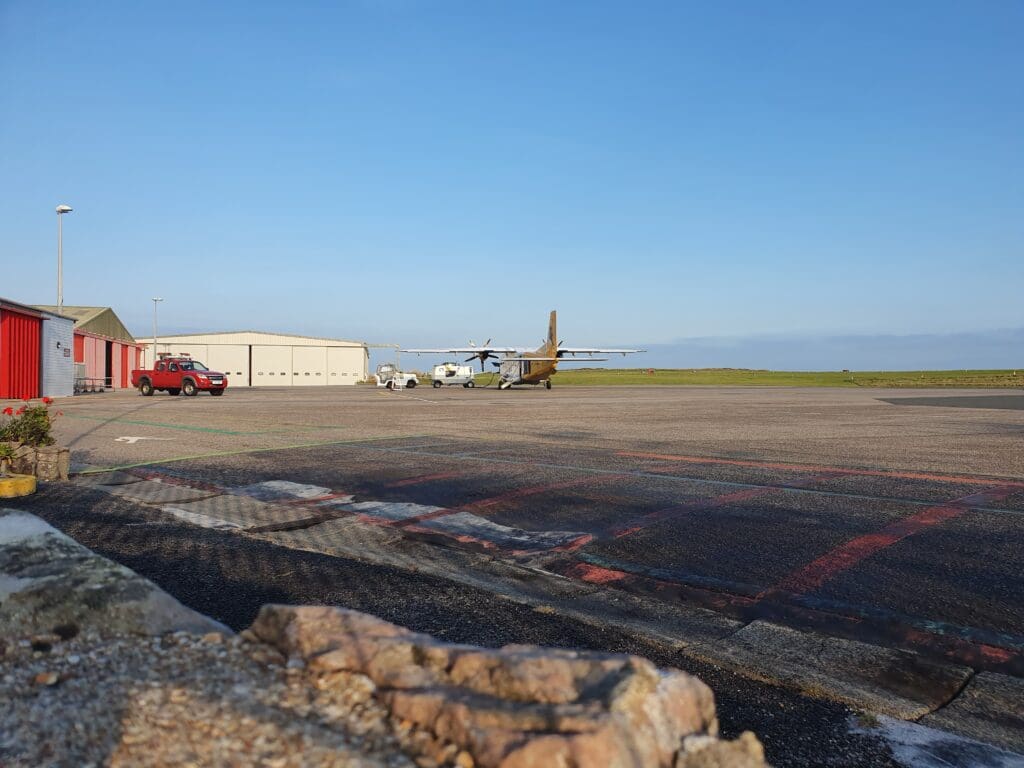
Five minutes before the scheduled boarding time, at 1715 all those heading for Guernsey were invited to head through to the security check. Joining a short queue, after a short amount of shuffling I reached the front of this and received a warm and friendly greeting by the friendly G4S agent whose accent suggested they hailed from the other side of the Atlantic. Whilst it would have likely been incredibly interesting to hear how they ended up on this tiny island off the Normandy coast, I instead simply followed their instructions, handing over my bag before walking through a metal detector. Seeing as the terminal appeared to lack an x-ray, all bags were thoroughly searched by hand, and after no stone in this had been left unturned, I was wished a nice flight and advised to head through to the airside area.
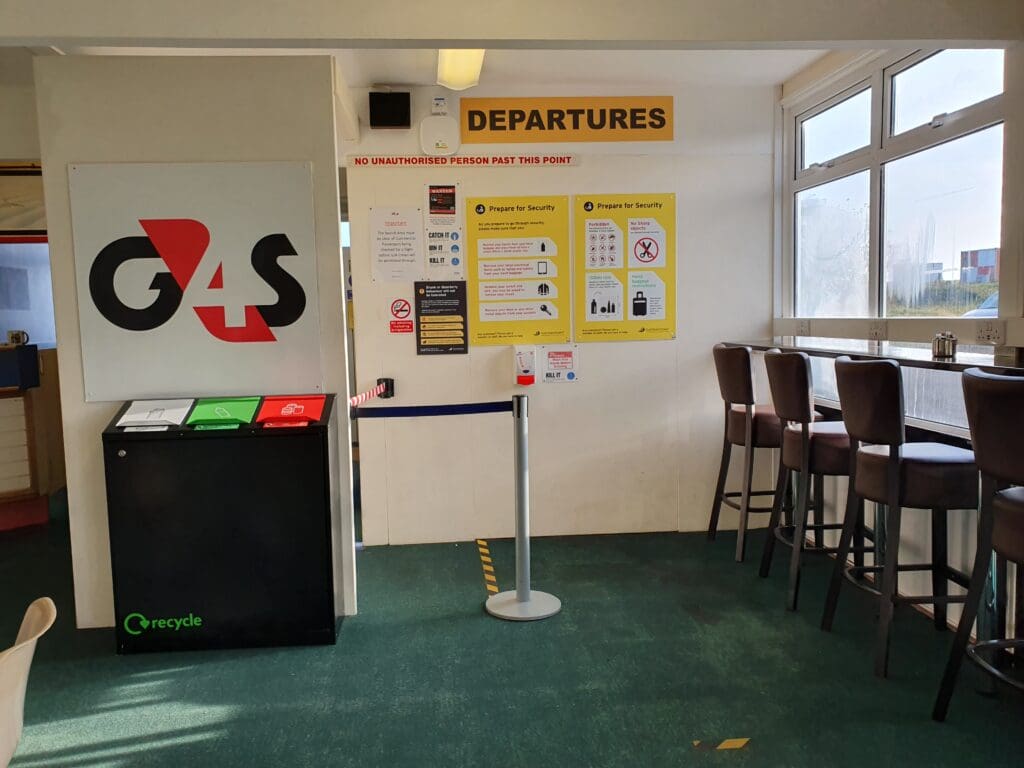
Continuing with the somewhat unorthodox nature of Aurigny Airport, the airside departure area consists of a small outdoor yard with a very battered-looking portacabin inside of which several seats and a television, which I assumed was used for safety briefings, could be found. Once all nine passengers on the flight had made it through to the airside area, there was some waiting required before the Aurigny agent appeared at 1725.
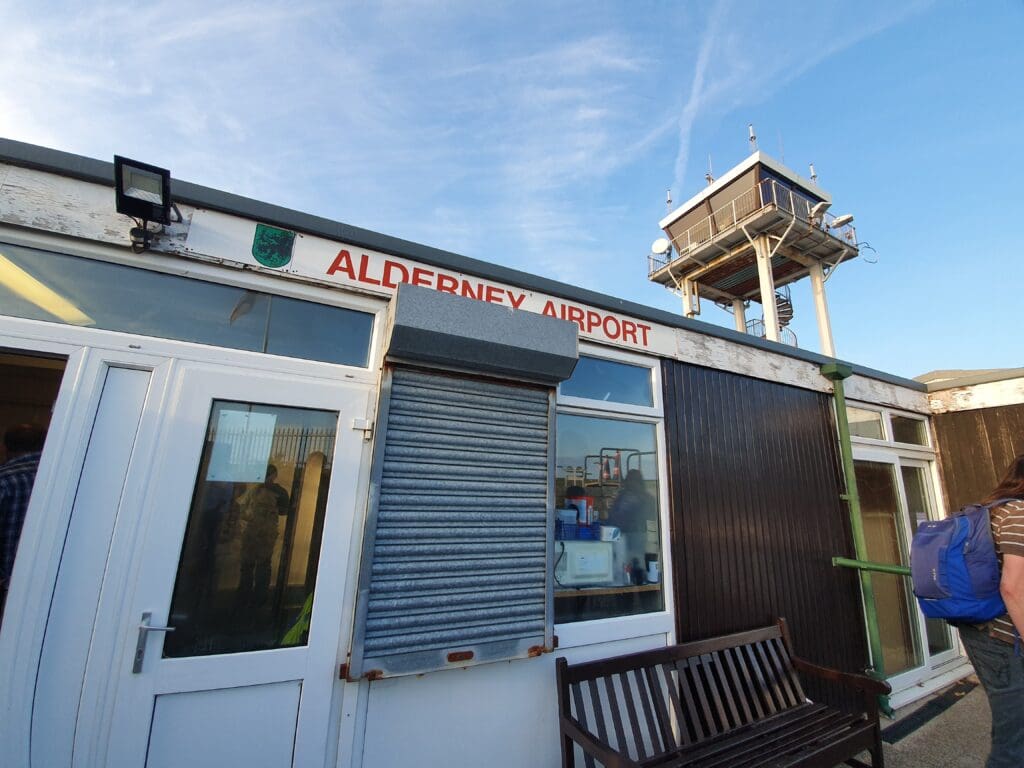



Expecting that they would lead us into the portacabin to watch the safety video, once the two pilots (who were a different crew to those that had operated the flight down to Alderney) had made their way back onto the aircraft via their own cockpit doors, the agent advised passengers to head over to the aircraft. In order to ensure that social distancing could be followed as much as possible, those in rows 1 to 4 were requested to make their way over to the aircraft first, however seeing as this consisted of only four passengers, this was immediately followed by those in rows 5 and above.
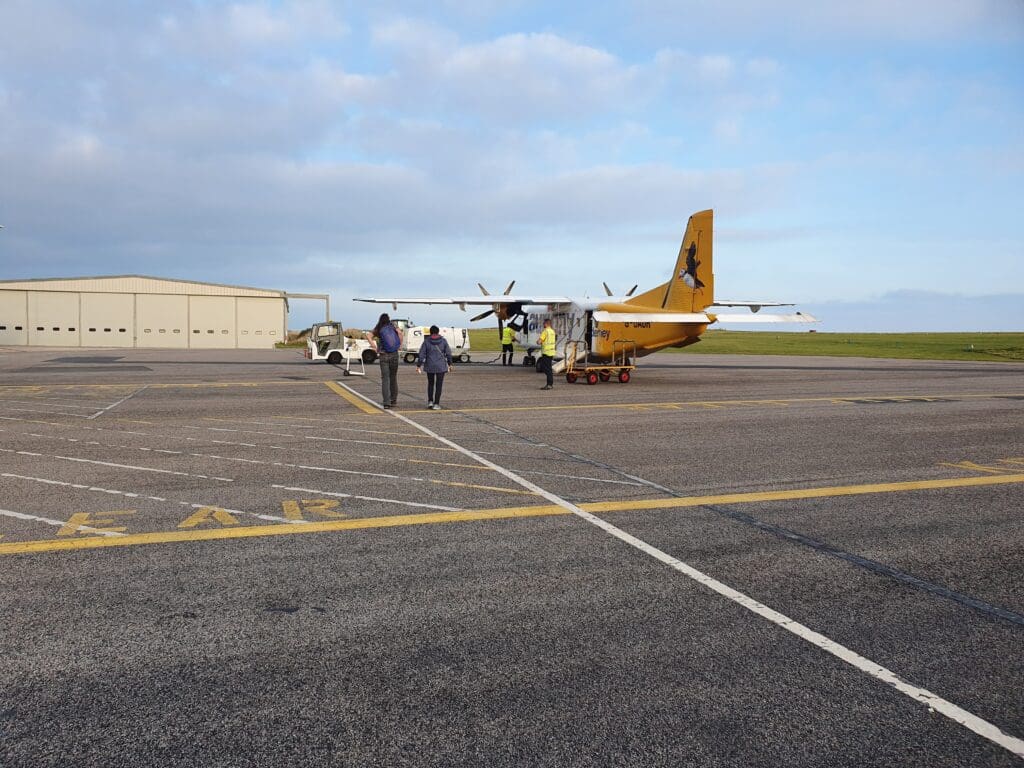

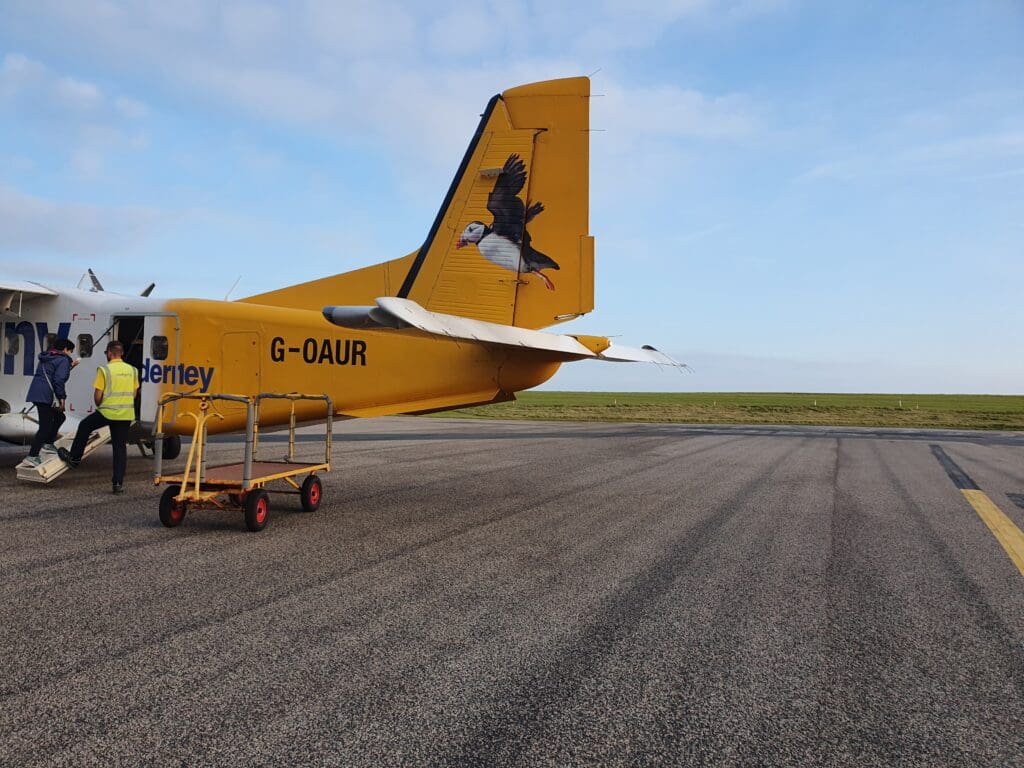

As I cautiously clambered up into the Dornier 228 once again and squeezed through the rear entry door, it soon became evident that there were multiple differences between the cabin of this aircraft and the Dornier that I had flown that morning. Whilst the plastic cabin panelling and trimmings on this aircraft appeared identical to those on the newer Dornier, the seats were of a completely different style. On the older aircraft, these appeared to be slightly more ‘traditional’ in their design thanks to their chunky appearance. However, this was a little misleading as once I sat down, I found the seats to be a little firmer than those onboard the newer aircraft. Onboard, each seat was covered in a (faux?) blue leather covering, topped with a red (faux?) leather antimacassar on which ‘aurigny.com’ was imprinted. Unlike the newer Dornier, this older example featured plenty of marks and scratches on the seat, the plastic panelling and the window, although the cabin was in a clear and presentable state. Finally, not wanting to end things on a negative note, I was pleased to find that the amount of legroom these seats provided did seem to be rather good for such a small regional aircraft and the seat did feel rather spacious.
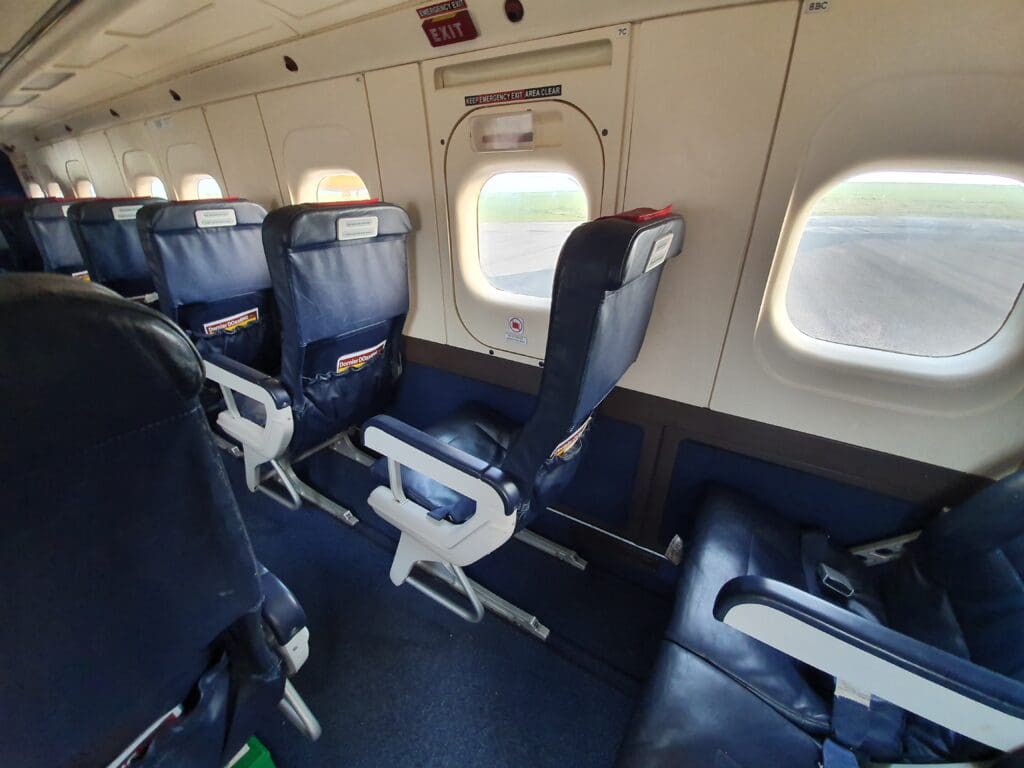

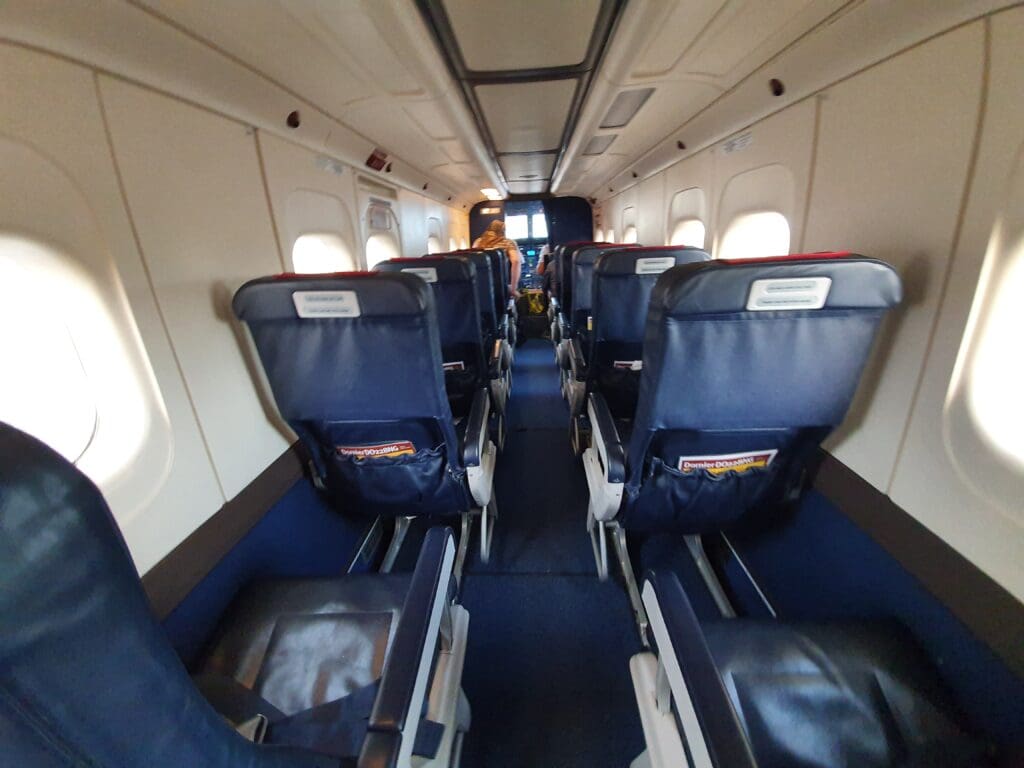
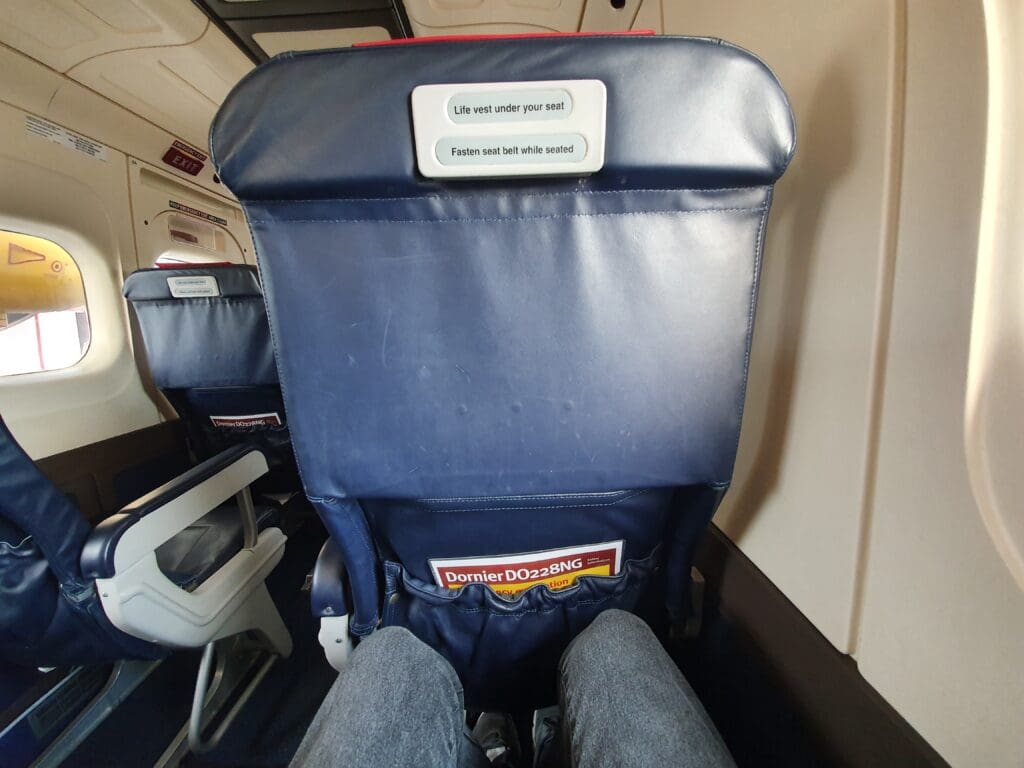
Within a couple of minutes, the nine passengers and their luggage had made it onto the aircraft and all doors were closed in preparation for our departure. At this point, the Captain, who was perhaps the speed-talking champion of the Channel Islands, turned around and undertook an impressively quick welcome announcement. During this, they informed us all of the ten-minute flight time, and requested us to keep our seatbelts fastened for the entire flight before finishing this by advising that the flight would likely arrive in Guernsey ahead of schedule. Much to my surprise, especially given the lack of a safety video on the ground in Alderney, other than the seatbelt warning, nothing by means of a safety message was delivered that evening.

Turning my attention outside, the ground crew could be seen clearing their equipment away from around the aircraft before a few clunks and whinings could be heard before the two Honeywell engines fired up again in preparation to power us southwards down to Guernsey. Once these had fully awoken, the pilots ran through their final checks and after a couple of minutes the Dornier powered itself away from the apron and commenced the very short journey over to the runway. Once there, with no other traffic around, the Dornier turned right and began to backtrack to the runway’s western end before turning around.
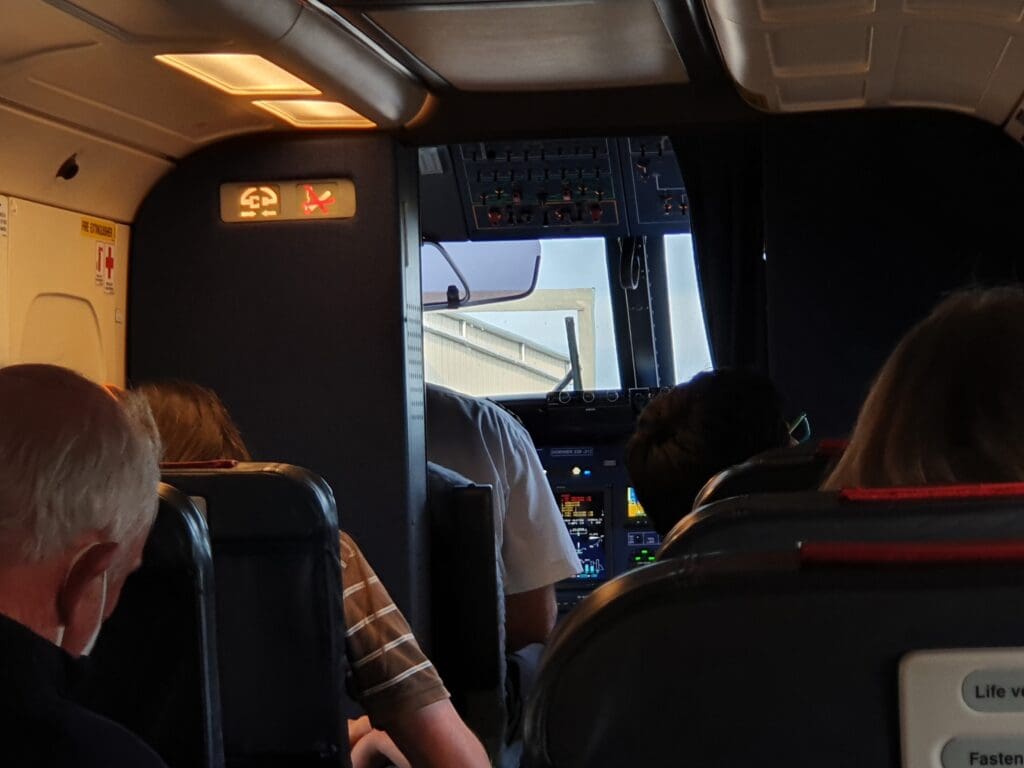

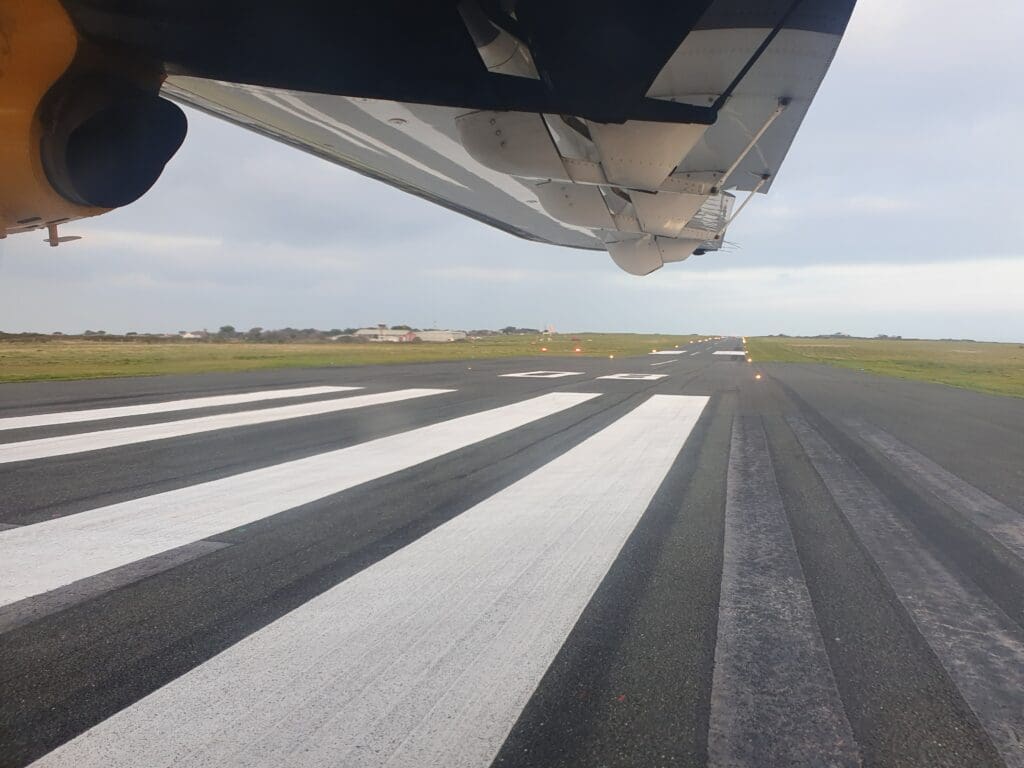
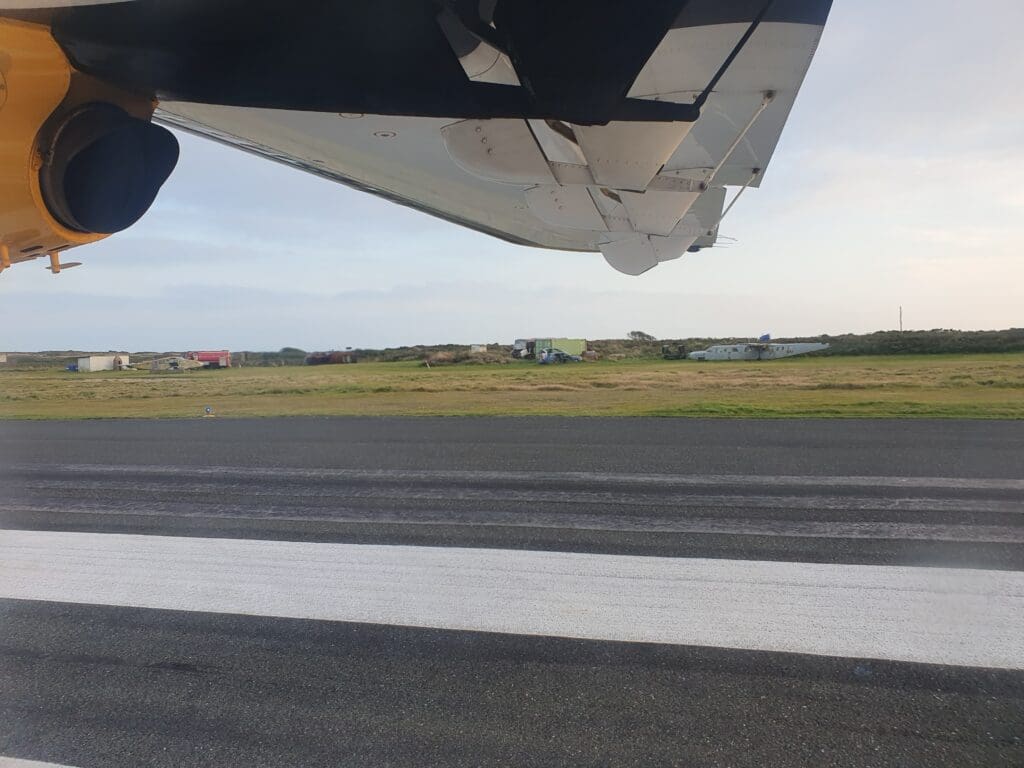
At 1736, four minutes ahead of the Guernsey service’s scheduled departure time, the small cabin was filled with a deafening roar and the Dornier commenced its short and powerful takeoff roll down Runway 08. During the first few seconds of this, I caught sight of Alderney’s two mothballed aircraft – a Piper Aztec and a Trislander. As had been the case that morning in Southampton, the Dornier rocketed up into the skies in no time, leaving the ground as we crossed the intersection between the airport’s grass and asphalt runways.
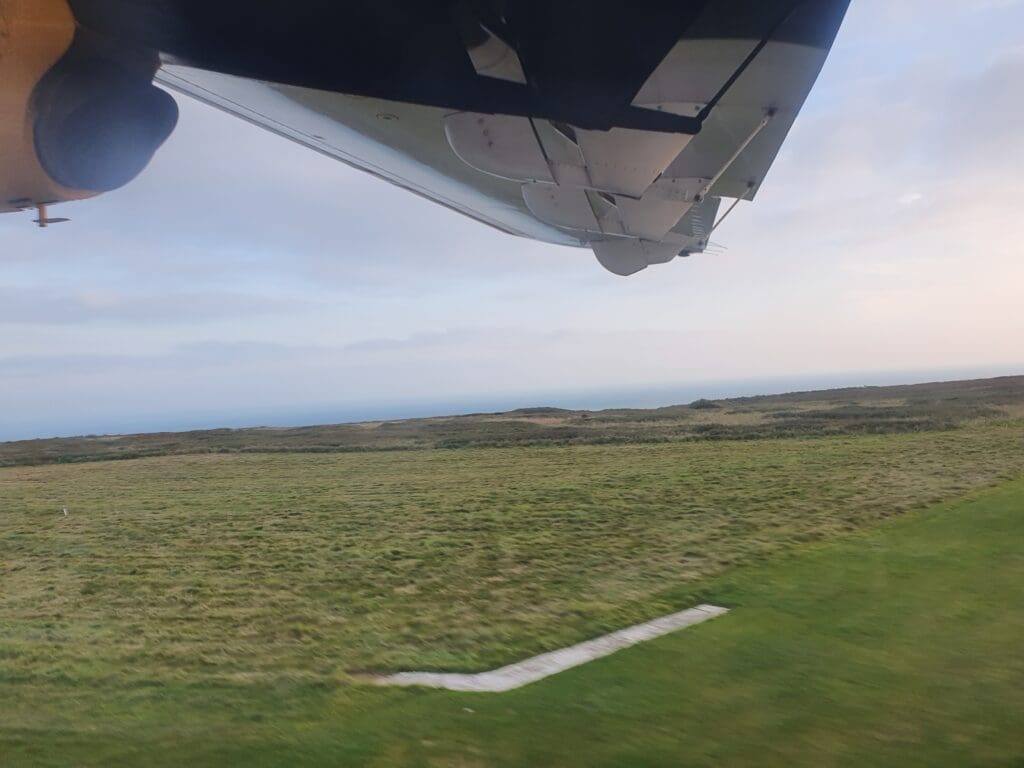

Almost as soon as we were up in the air, the blue waters of the English Channel off Alderney’s south coast could be seen, with these separated from the airport by a host of green fields. Once the gear had retracted up into the fuselage with a firm clunk, the aircraft crossed over the rocky cliffs and gently banked before rolling out on a southeasterly course that would place the aircraft on the approach for Guernsey Airport.
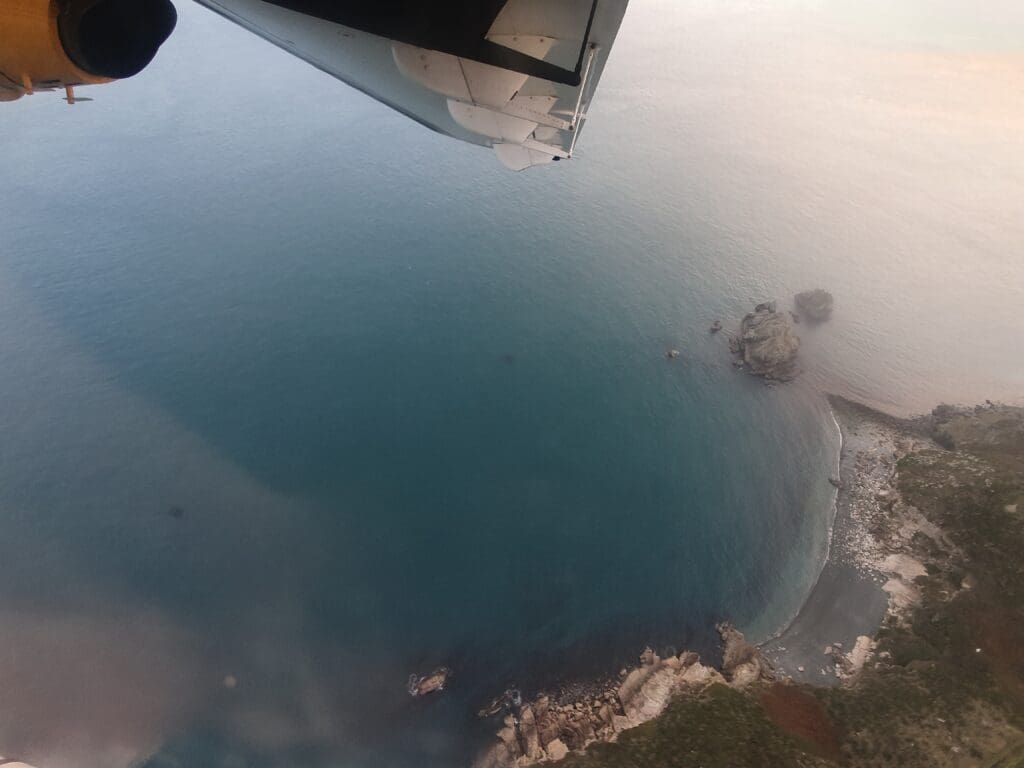
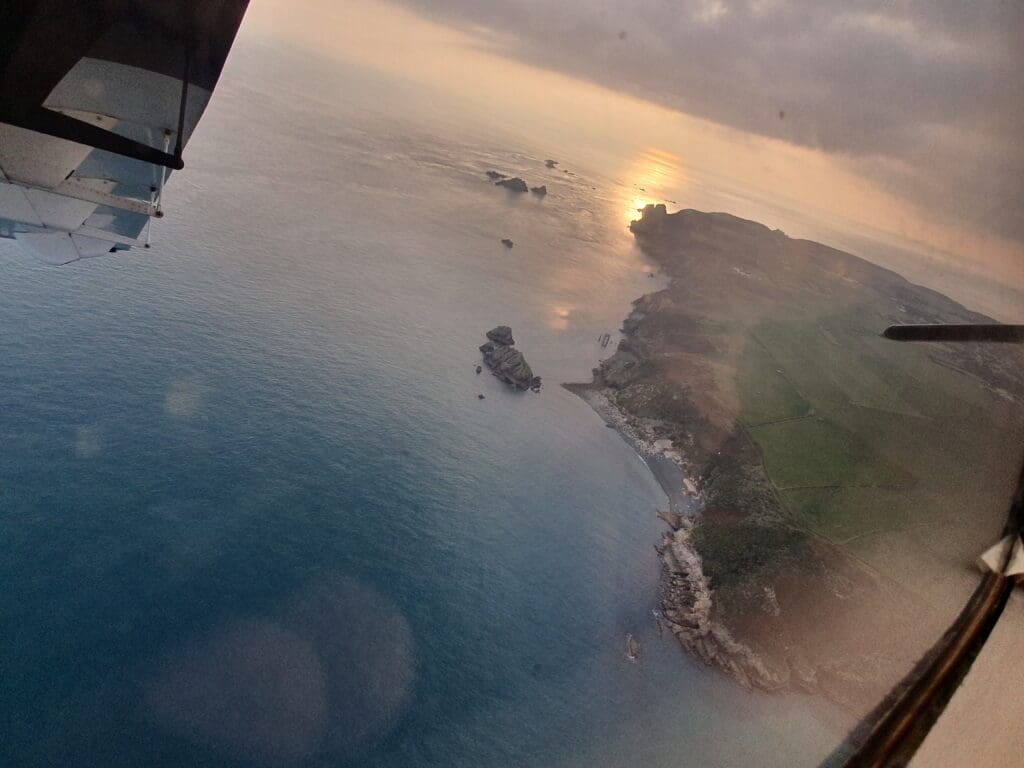
Given the short distance between Alderney and Guernsey, the Dornier soon settled at its low cruising altitude of 1,600 feet which allowed for a good view of passing waves below. However, other than these, sitting on the right hand side of the aircraft, little could be seen until we were established on final approach for Guernsey Airport. Meanwhile, those on the opposite side of the cabin were offered views of Guernsey’s northern coastline for much of the flight. Just under ten minutes after taking to the skies, the Dornier turned onto the base leg for Guernsey Airport’s Runway 09, which was followed a short time later by another turn to place the aircraft onto its final approach. At this point, a loud ding rang out through the cabin which was followed by a short pre-arrival announcement by the first officer, requesting that all passengers fasten their seatbelts.
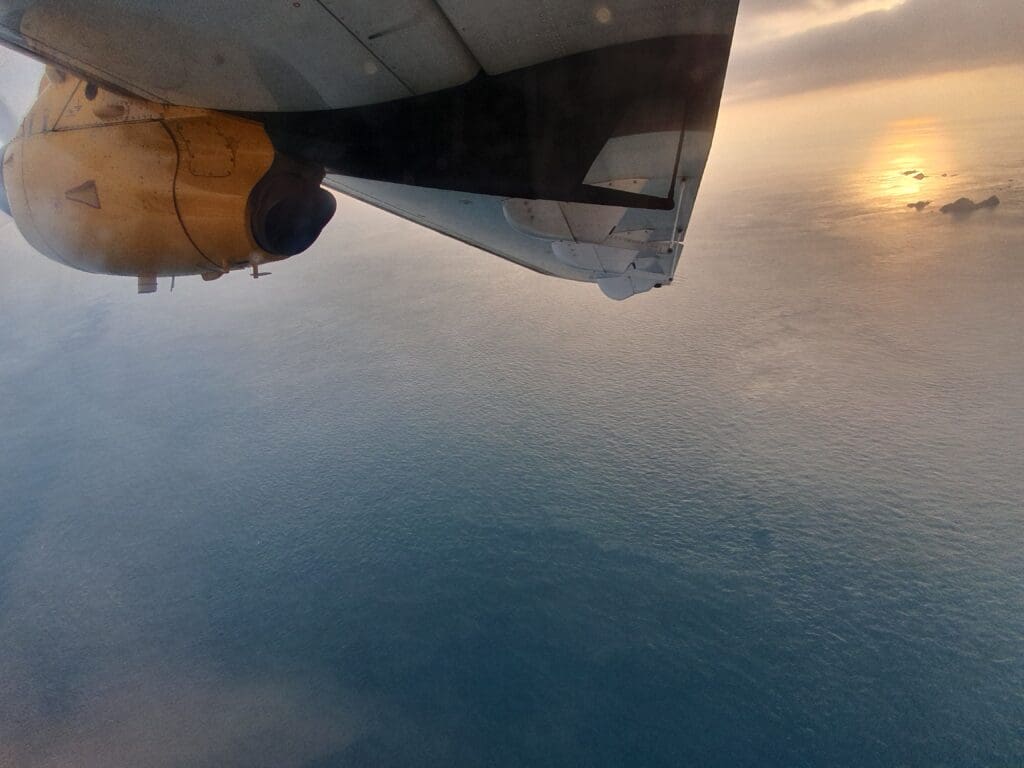
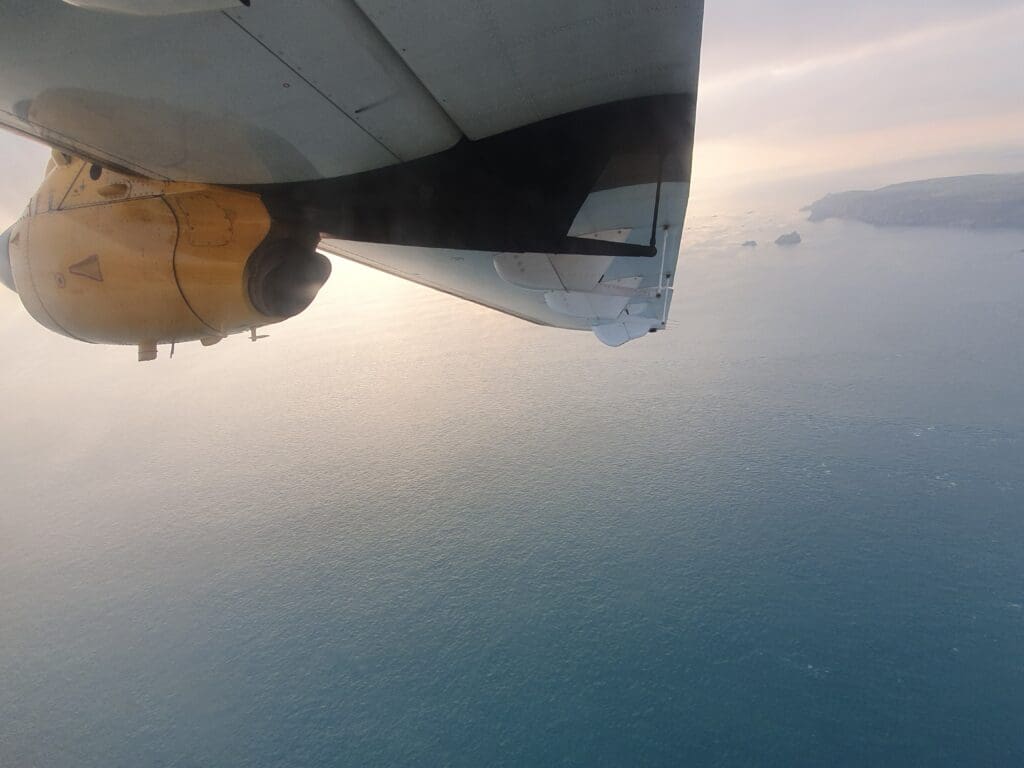
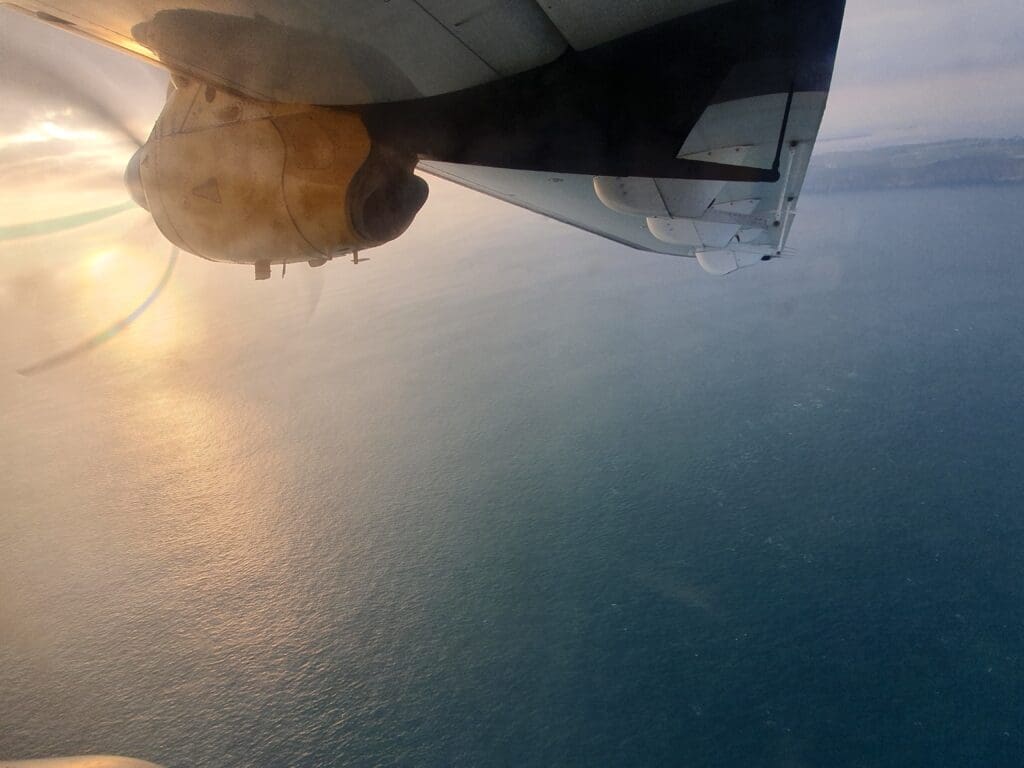

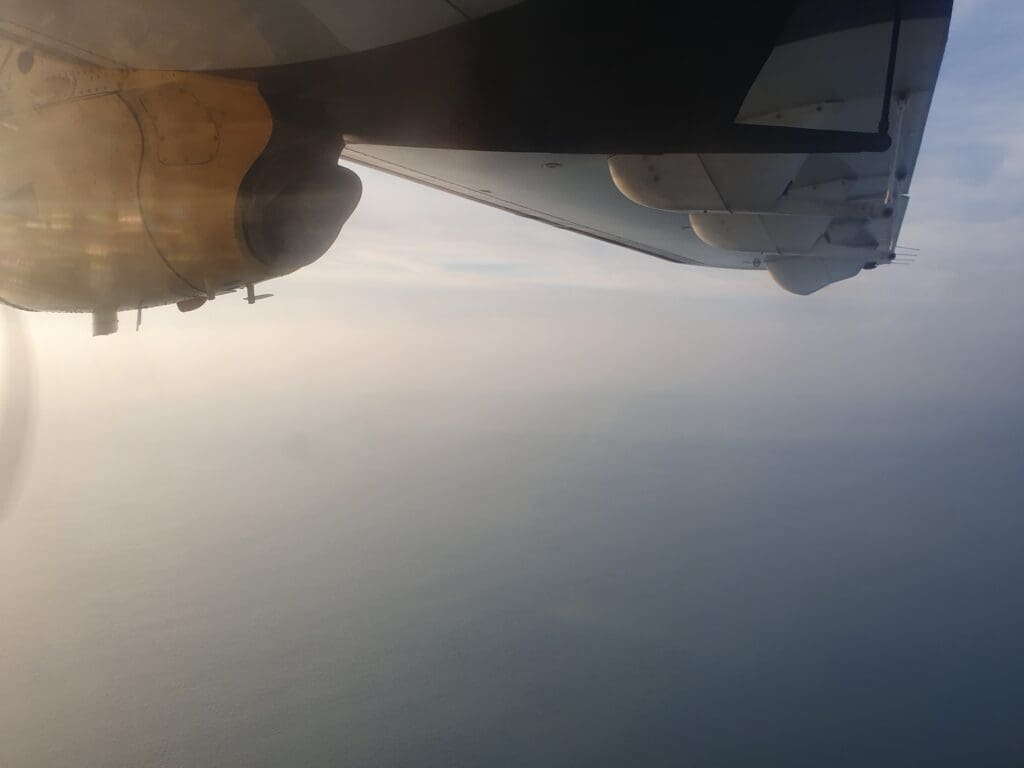
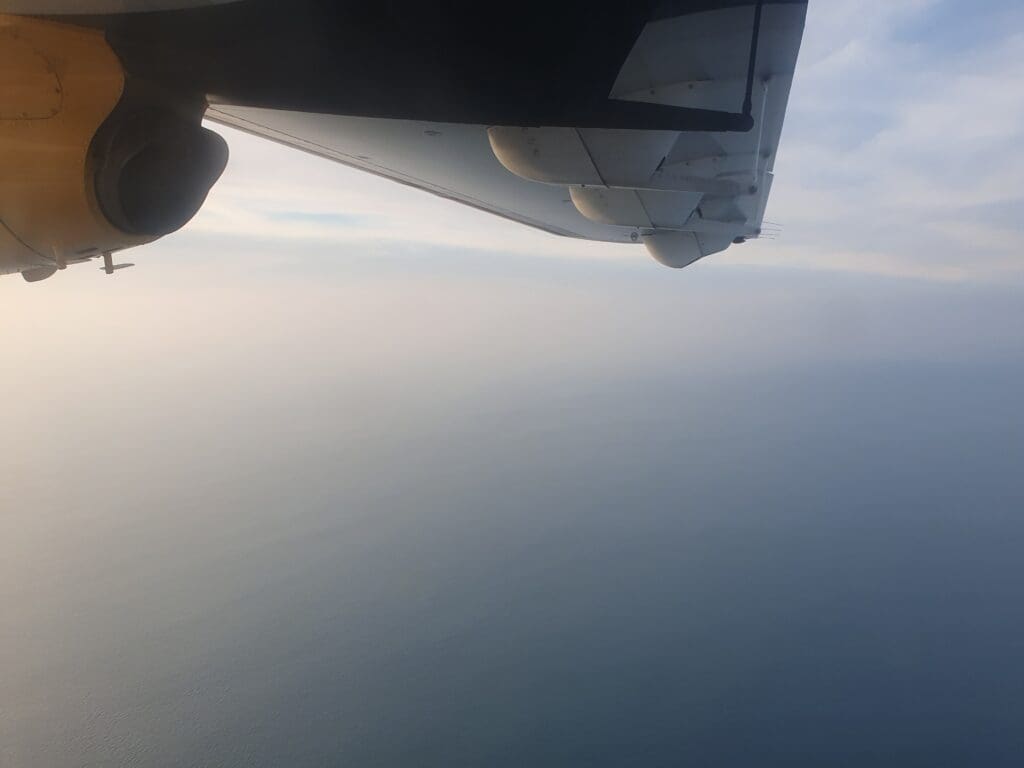
A minute or so after the aircraft was pointed in the direction of the airport, Guernsey’s southwestern tip, Pleinmont Headland, appeared. At this point, the gear fell into position with another clunk and the Dornier crossed over the coastline and descended over green fields and small villages. As the aircraft journeyed towards the airport, various forts could be seen as could the distinctive steeple of Torteval’s church, the tallest steeple on Guernsey.
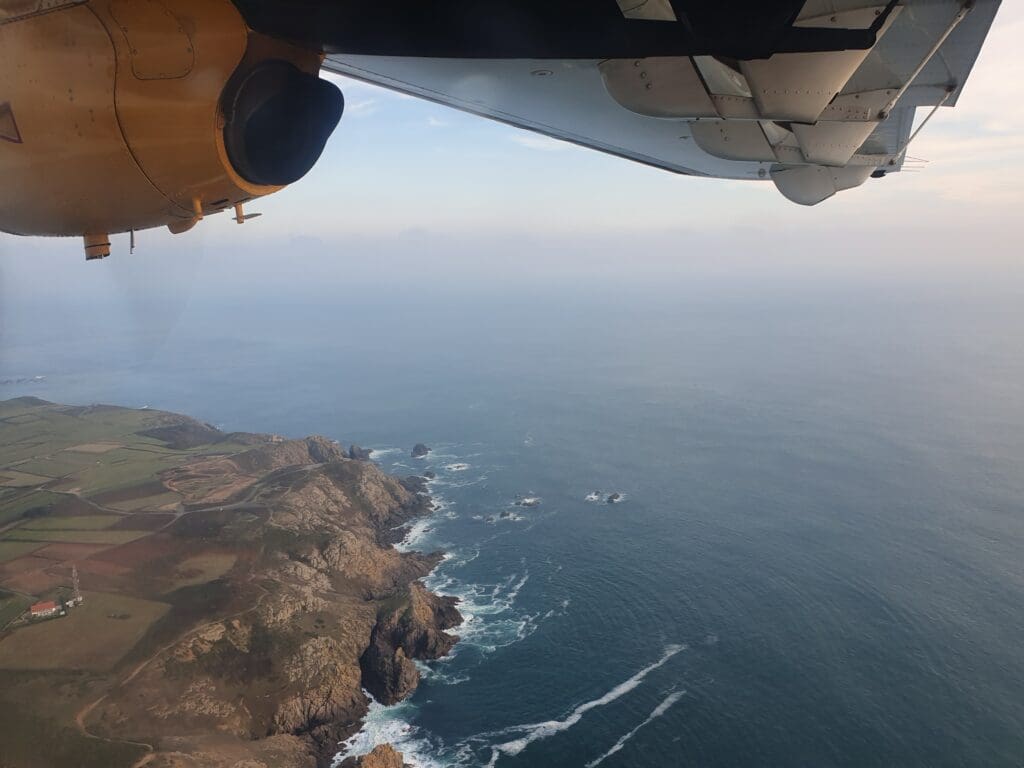
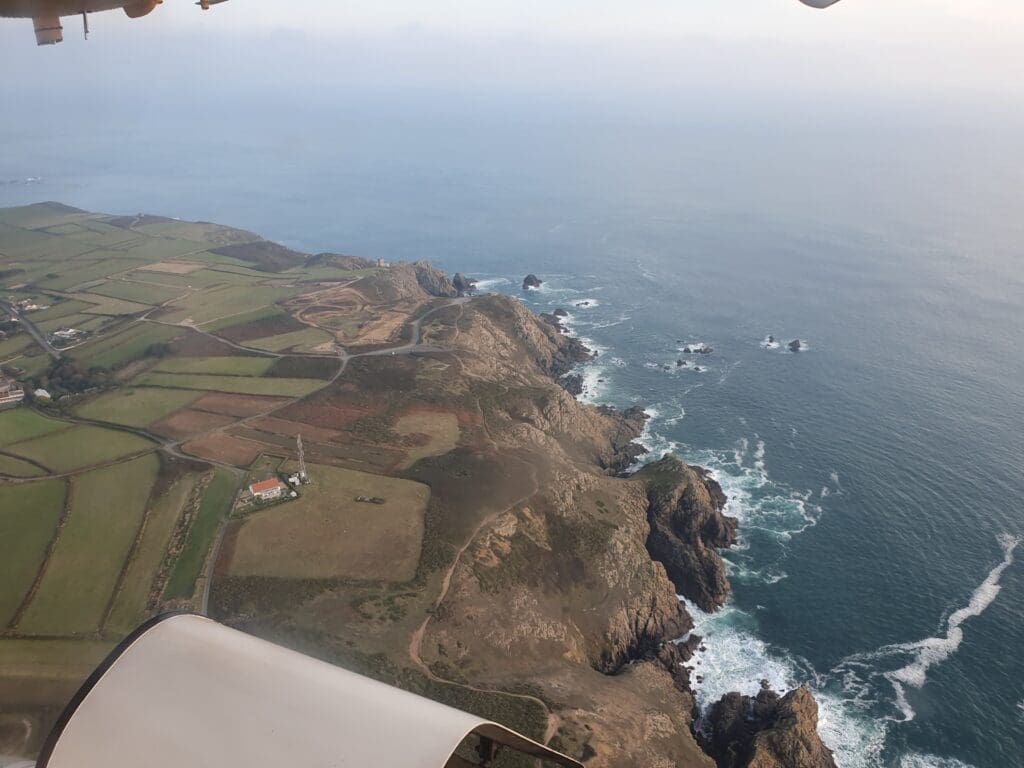
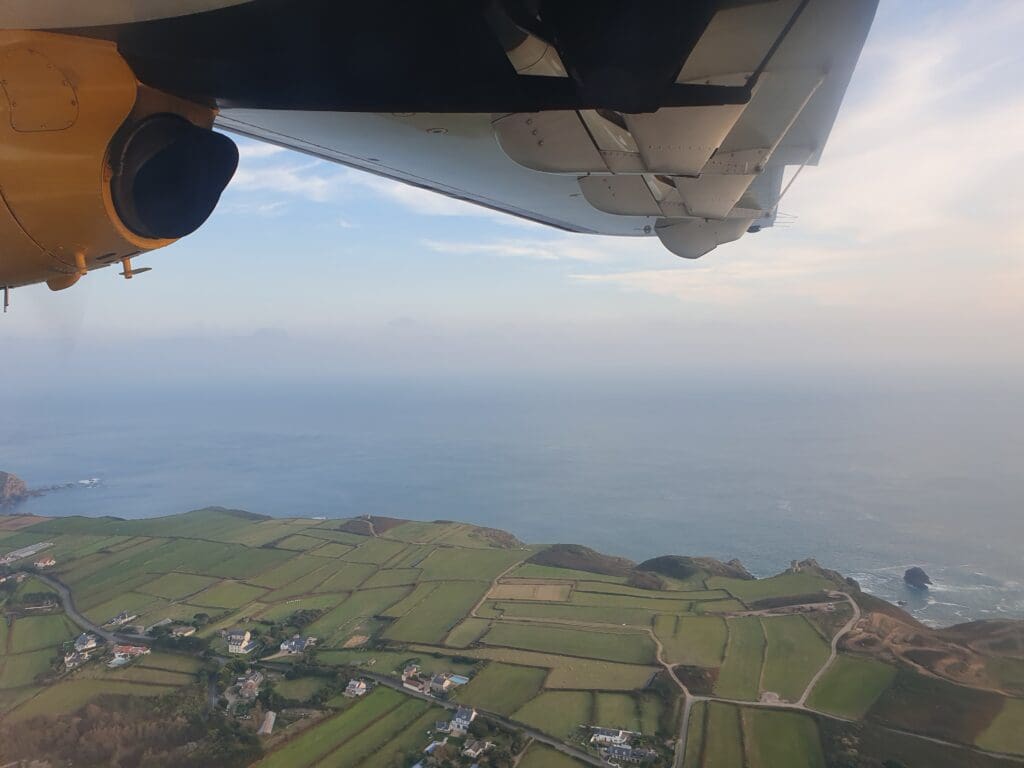
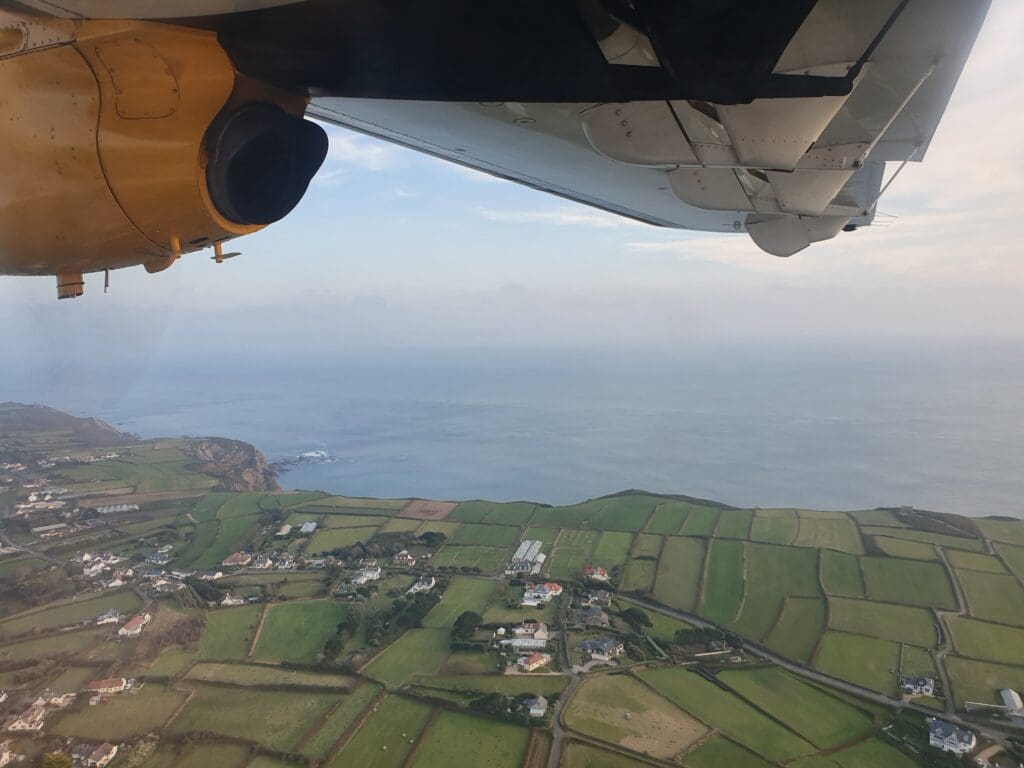
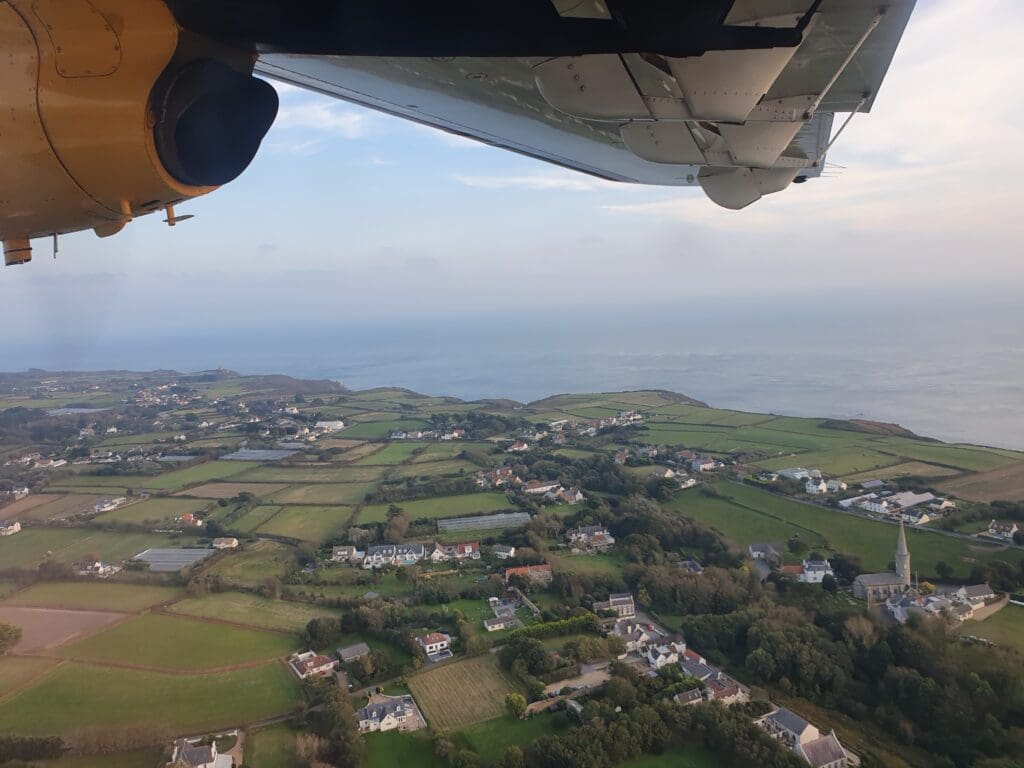
At 1751, the turboprop whizzed over the airport’s western perimeter and returned to the ground wheel-by-wheel, first up was the left wheel with a firm bump, then the right, followed by the nose gear. Given the length of the runway at Guernsey, there was no need for the pilots to make use of the Dornier’s ability to come to an abrupt halt and instead, the aircraft gently decelerated gently in order to minimise taxi time. Outside, private aircraft ranging in size from the Rutan Long-EZ to an American-registered Hawker Beechcraft 900XP could be seen before the airport’s modern terminal appeared. Outside this, a mixture of Aurigny and Blue Islands’ ATR turboprops could be seen waiting for their next flights, as could the former carrier’s sole Embraer – an aircraft that I would take up to Gatwick the following afternoon.
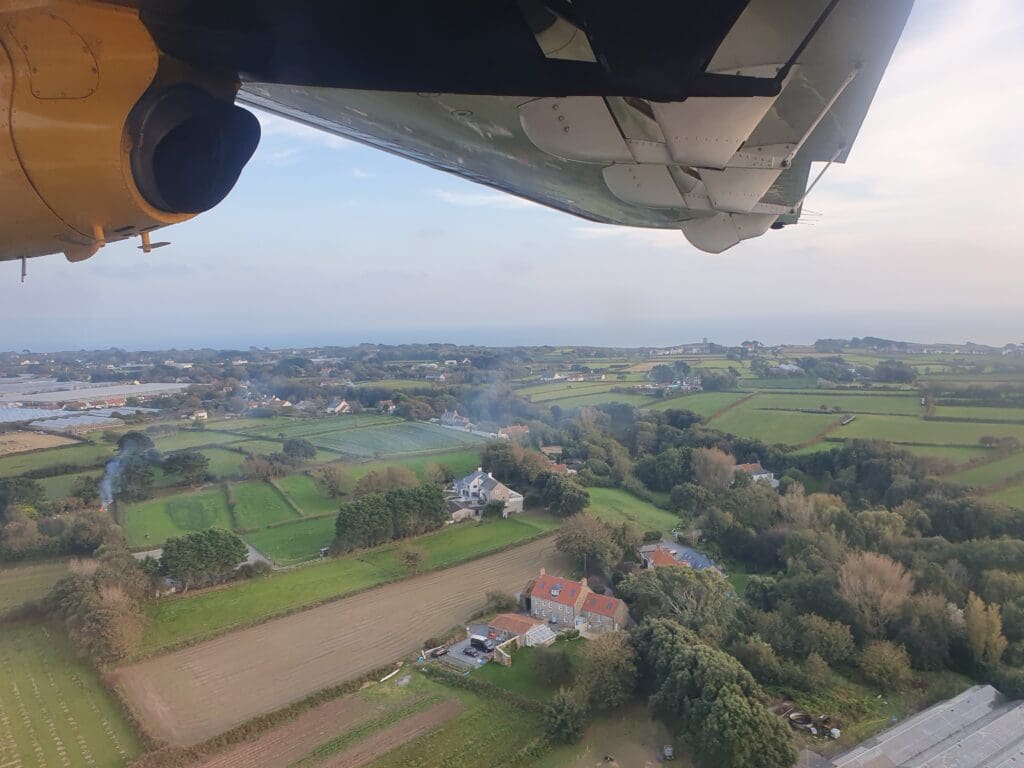
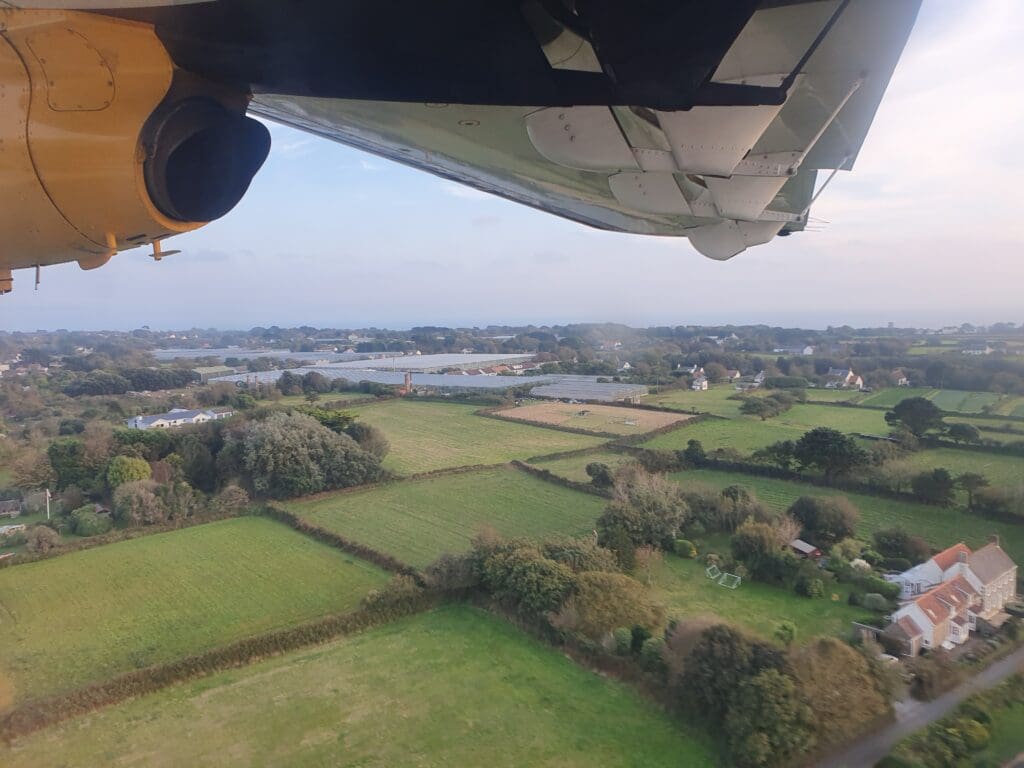

After vacating the runway, the aircraft made a very short taxi over to the terminal where it cautiously pulled in between the Embraer and a Blue Islands ATR-72 before performing a u-turn and coming to a halt. Once stopped, the engines spooled down immediately and the cabin was plunged into silence. Having come to a halt at 1753, as per the captain’s initial welcome speech, the flight had made a punctual arrival into Guernsey, seven minutes ahead of schedule. Following a quick final speech by the captain who wished us all a lovely evening, the main cabin door was opened and disembarkation commenced.
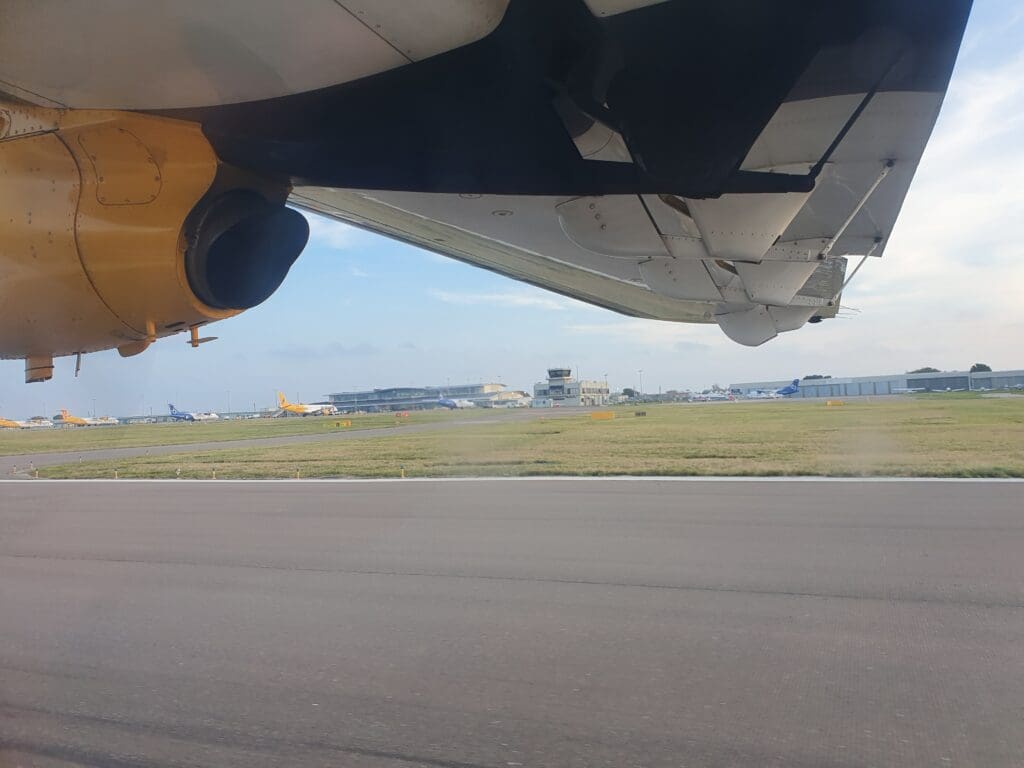
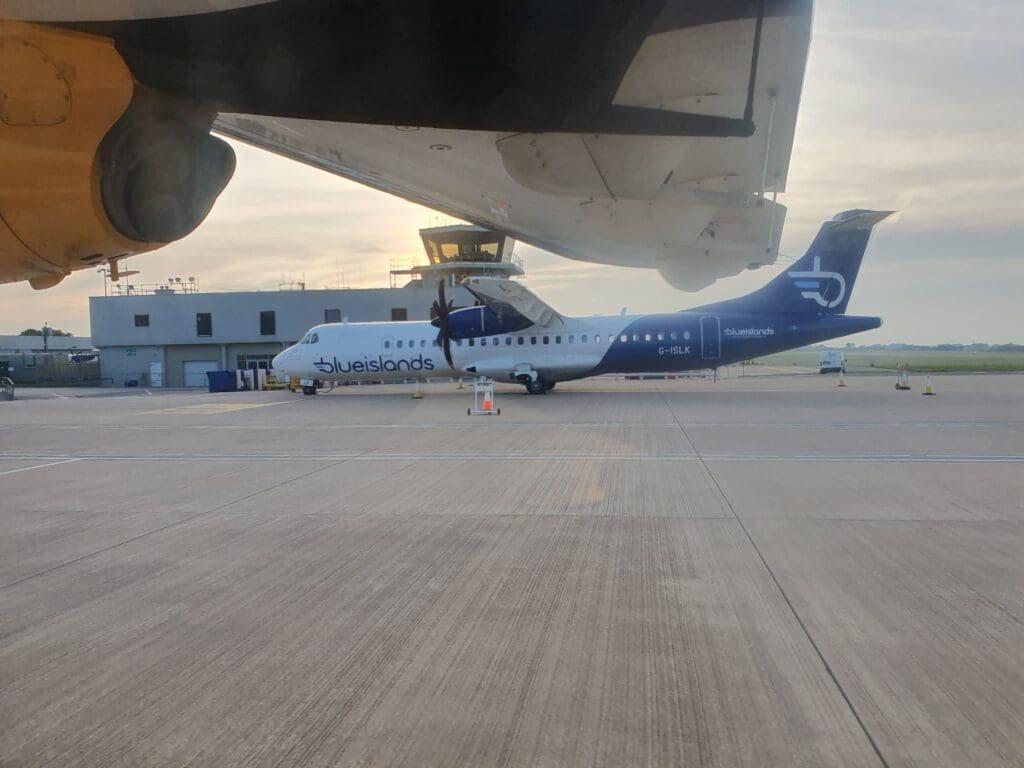
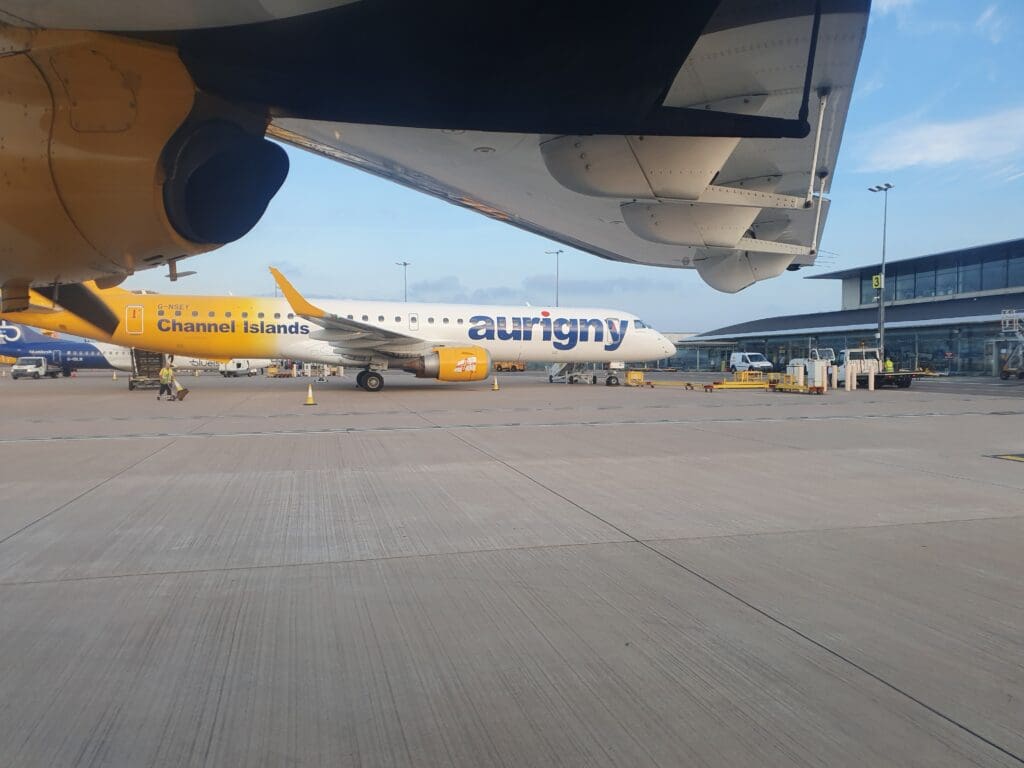
After savouring the last few moments of what was likely to be my last Dornier flight for some time, I clambered down from the aircraft and made a very short walk over to the terminal. That evening, the aircraft would make another round trip to Alderney before calling it a day, and several items of luggage could be seen waiting to be loaded into the aircraft. Once inside the terminal’s small yet busy baggage collection hall, there was some confusion as I tried to exit. Seeing as most passengers in the hall had arrived from London, I was stopped as I attempted to exit this and requested to show my Travel Tracker account. Despite informing the staff member that I had arrived from Alderney, I was still requested to show this before a neighbouring staff member who, overhearing this, intervened and sent me straight through. Following a quick walk through the customs area, I arrived in the small landside arrivals area and journeyed across to the bus stop in preparation for a quick bus ride to Saint Peter Port.

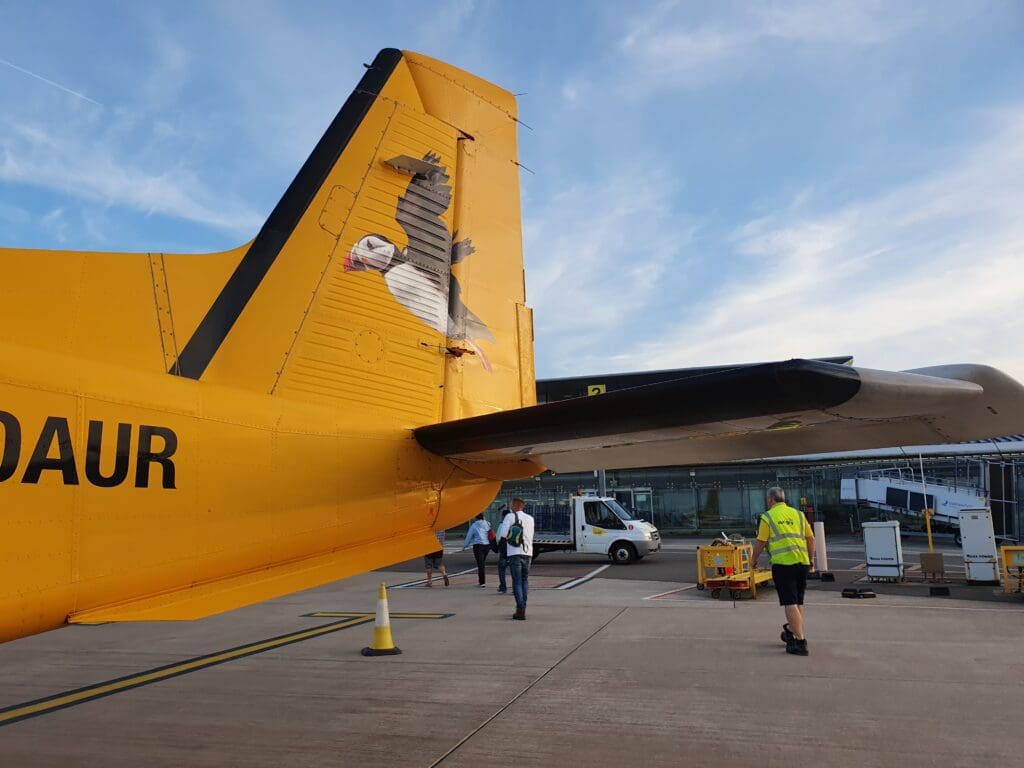
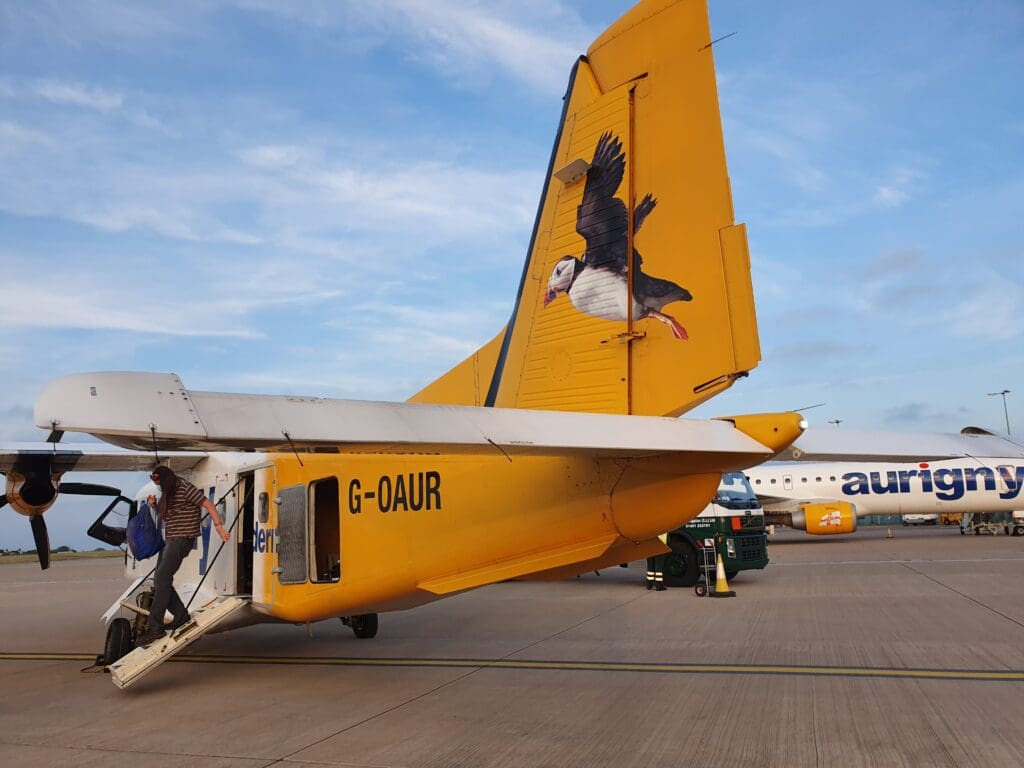
Conclusion
As an aviation enthusiast, I had a fantastic time sampling Aurigny’s Dornier 228s – these provided an experience significantly different from your typical scheduled Airbus or Boeing flight. All staff I interacted with in both Southampton and Alderney, as well as the pilots themselves, were all friendly and helpful, ultimately leaving me with a very positive first impression of Aurigny. Whilst Alderney Airport may not be the most modern in the world, it features a fairly novel terminal and I thoroughly enjoyed soaking up its unique atmosphere and exploring its quirks. However, I should note that those passengers not so easily entertained by the novelty of flying onboard a small aircraft to and from may have been left with a few complaints regarding the battered state of the older Dornier, and the apparent lack of soundproofing in the Dornier’s small cabin. That said, for an aviation enthusiast, neither of these proved to be an issue and I was left very pleased that I had finally made this trip – ticking off another item from my enthusiast’s bucket list.
